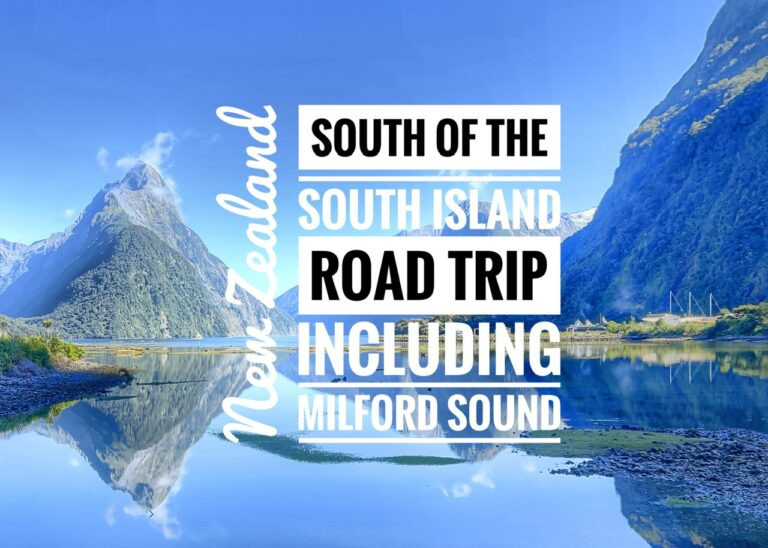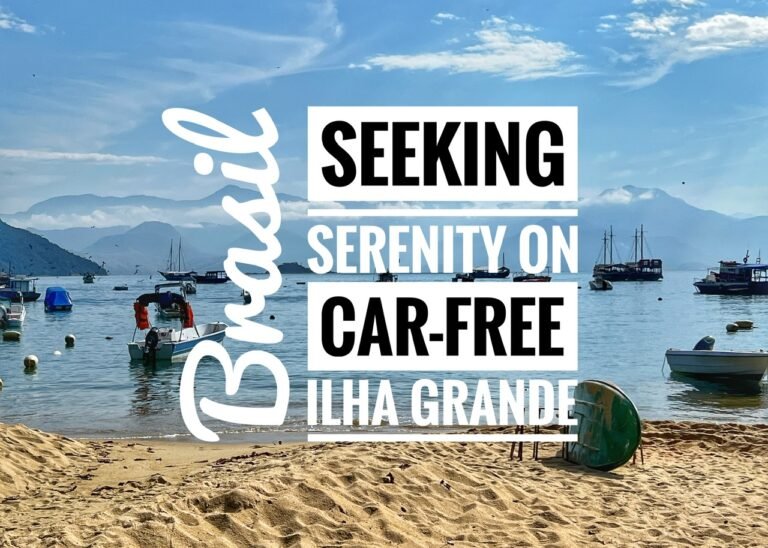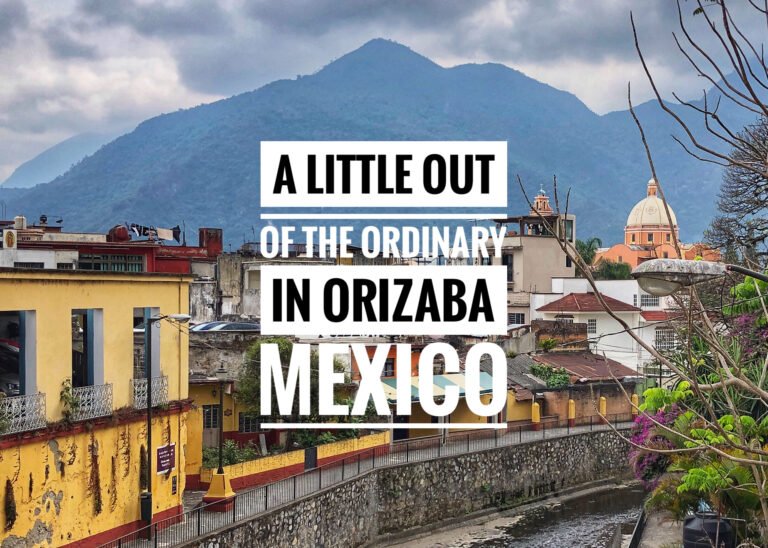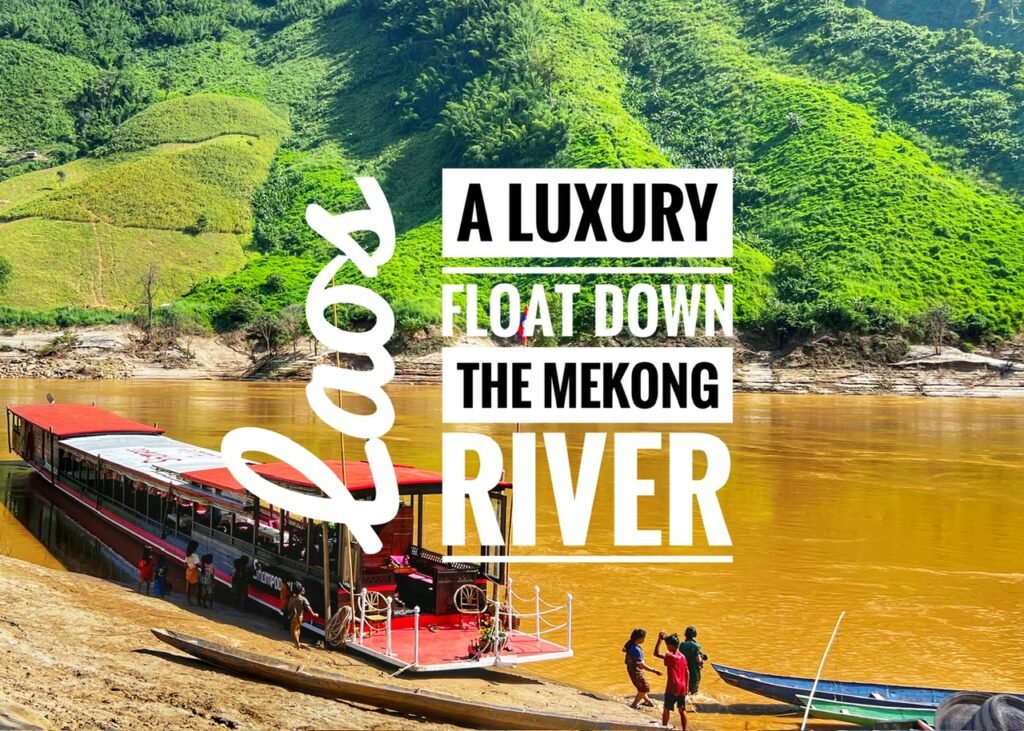
To the Thai/Laos Border

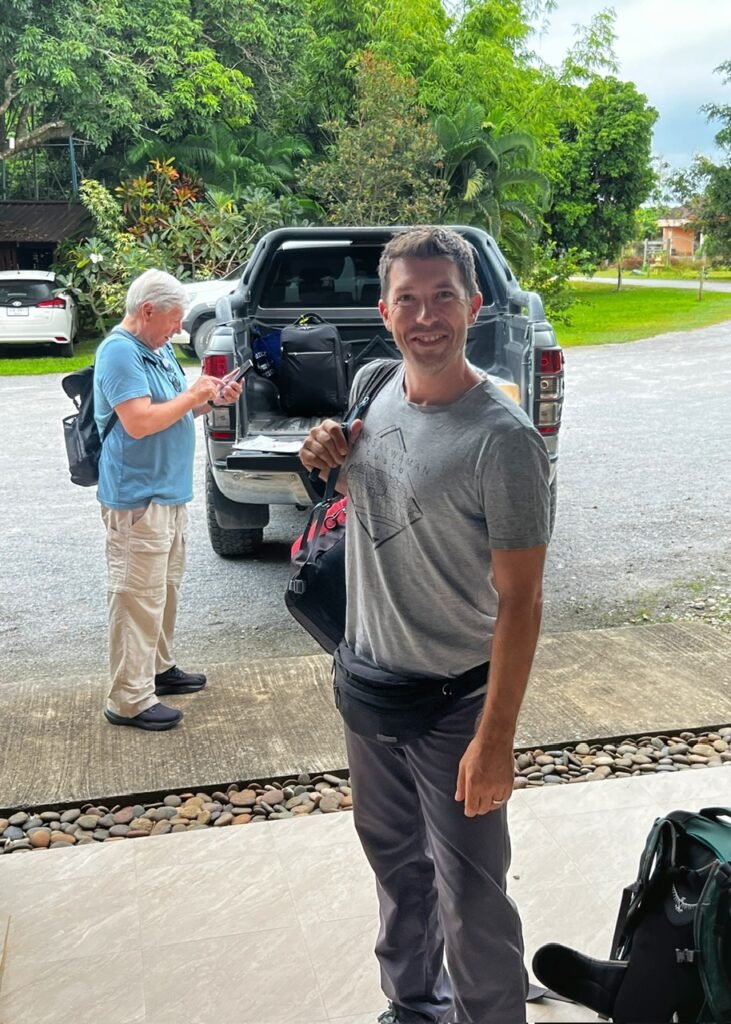
From Chiang Rai, we made our way to another Chiang…this one combined with a Khong…on the Thai/Laos border. This approximately two hour journey can be made by local bus for about $5/person or, in our case because the parents were in tow, far more on a private shuttle. 🤣 We chose to stay overnight at the border town in order to make our early departure into Laos much more fluid the next morning. At that time, we were escorted through the border by our taxi driver who was arranged by our hotel for 200 Thai Baht, or $6, which was a great deal considering he not only drove us there but helped us handle all the paperwork on the Thai side.
Then we were onward into the new country for us….Laos…where things would continue to be a bit uh, off-brand, for us as we traveled in a bit more luxury than we’re used to. This included our 10-passenger private vehicle that whisked us to the border town in bougie leather recliners. For the record, there were still tassels on the window shades which is practically the same as Mexican bolitas. But, instead of a Jesus there was a golden Buddha perched next to the driver.
The next morning, Greg awaited departure of our taxi in the form of an extended cab pick up truck that would take us the last 15 minutes to the Thai/Laos Friendship border.

Upon arriving, we first stamped out of Thailand, and then our driver baby-sitter shoved all the paperwork in our hands we needed to fill out for our Laos visa on arrivals. We were also told we would need passport-sized photos for our visa applications. We were ready with those but, unfortunately Larry and Grace, were not. However, a simple “fee” of about $1.50 each seemed to make that problem disappear. We then all loaded on a shuttle bus with lots of backpackers who looked more like our normal selves, and took a quick roll about two kilometers across the Mekong to the Laos border station.
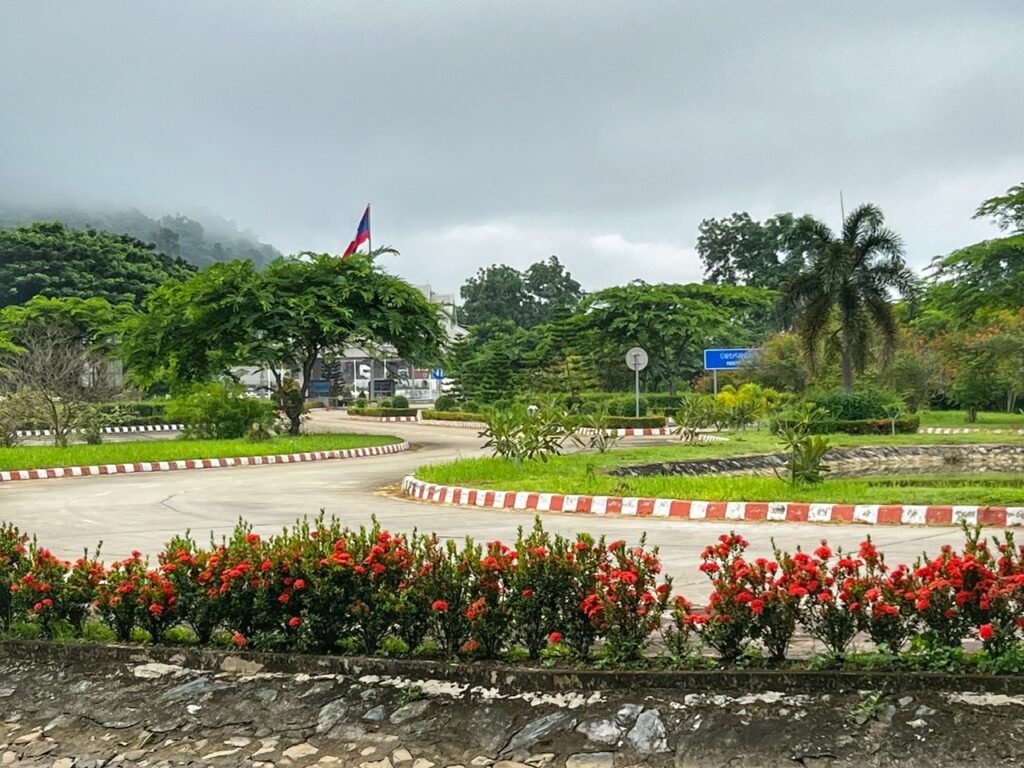
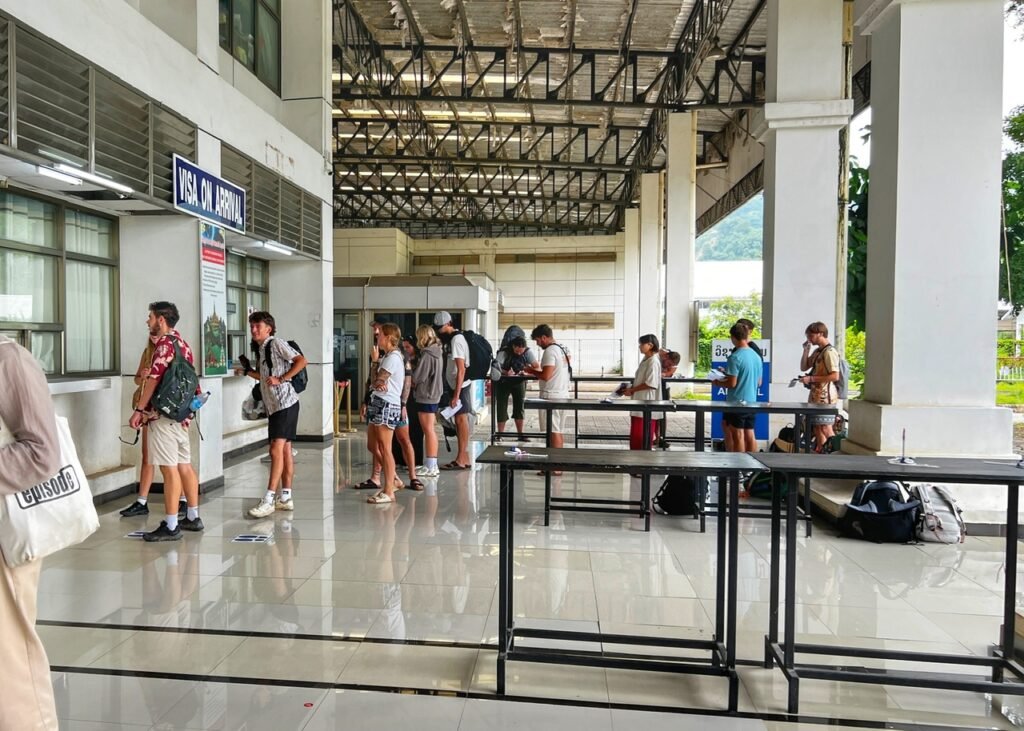
Welcome to Laos!! It was here we were greeted by Cha, an adorable little Laotian man who would be accompanying us for the next couple days all the way down the Mekong to Luang Prabang.
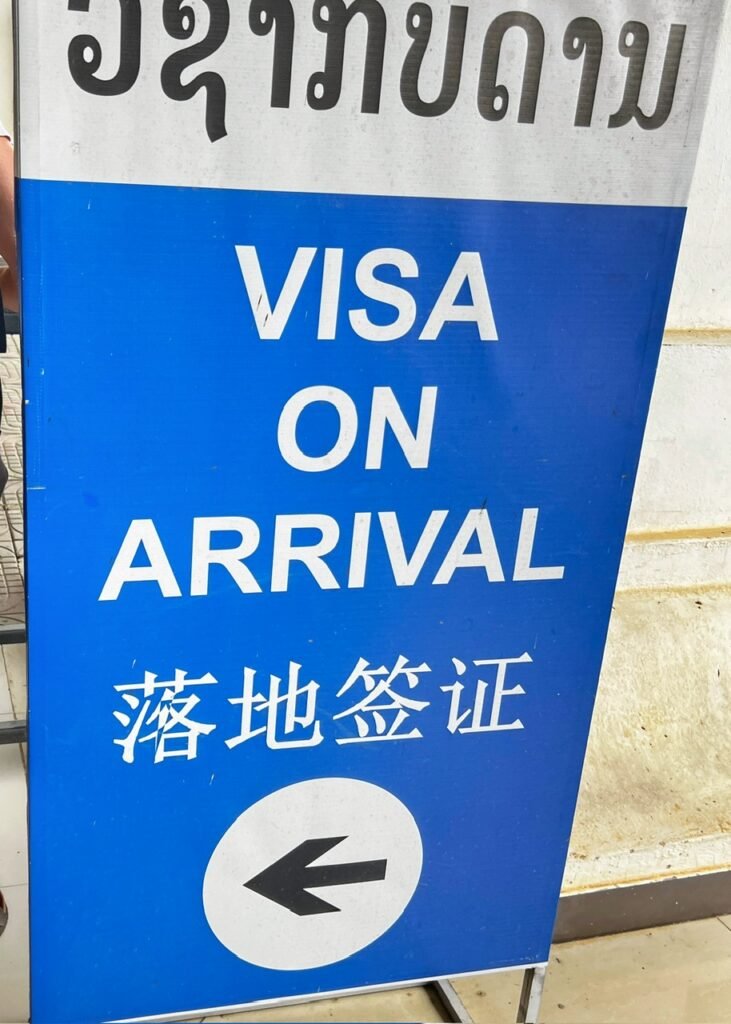
After a round of pleasantries, which included learning how to say hello (Sabaidee) and thank you very much (Kob Jai Lai Lai), he directed us to the right where a sign for “Visa on Arrival” could not be missed, and the same backpackers were scrambling to now fill out their forms on the Laos side. Ha. Bet they wish they had a babysitter! Ready to go, we were able to step up and be processed immediately.
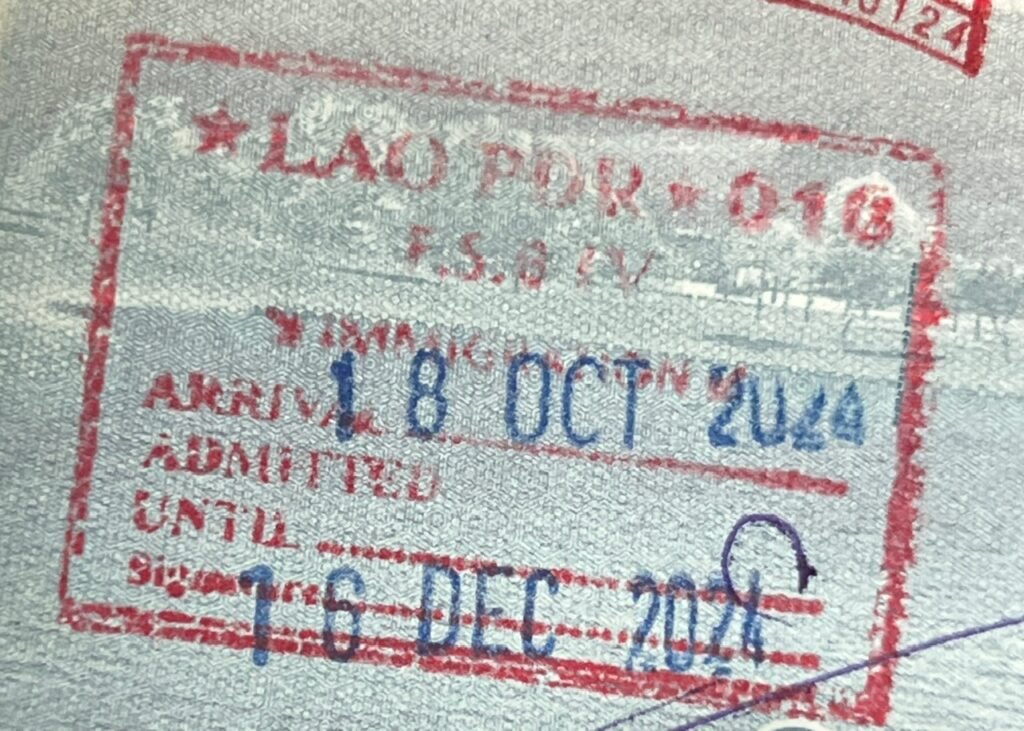
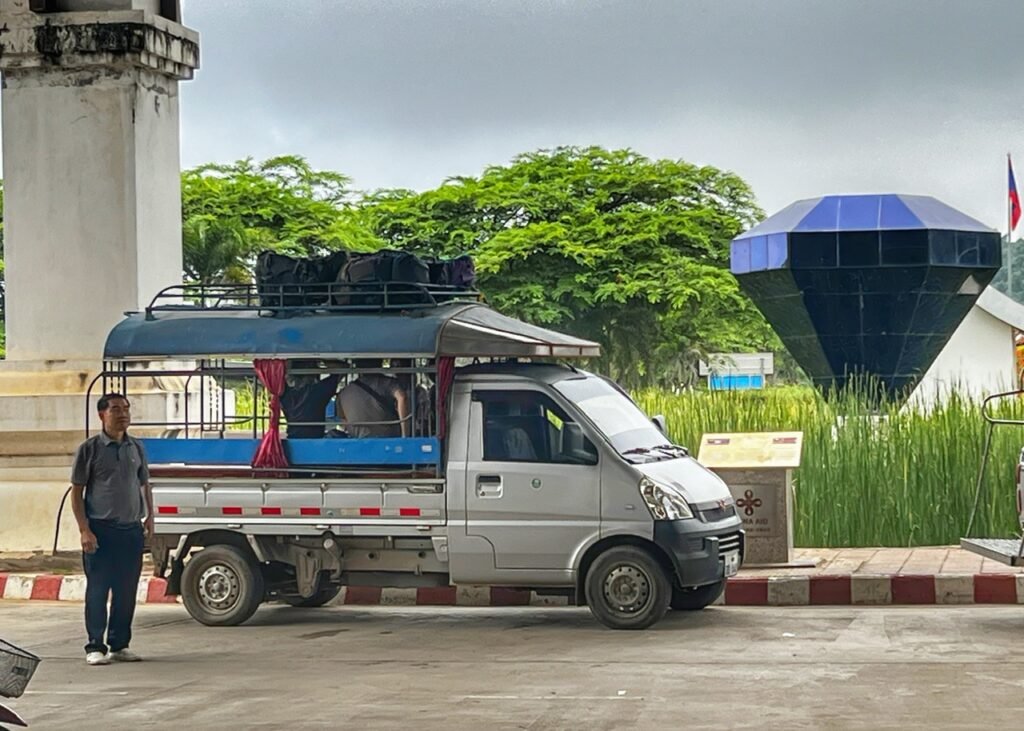
It was here we were surprisingly granted a 60 day visa, instead of the 30 we were expecting. This change went into effect in July, alongside Thailand’s, yet nobody seems to be talking about it.
After the visa on arrival and passport control desk, we went to the payment desk where Greg’s dad saved the day by whipping out the mandatory CRISPY USD in the form of $40/each. Otherwise, we would have had to pay an excess of about $10/each in Thai Baht. After the cashier ensured our notes were fried crispy enough, we were released into *real* Laos where we told Grace our ride awaited as we watched our backpacker buddies board the peasant wagon.
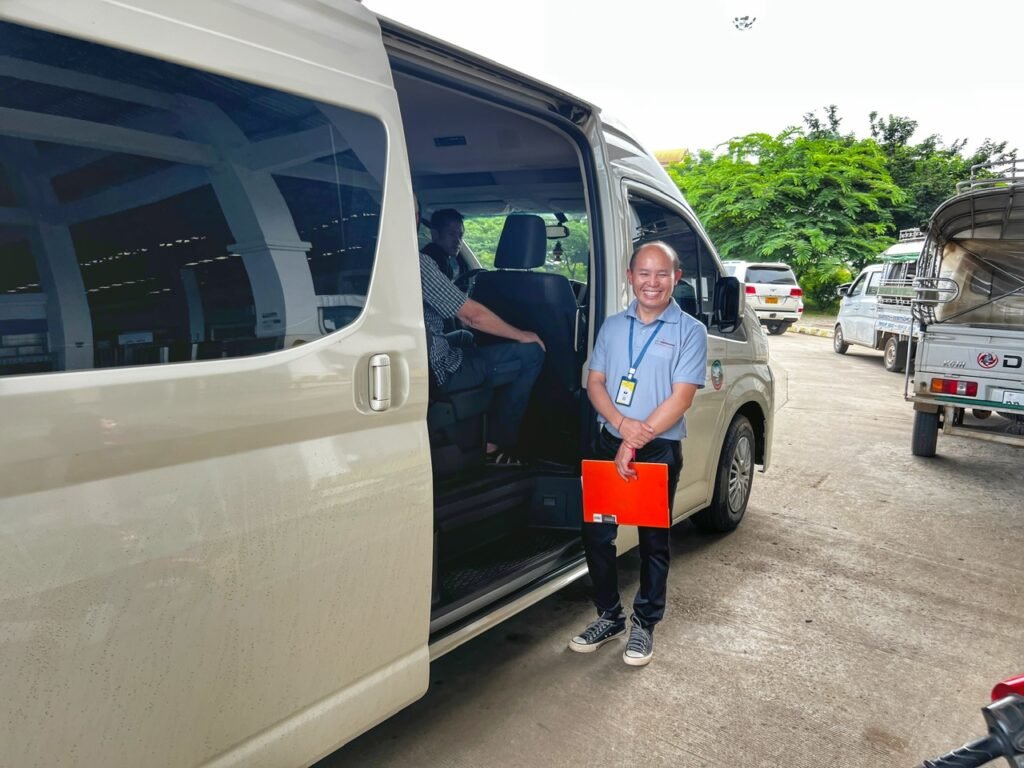
She didn’t buy it for a minute and shortly after, Cha pulled up in a veritable chariot to confirm her suspicions.
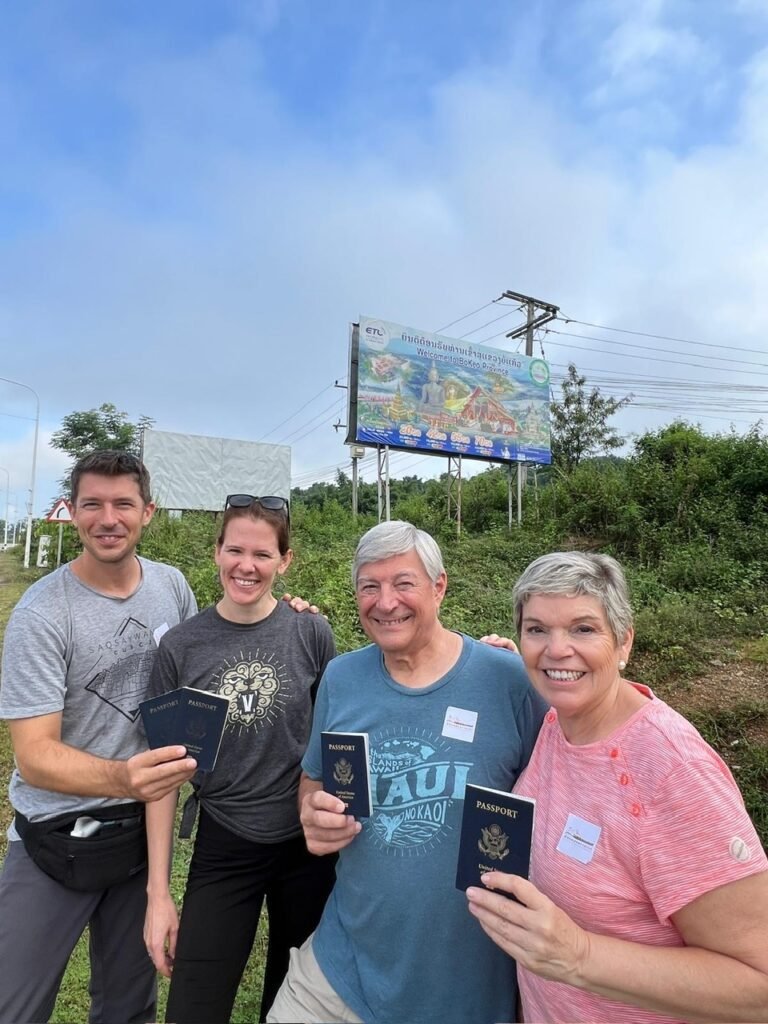
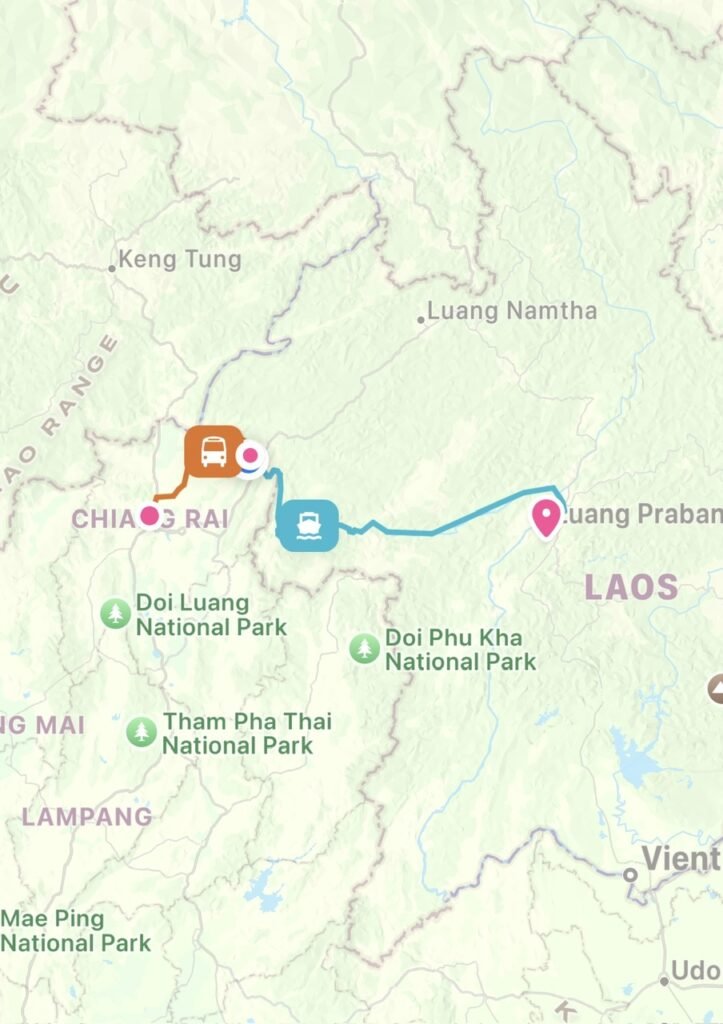
There was no “welcome to Laos” sign so we instead pulled over and got our photo in front of the provincial sign. This marked a milestone country at 75 for Mandy, 81 for Greg and 88 for Larry and Grace. Next stop: down the Mekong we go!
Day 1 Mekong Cruise
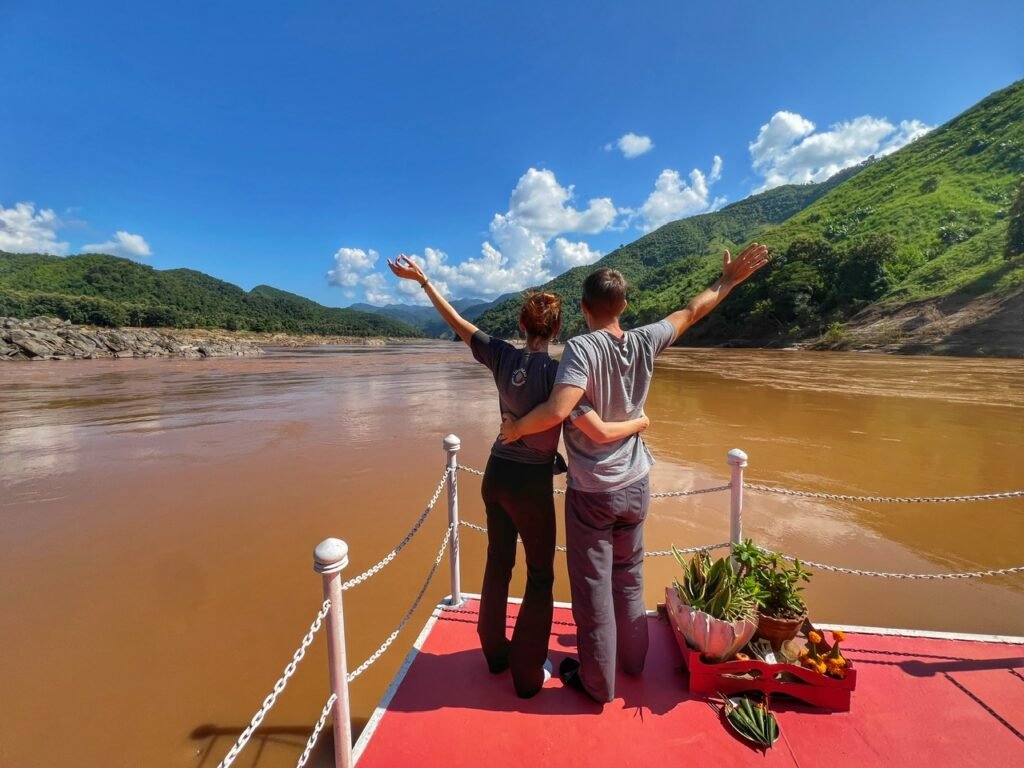
An item on our 60 by 60 list has long been to take a slow boat down the Mekong, so naturally this was the year to do it. However, when we mentioned it to Greg’s parents many months prior, they jumped at the chance to tag along on the condition that of course, we would take the two day/one night cruise down the river…their way. Wait. What?! We don’t have to snuggle up with 40 other backpackers and locals on a hard seat, with an icky toilet, and a ramen noodle lunch? Uh…yes please!
Their way involved booking with Shompoo Cruises, which we truly can’t recommend enough if you’ve got the cash, which was about $300/person including the food, hotel and “excursions”. Contrary to how it sounds, Shompoo does not mean hair washing, but “looking at the mountains” in the local language, which is a quite accurate assessment of the principle cruise activity.
It left from the Thai/Laos border near Huay Tai and landed in the colonial gem of Luang Prabang about 30 hours later, with an overnight stop in the river town of Pak Beng. It also involved three stops: two at local villages, one known for whisky making, and one to a Buddhist cave famous to the Laotian people for pilgrimages.
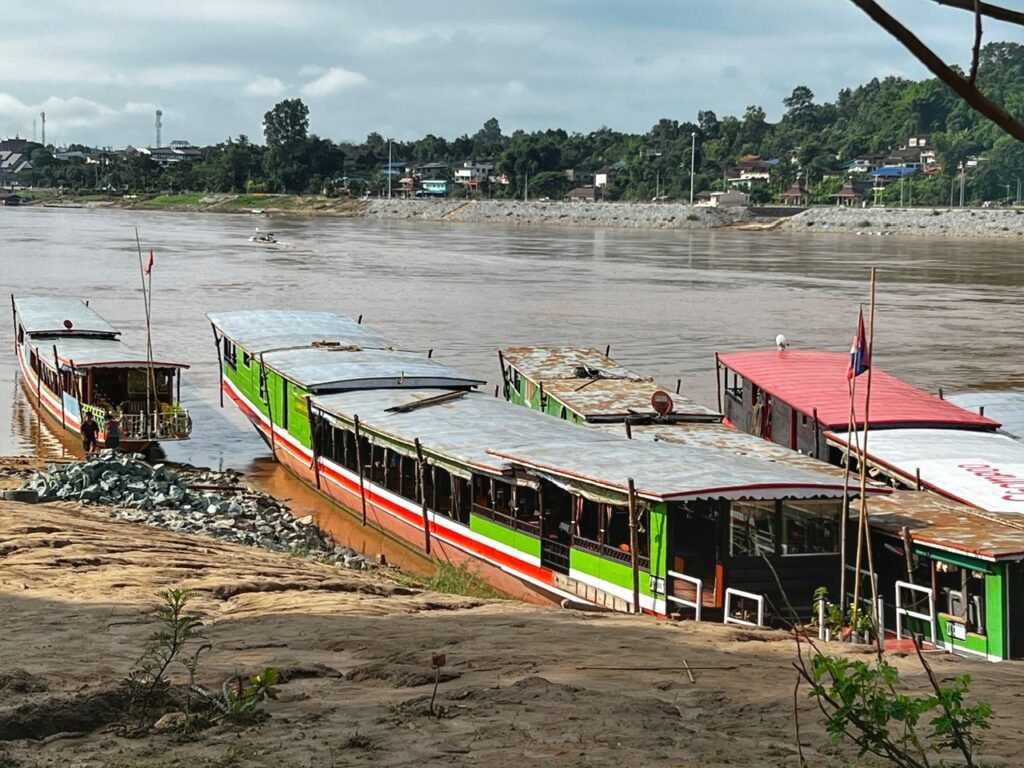

After getting stamped into Laos, we arrived to the boat dock about 15 minutes later at 9 a.m. where several long-tail boats were docked. No matter what your style of travel, almost all the boats are lengthy and narrow, which makes them well-suited for navigating the Mekong’s shallow and fast-moving waters. The boats are used for transport, fishing and tourism across Thailand, Laos and Cambodia. Here we had to walk down some slightly unsteady terrain to get on the boat, which the parents handled like a champ. Other than that, it was typically super easy to embark and disembark.
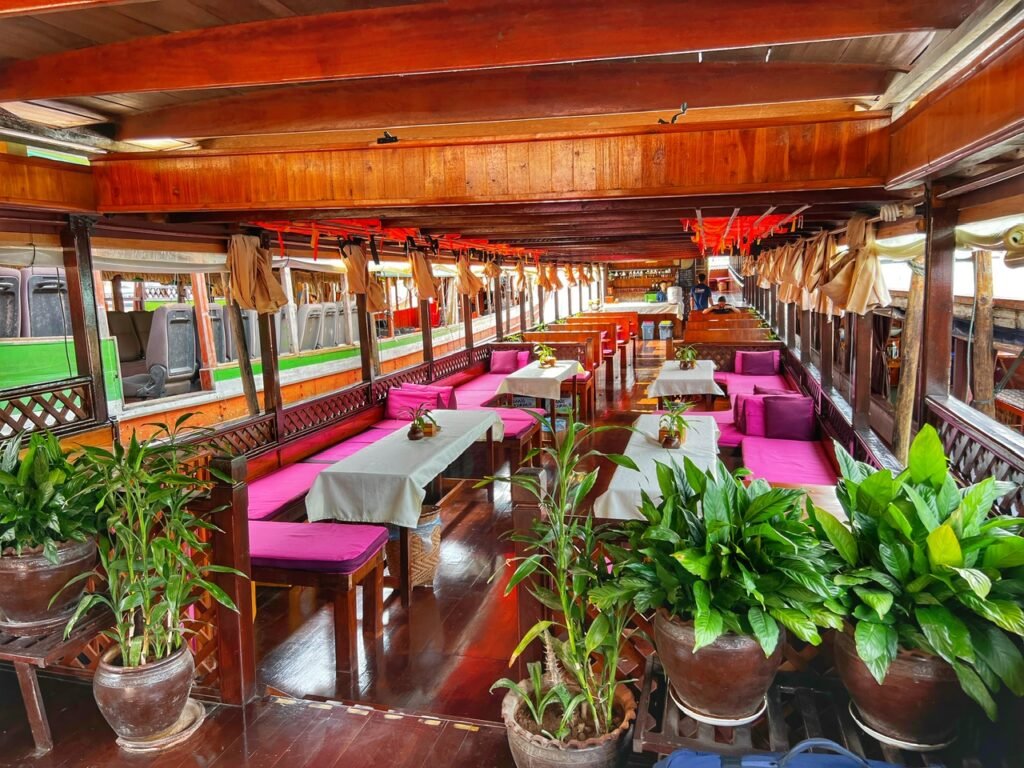
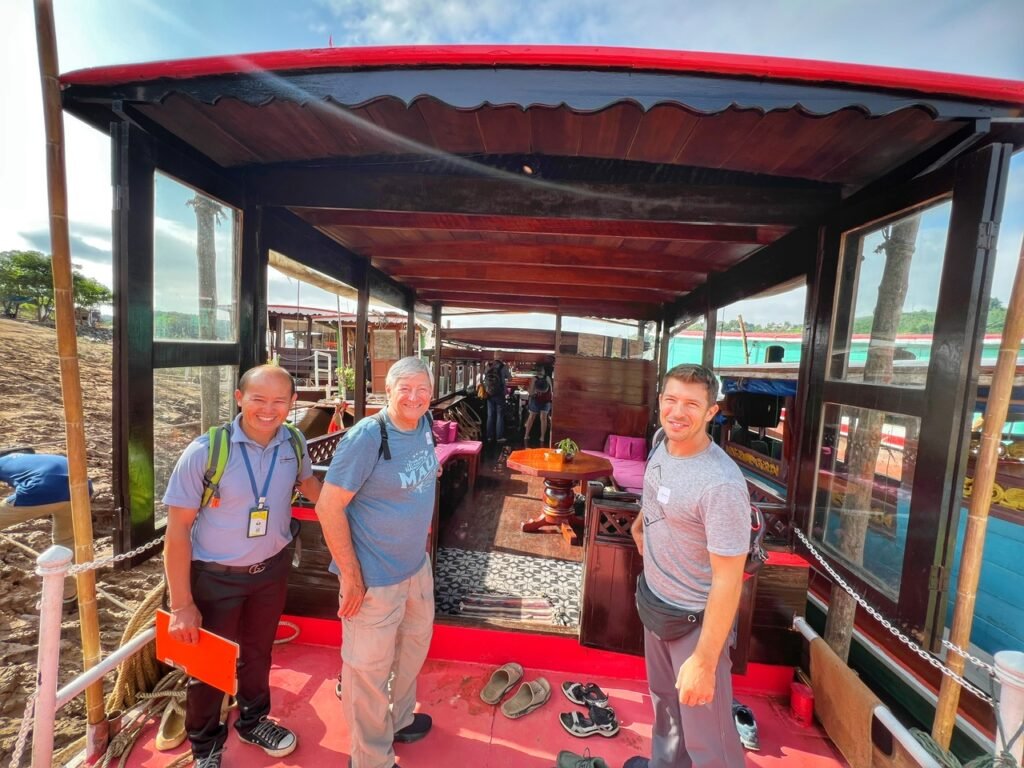
Once aboard, the boat itself is draped with dark traditional Laotian Rosewood iced with abundant pops of pink charm. Yes, for us, it was seriously bougie. And the unexpected bonus? On a boat that holds 32 people, it was all ours, other than the staff, two other German tourists, and two additional French ladies on the second day. Thank you, shoulder season!! Greg with his dad and our amazing guide, Cha, boarding the boat where of course, there were no shoes allowed!
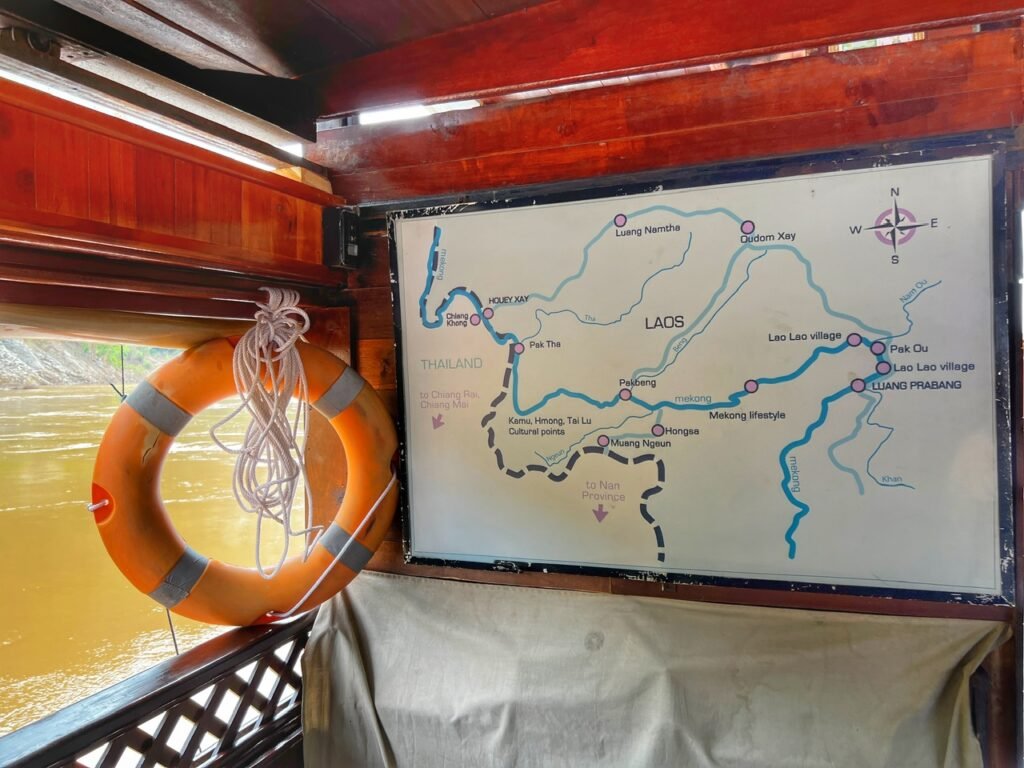

After the staff made sure we all had a coffee or tea in hand, Cha sat us down for our safety and informational briefing. Thanks to the low numbers, we each had about eight life preservers to our name, so we felt pretty protected.
Our route through western Laos would teeter alongside the Thai border for the first bit and then abruptly veered east as it continued down the Mekong through Laos. The first day we traveled 134 kilometers, and the second, 161 kilometers. Of course, we only floated down a very small chunk of it. In its entirety, the Mekong River is the 12th longest in the world at 4350 kilometers (2703 miles) and one of the most significant in Asia flowing through six countries including China (Tibet), Myanmar (Burma), Laos, Thailand, Cambodia and spitting out south of Ho Chi Minh City in Vietnam.
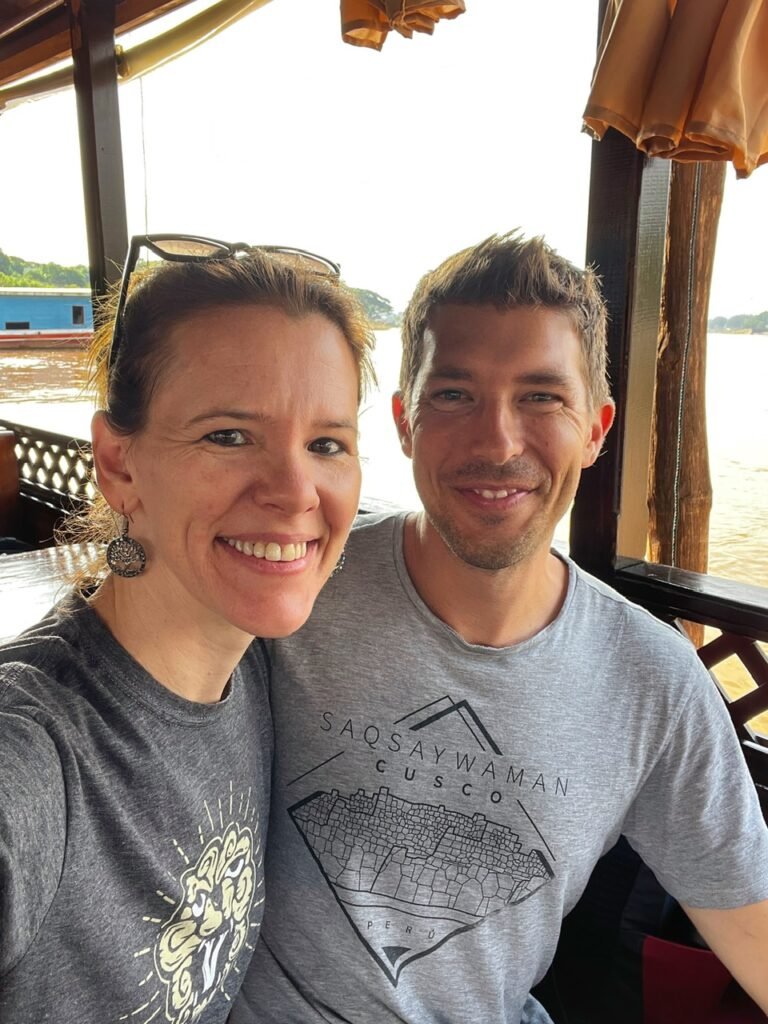
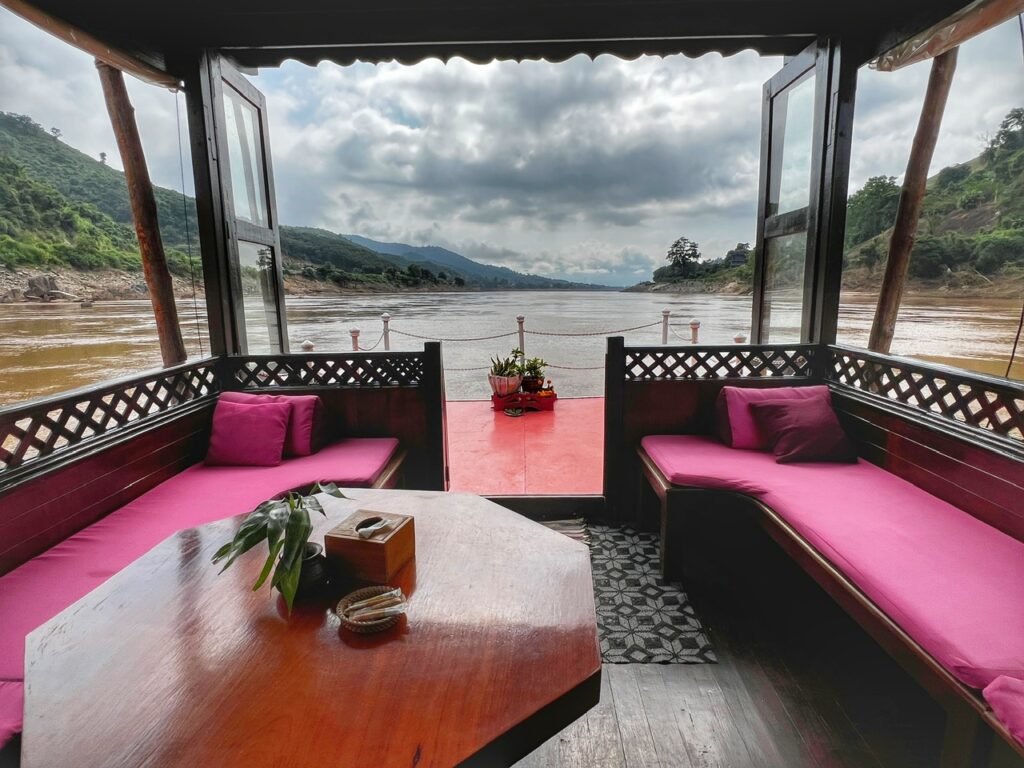
Settling in for the ride, and testing out all the various places for obligatory no-internet relaxation.
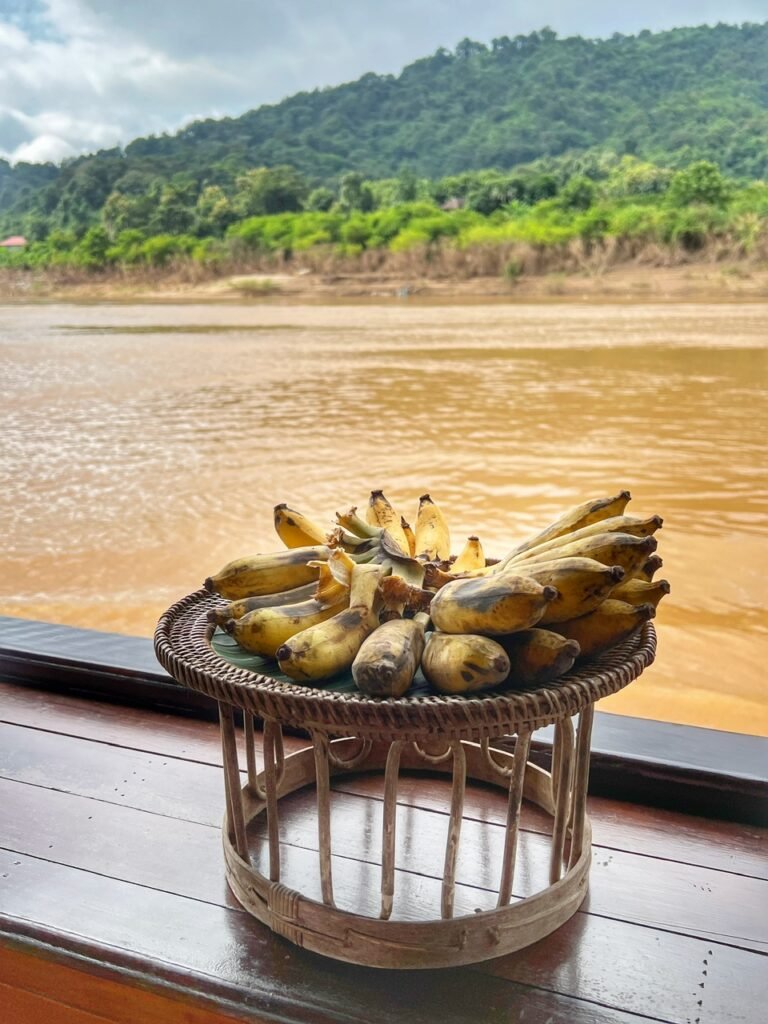

On board, cutie patootie bananas were provided as well as endless supply of complementary water, coffee and tea. There was also a full bar, which had very reasonable beer, cocktail, and wine prices.

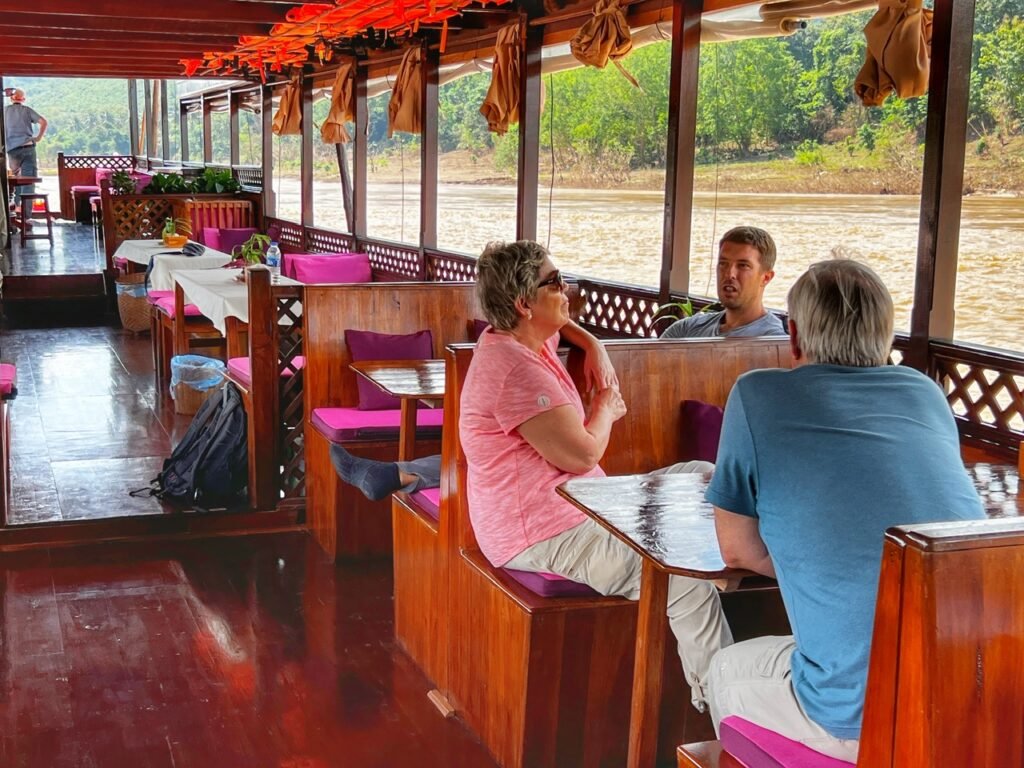
Once we toured the boat, we had nothing to do but sit and watch the world go by. It was a lot like our float down the Amazon last year in this regard, but we didn’t have to worry about our hammock banging into your neighbor’s hammock and then trying to remember how to say “sorry” in Portuguese. It also gave us a great opportunity to catch up with the family.
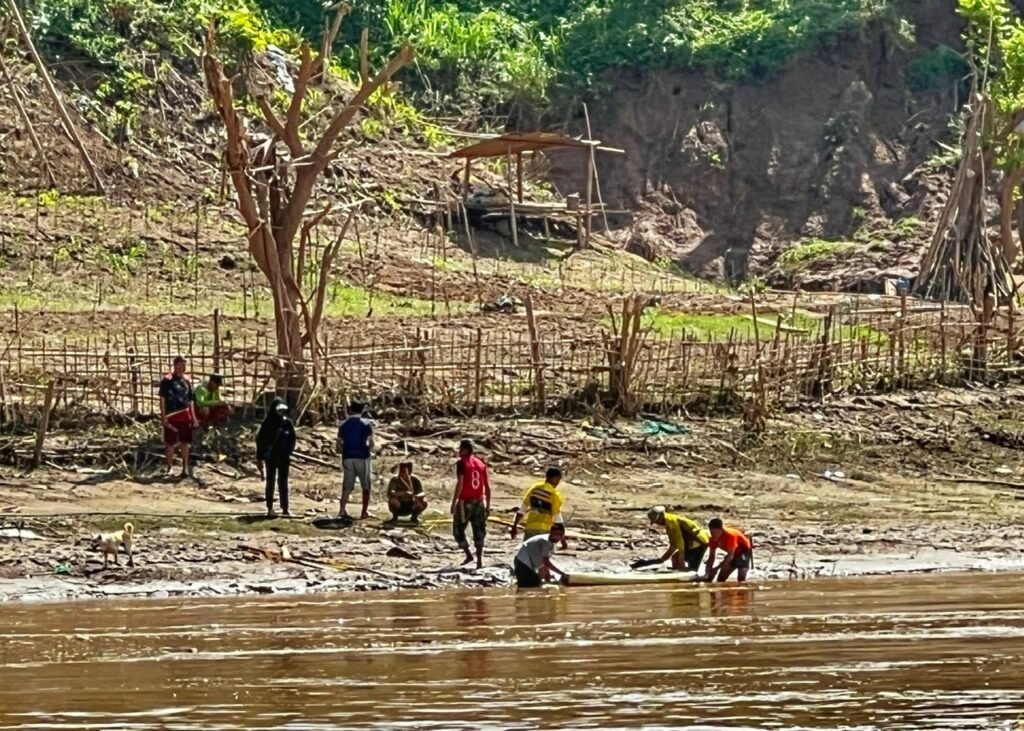
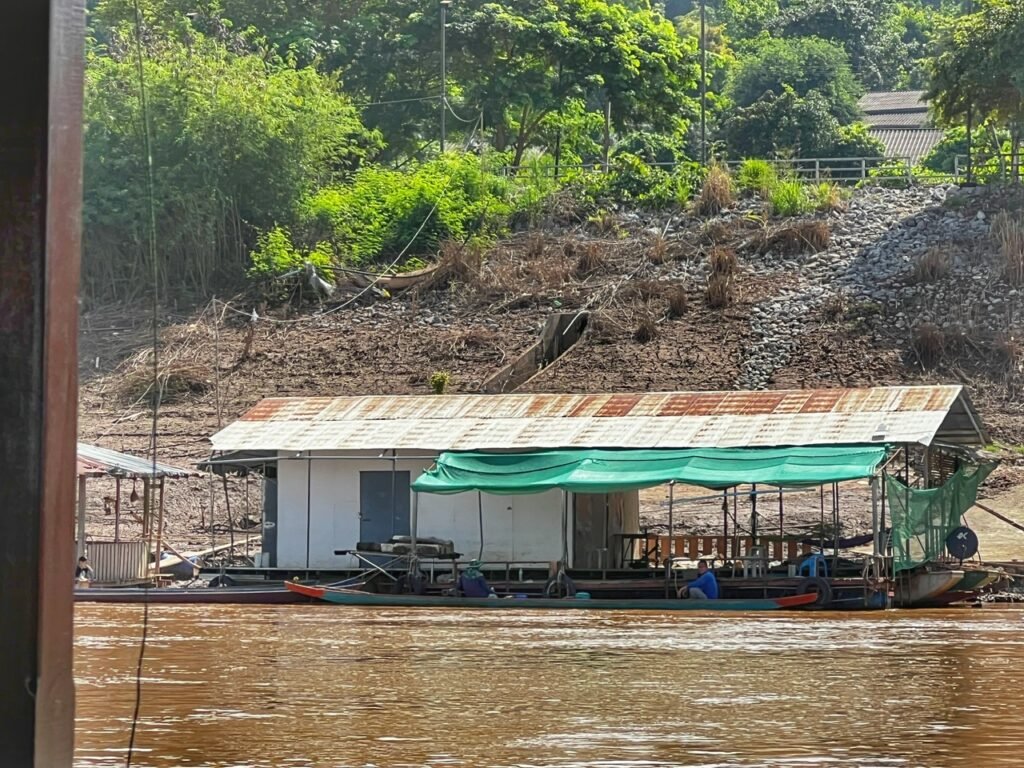
But the daily river activities of the people were quite similar, which of course included fishing, as well as interestingly, gold panning.
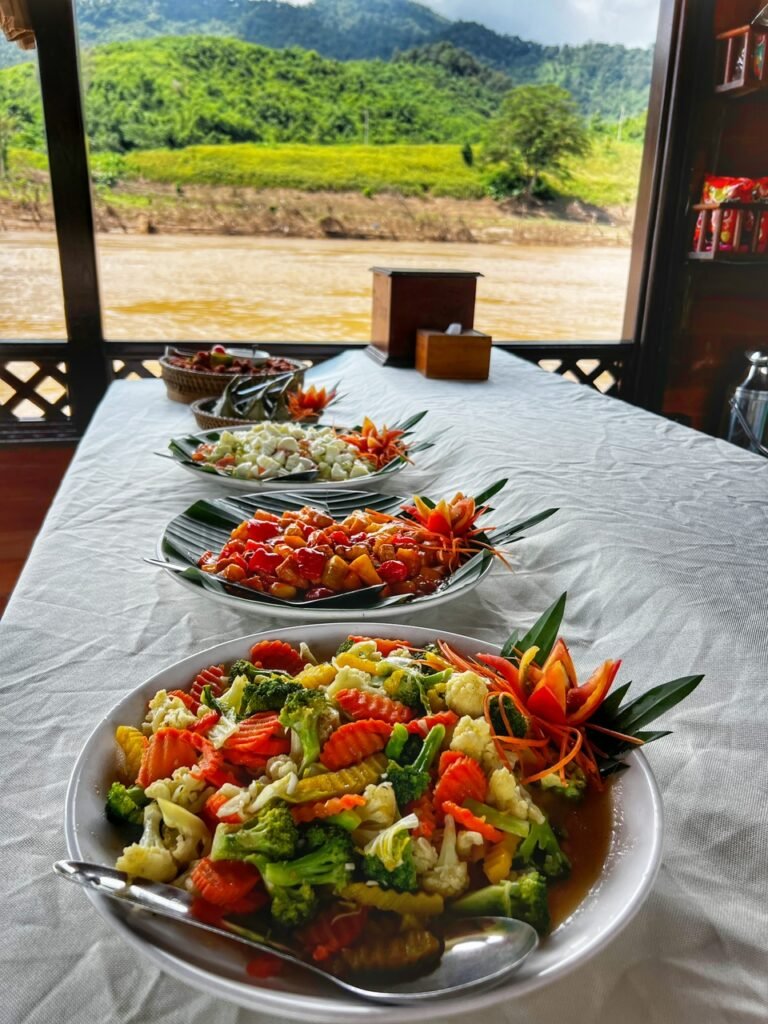
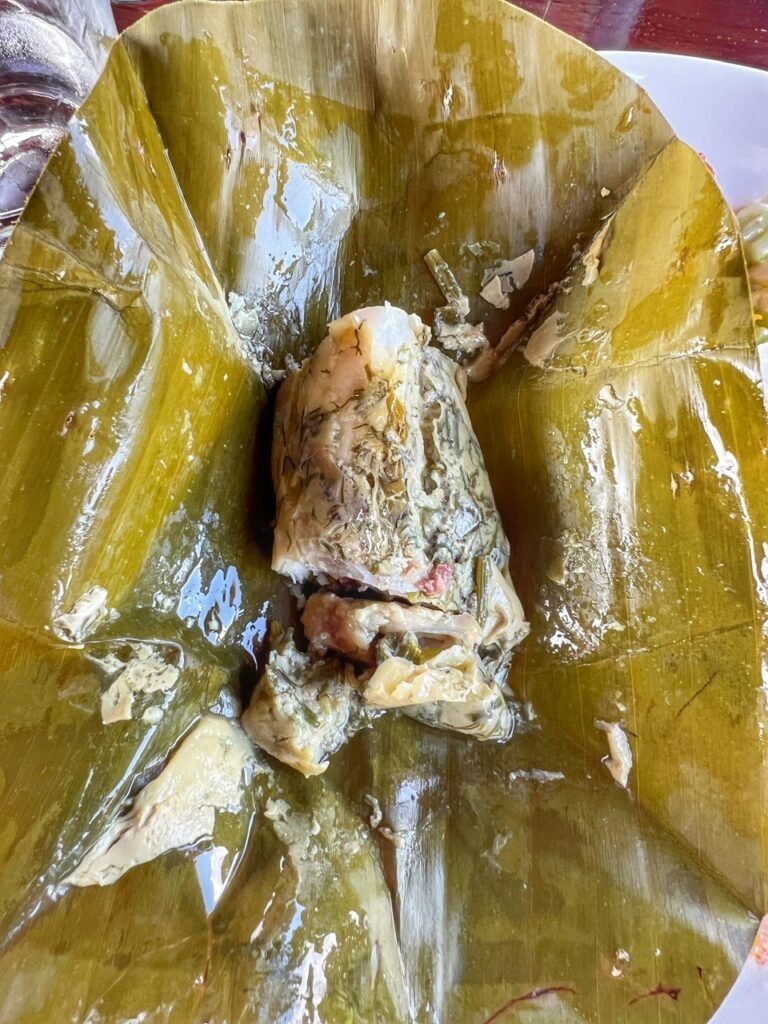
Lunch was served about 11:45 and was advertised as “traditional Laotian” but felt a lot like the American version of Chinese food to us. In other words…it was delicious.
They also offered a river fish steamed in banana leaf with herbs, which felt more Cambodian to us, so clearly Laos is influenced from many different directions in its cuisine.

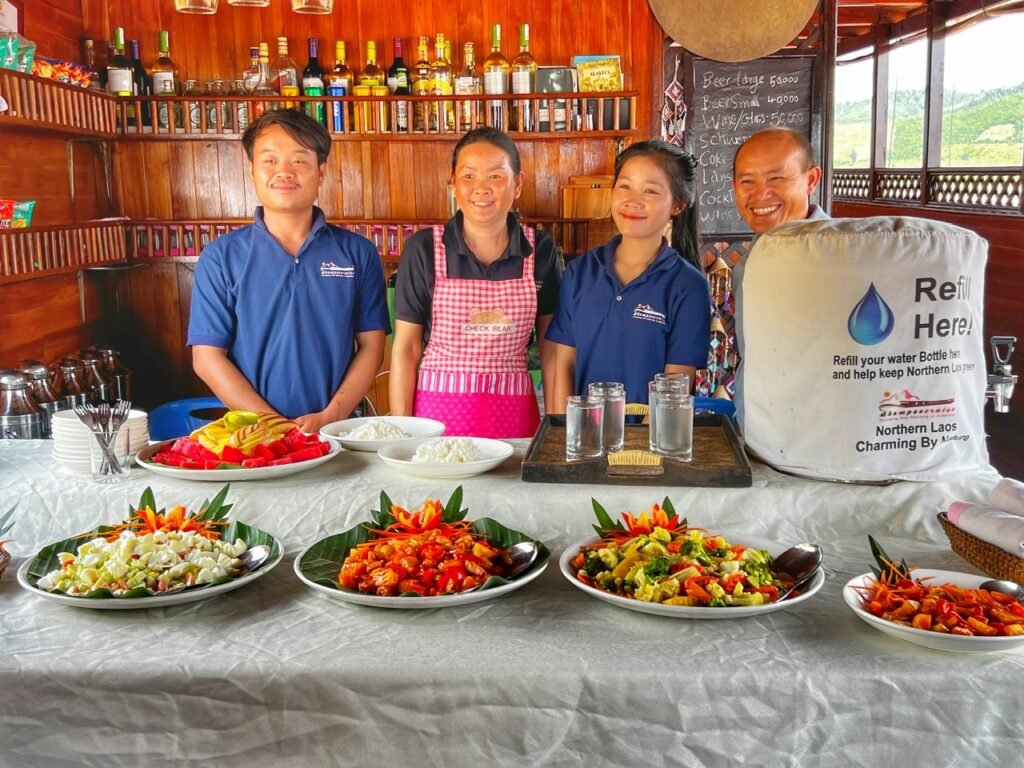
Stir-fried veggies, and sweet and sour pork. They also made a dish just for us without the pork, which was really sweet.
The hard-working staff, who, minus our guide, were the family of the boat’s captain, who personally owned the boat.

Trying to teach the over-ambitious parents the art of slow travel! They regularly exhaust us when we travel with them.


While watching the world go by, we were able to observe the other two ways to travel the Mekong….the fast boat, which costs around $20 and takes 6-7 hours. Despite the good value, spending that amount of time aboard a bumpy and noisy ride with no sun protection sounds dreadful.
The other option is the slow boat, backpacker style, which costs about $15 person and takes two days with a stop in Pak Beng (the same village we stopped in). This price does not include accommodation or meals. There is a further, far more luxurious and expensive option which involves a multiple day cruise with onboard cabins that will spit you on in Vietnam, which might need to be a 70+ to do item for us when we become more reliant on things like cruising.
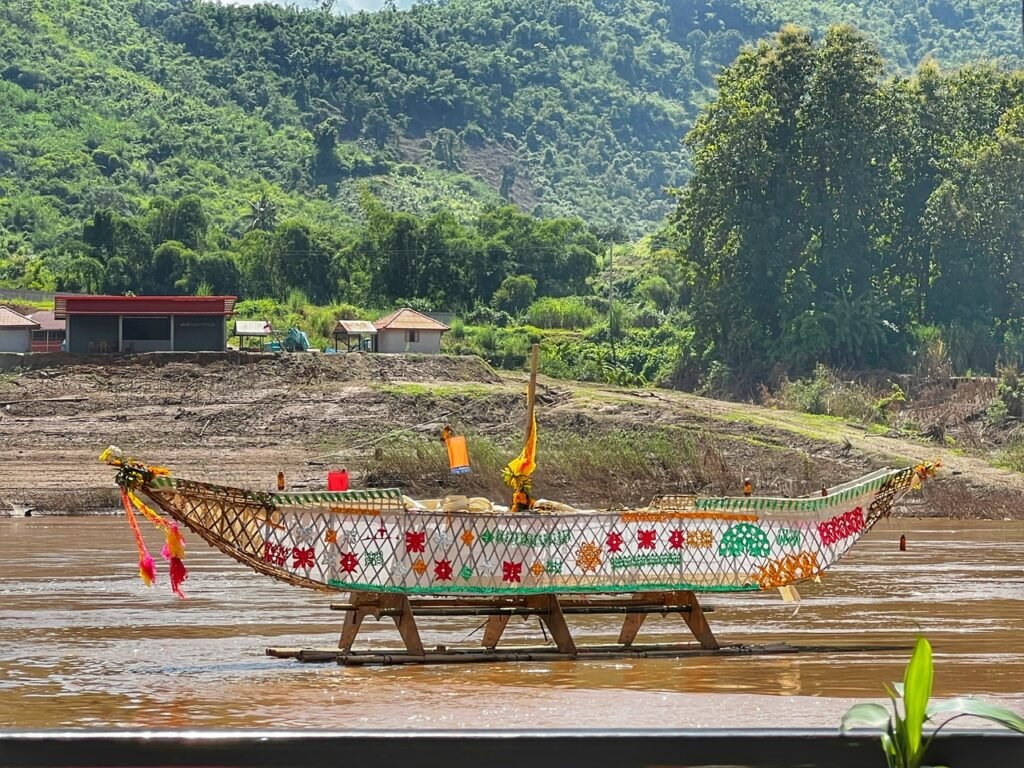
We also saw multiple decorative boats that served as offerings during the Big Buddha day celebrations. Uh. They’re pretty, but not sure we can support that kind of obvious littering of the river. That boat has gotta land somewhere and I’m pretty sure Buddha isn’t actually picking it up.
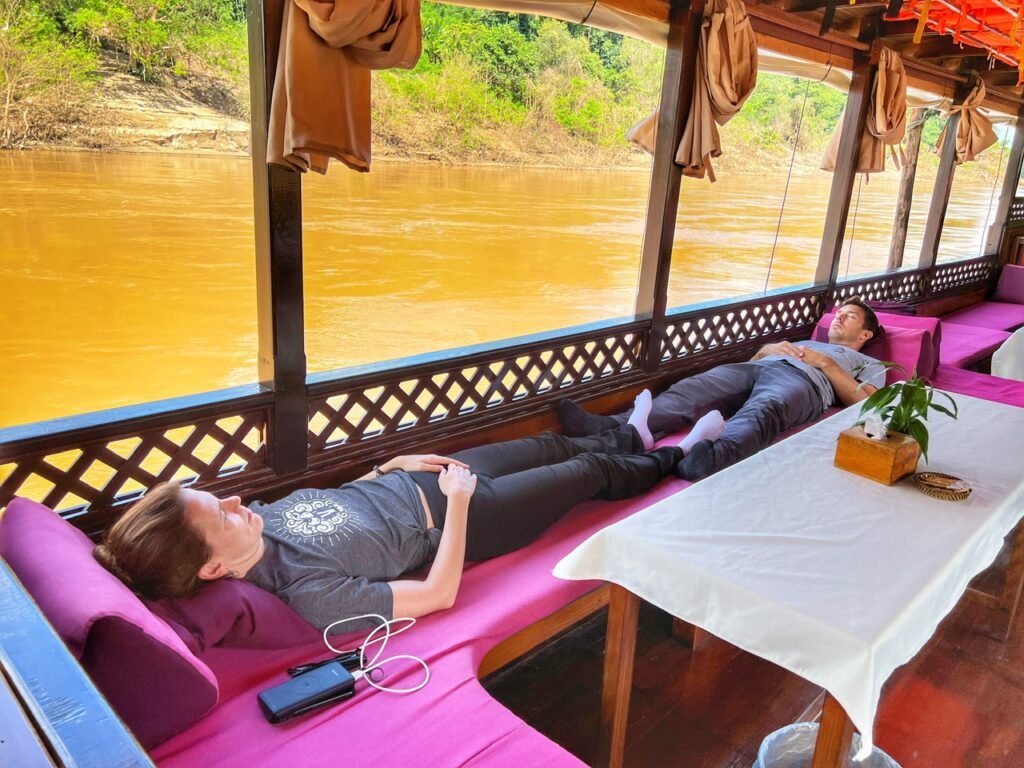
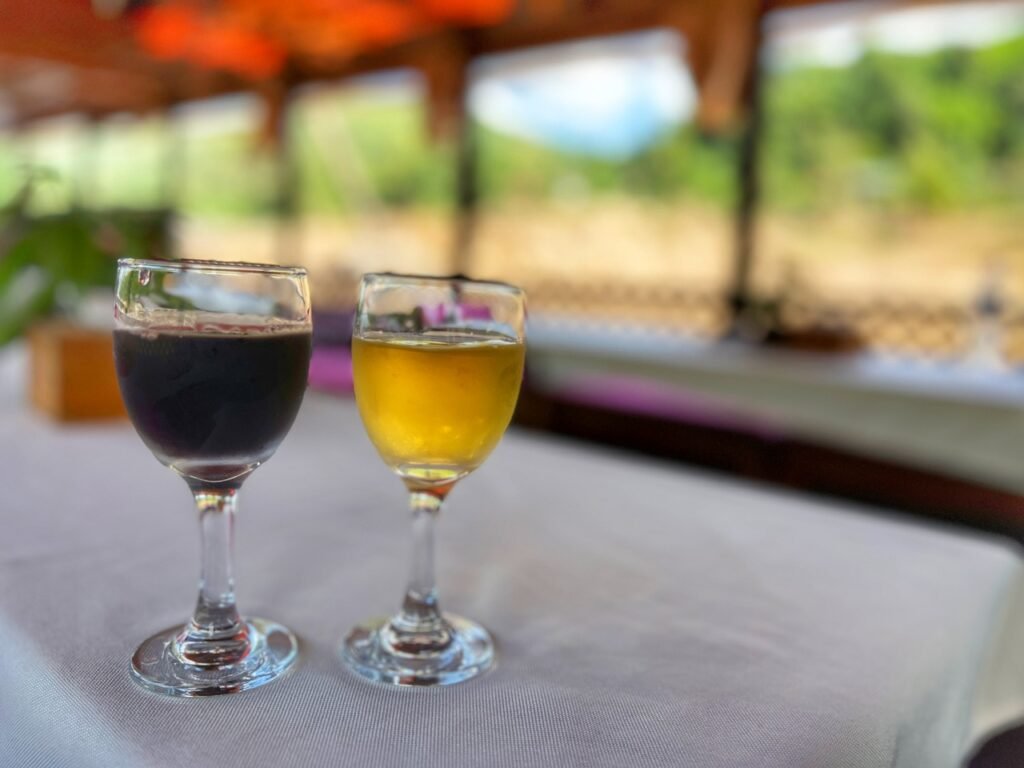
After “sightseeing,” it was time to do our favorite onboard activity…stretch out for a foot to foot nap and let the motion of the Mekong do its thing, followed by a glass of (very) cheap wine for $2 a glass. Yes, we switched to beer after one glass.
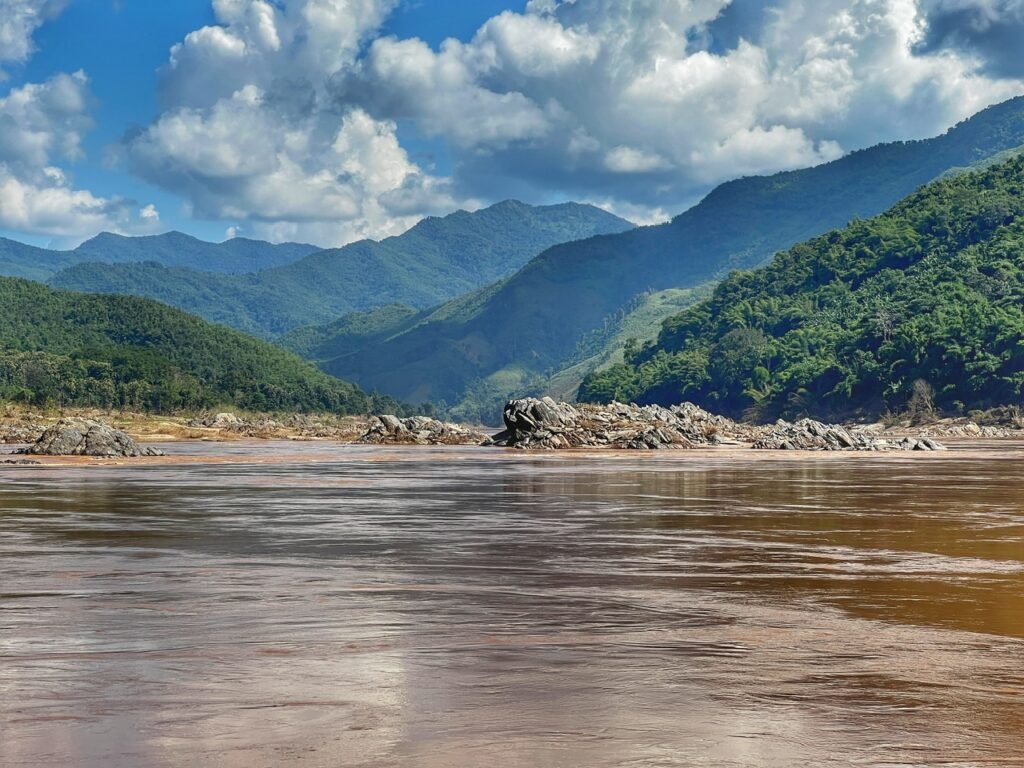

The further east we went, the more beautiful the views would get. The Chases do Laos, 2024!
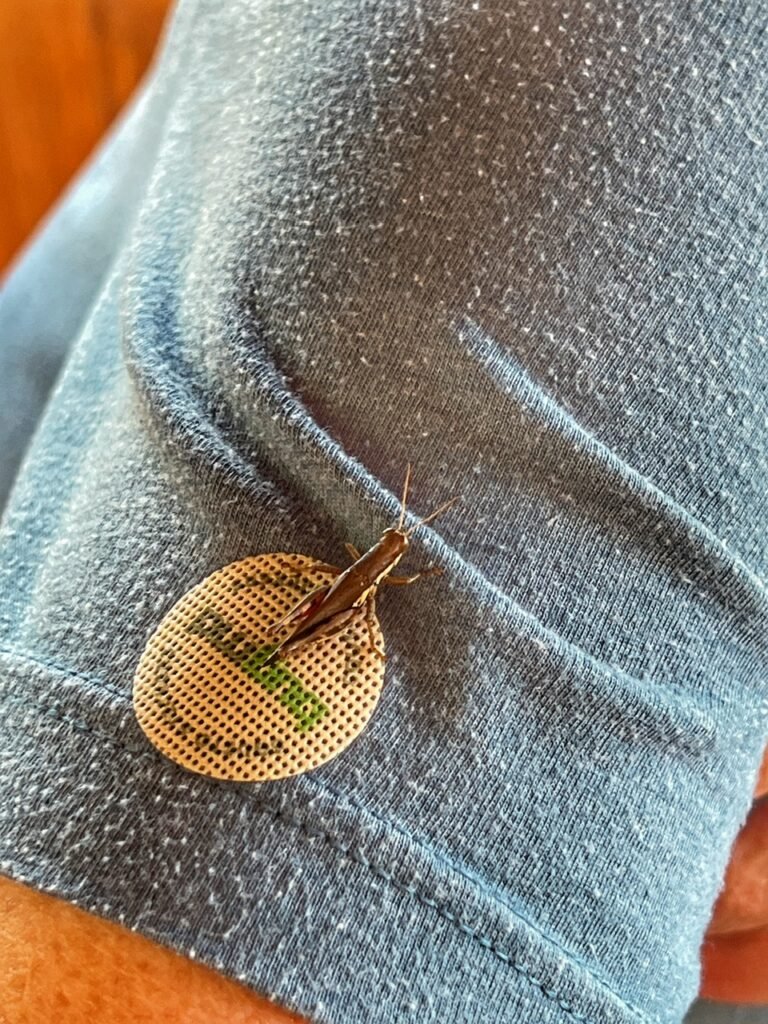
Preparing for our first stop, Grace slapped anti-mosquito stickers all over our clothes. This bug seems to think it tasted good, which is probably not a great sign.
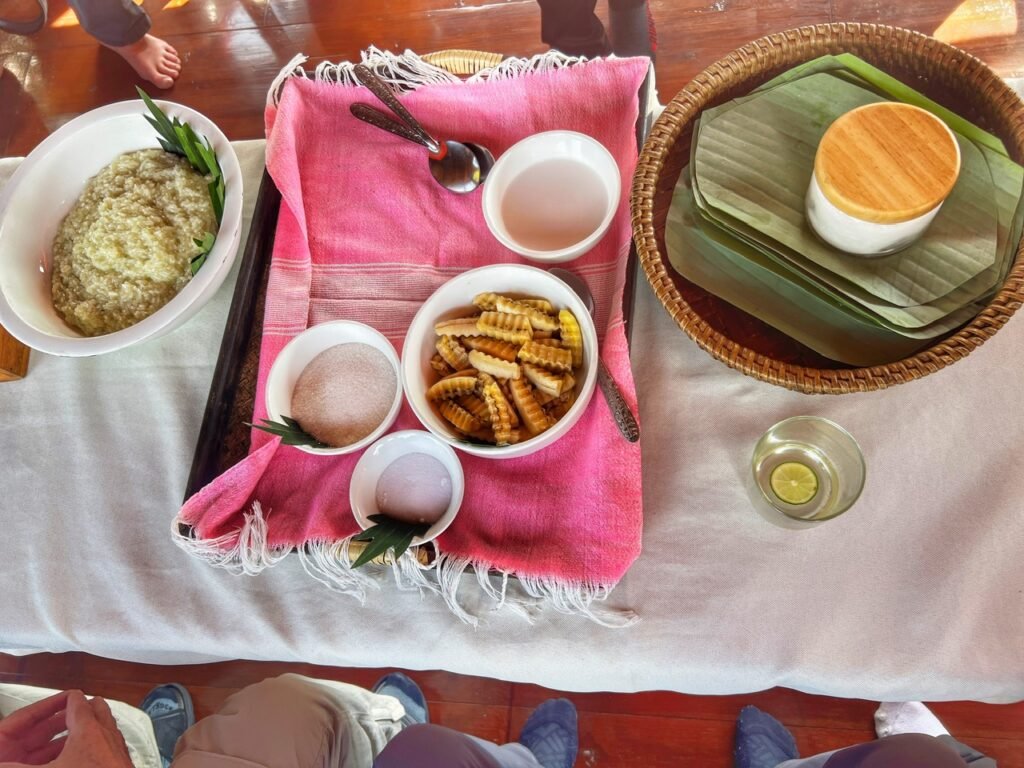
After our stop, the staff awarded us with refreshing drinks and cold cloths. Now we know what $300 gets you…but wow, that felt nice. They then brought us trays of food and informed us we’d be making our own sticky rice dessert.
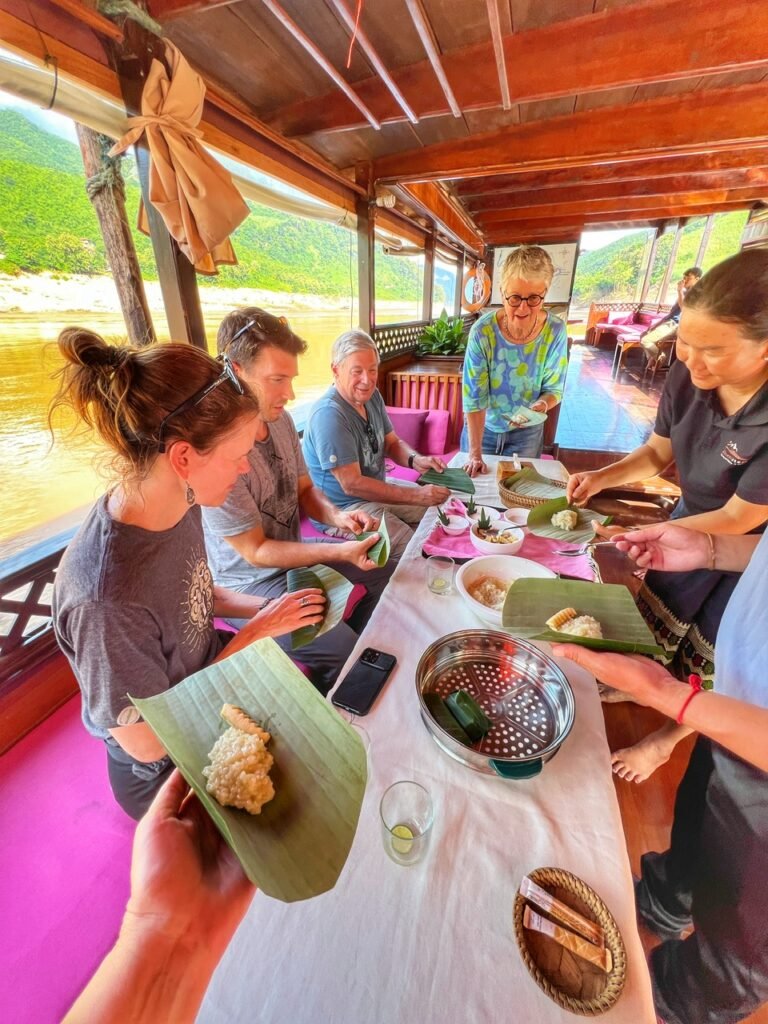

This involved placing a blob of coconut sticky rice inside a banana leaf, topping it with sweetened bananas, and learning to roll it correctly, which was quite an art, so it could be steamed to perfection for a future treat.
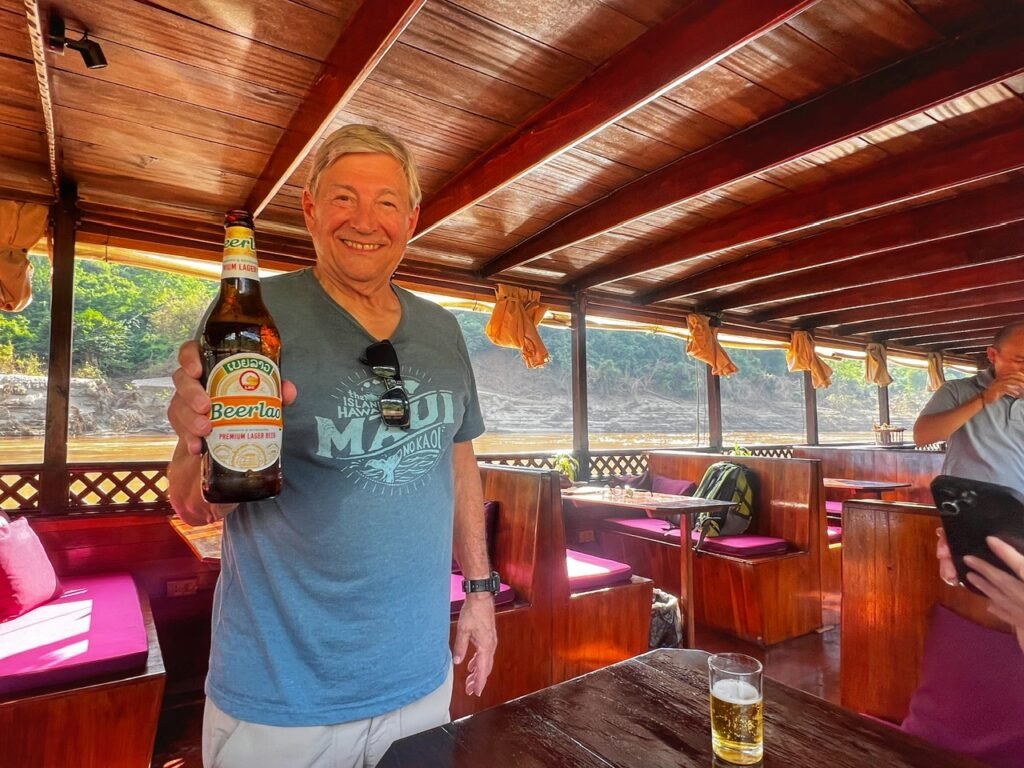
Washing down our coconut sticky rice with a $2 BeerLao, the next lager we would befriend as we continued weaving our way through SE Asia….
Stop One: Ban Kang Lae (A Kamu Village)
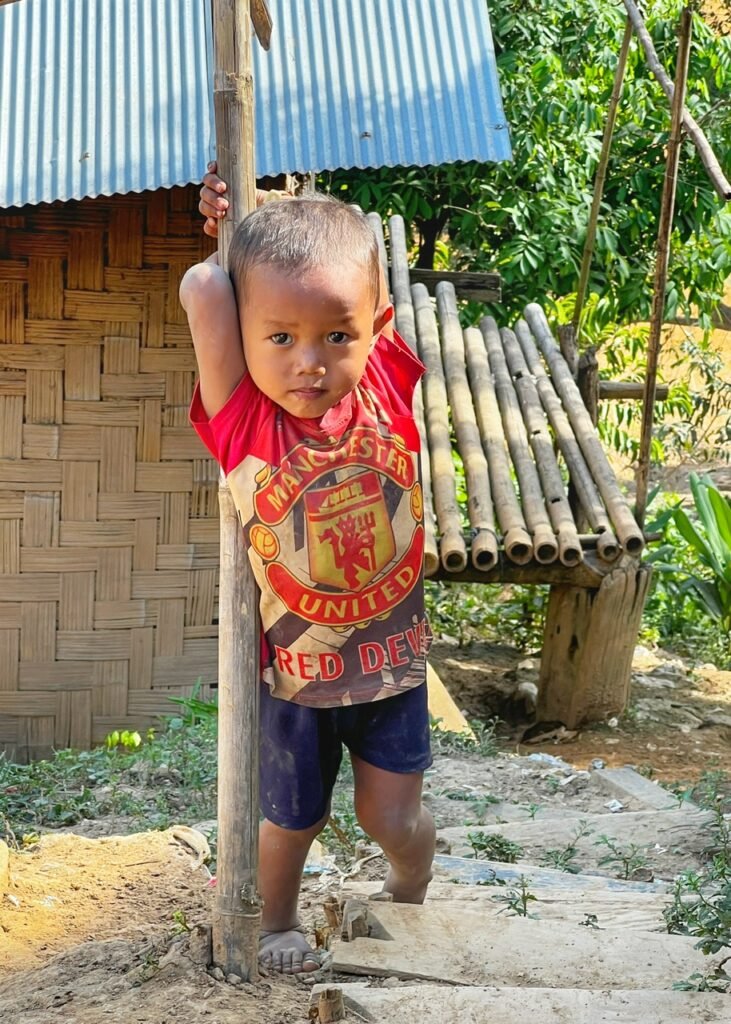
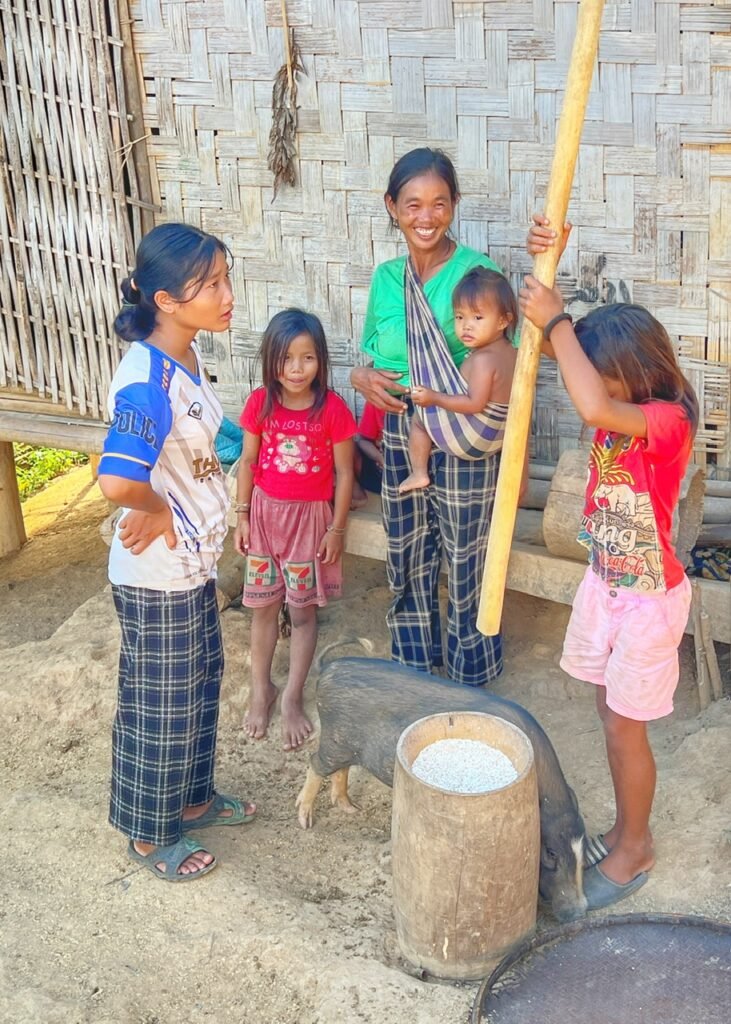
Our first and only stop on the first day of our Mekong cruise was at Ban Kang Lae, a Kamu village which hosts about 60 families and receives regular donations through cruise fees, as well as on the spot offerings through donation boxes. This river village is utterly in the middle of nowhere, with no roads, electricity or plumbing, and an experience we never could have gotten otherwise. Our stop involved a 40-minute walk through the quite rugged community to meet with the local people and learn about their lives and customs.
The Kamu, also known as the Khmu, are an indigenous ethnic group primarily found in Laos. They are one of the largest ethnic minority groups in the country, especially in the northern regions. Like in many similar villages we’ve been to, many children were wearing soiled and English-plastered clothing which we’re guessing may have come as donations.
A group of villagers showed us part of rice processing which involves using a mortar and pestle to separate the grain from the husk. Unsurprisingly, the Khmu traditionally rely on subsistence farming, especially slash-and-burn agriculture, growing rice, corn, and other crops. Fishing and hunting also play a part in their livelihood. Sadly, fishing is getting more challenging for the locals due to an overwhelming amount of commercial fishing and dams being built on the river.
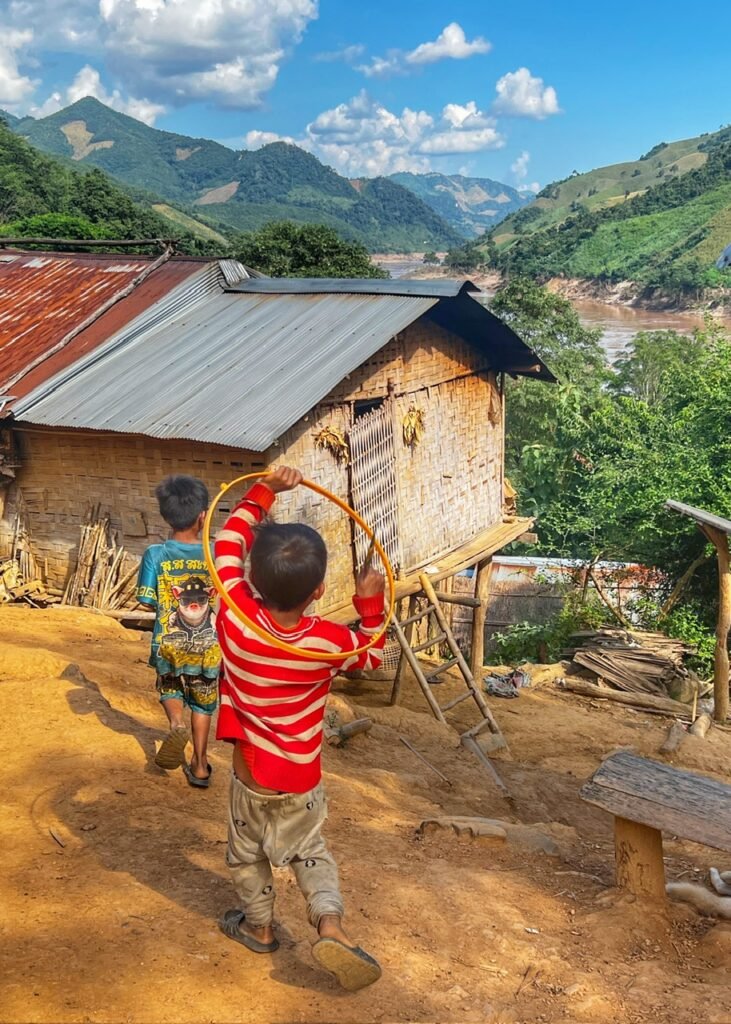
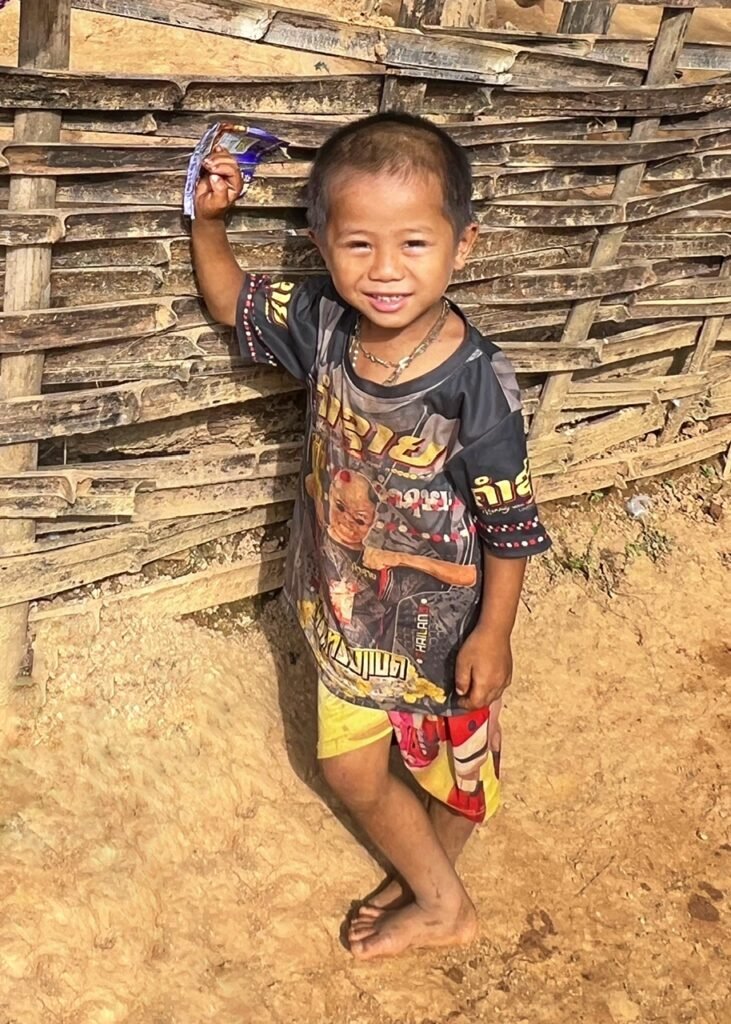
The kids all seemed to be healthy and mostly happy finding plenty of ways to keep busy, despite their lack of so much in life. In this village, the education system is severely lacking and costs money that many villagers can’t afford…a mere $6/year per student. Those that get to go grade school can do so in their village, middle schoolers have to walk 45 minutes each way to the next village over, and if you’re lucky enough, high schoolers must go by boat two hours to Pak Beng. Since it’s so far, however, it requires renting a house there which makes it simply unattainable financially for most.
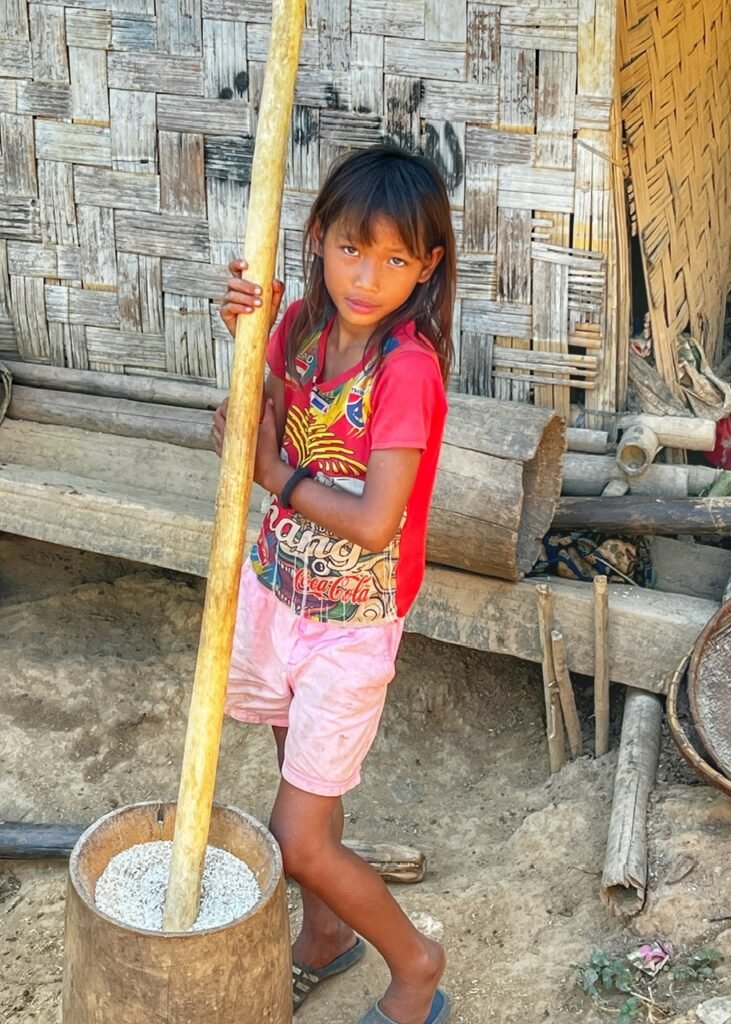
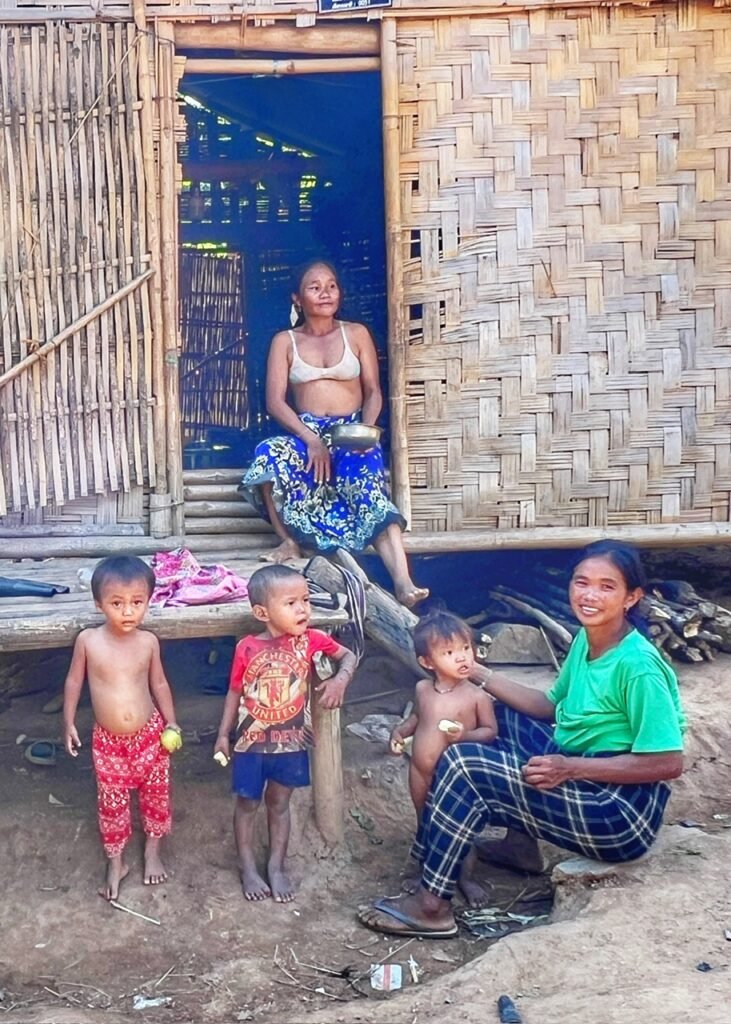
We all placed money in the donation box hoping it would actually find its way to a student. There are many government initiatives to change the education system, but it’s quite slow-going.
An additional challenge is language. Since the Khmu language is their mother tongue, and Lao is the official language of instruction, children often face challenges when they first start school. Learning in a second language can slow progress and lead to higher dropout rates.
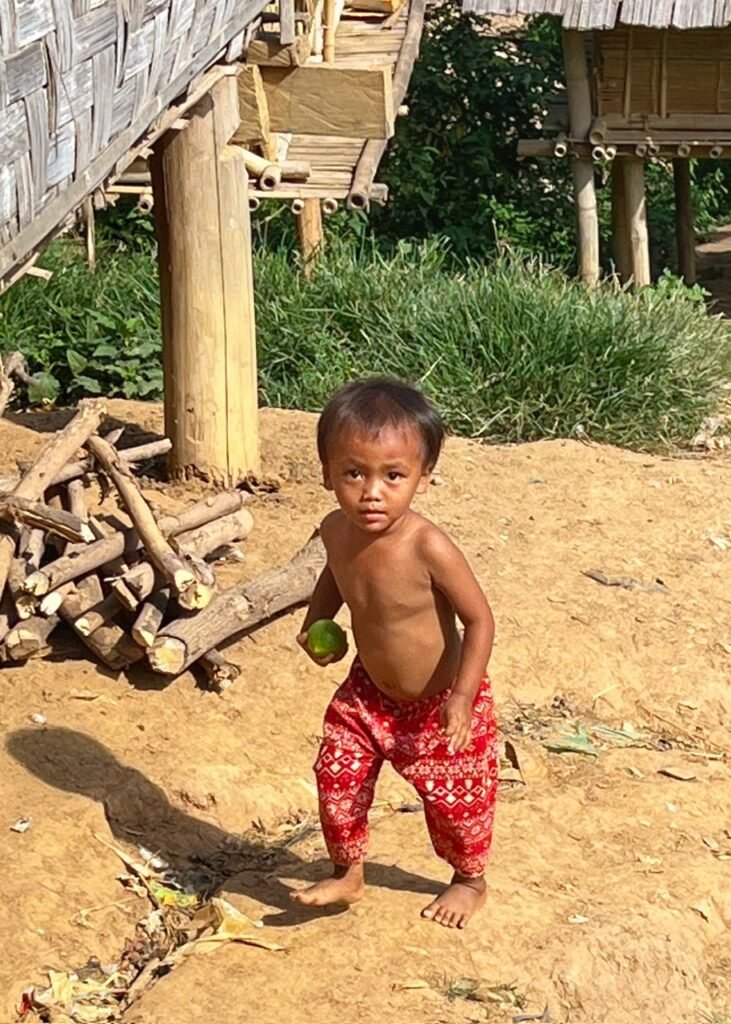
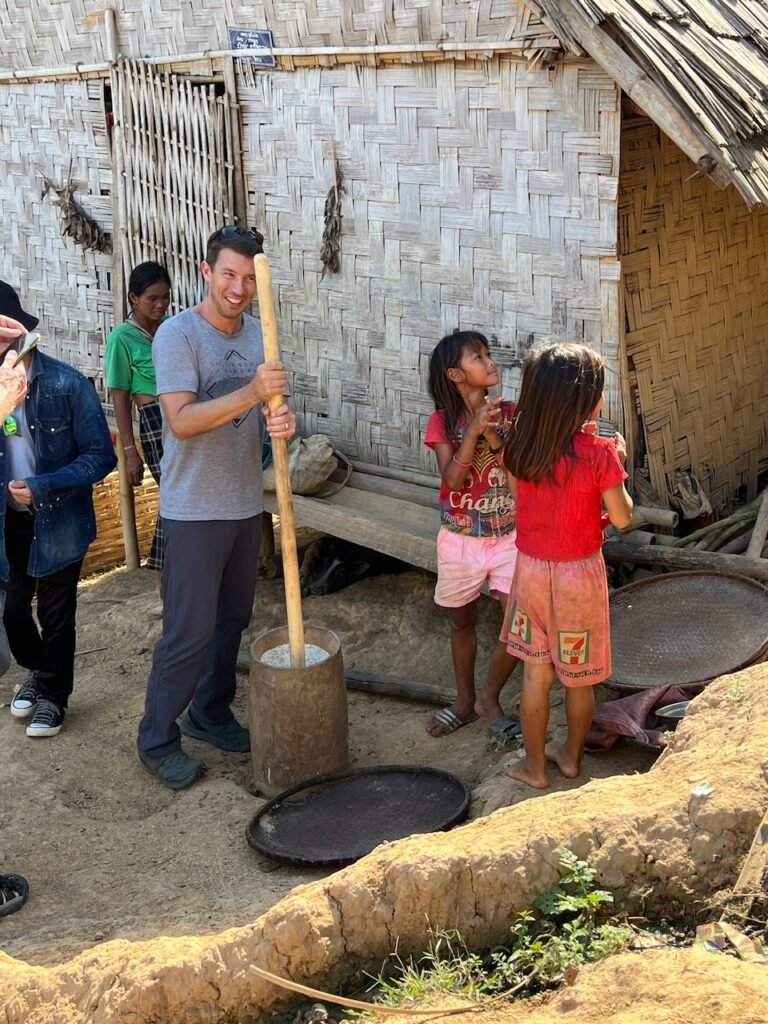
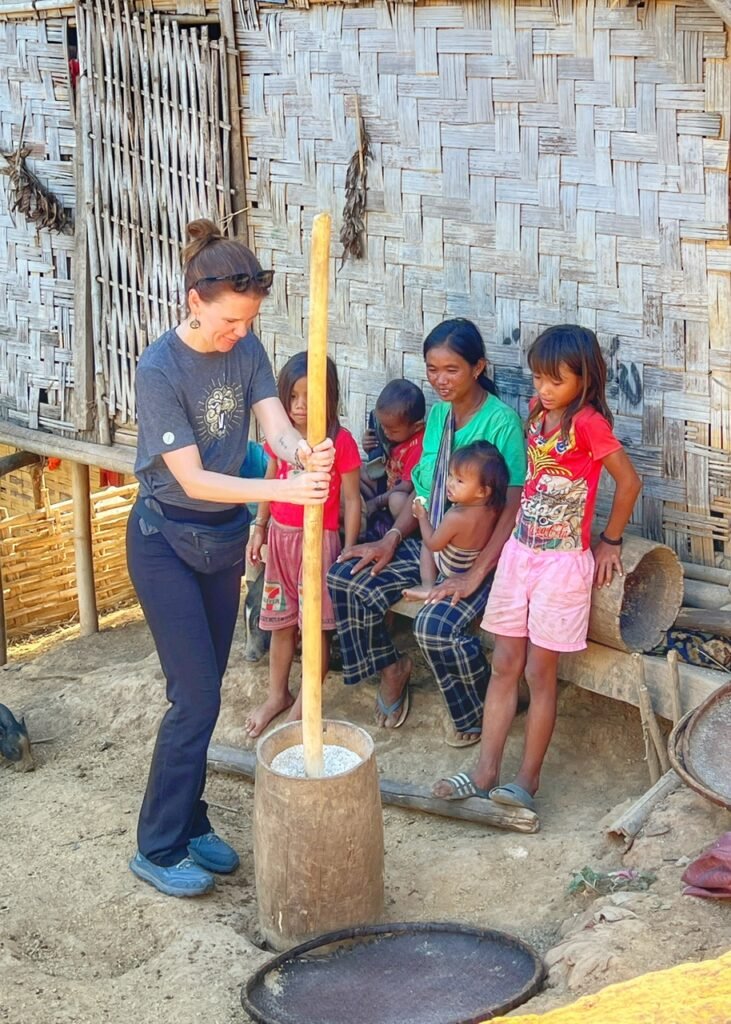
We westerners are truly so privileged for our education and opportunities because grinding rice isn’t quite as easy as Greg makes it look, and the villagers were deservedly scrutinizing Mandy’s technique.
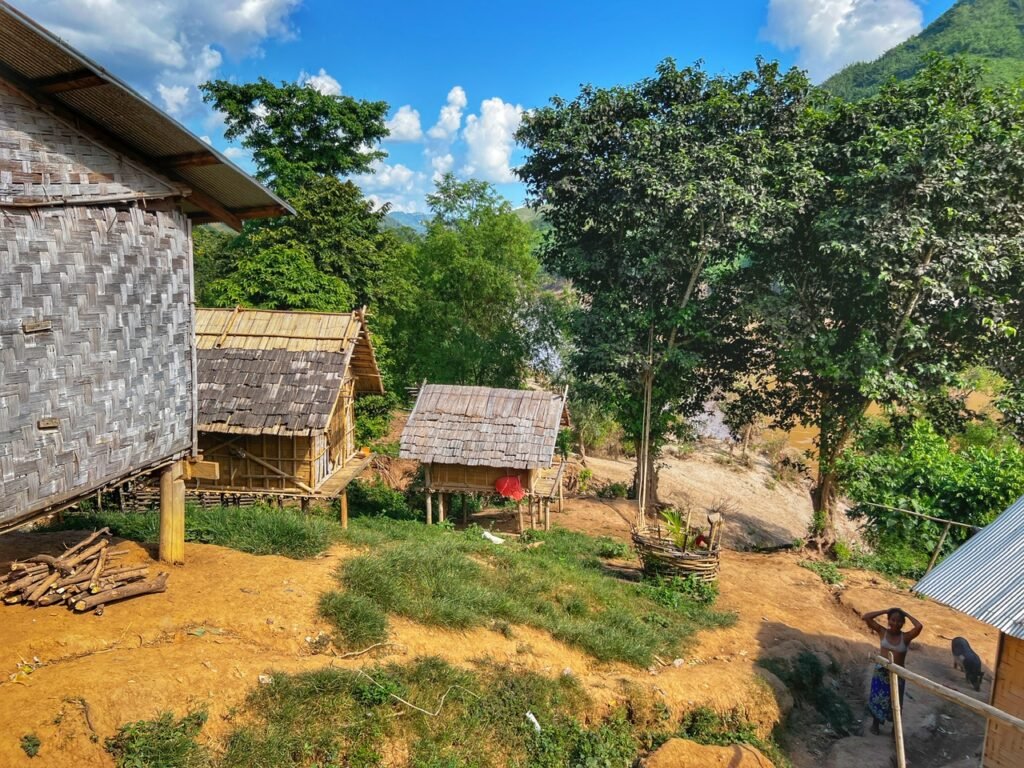
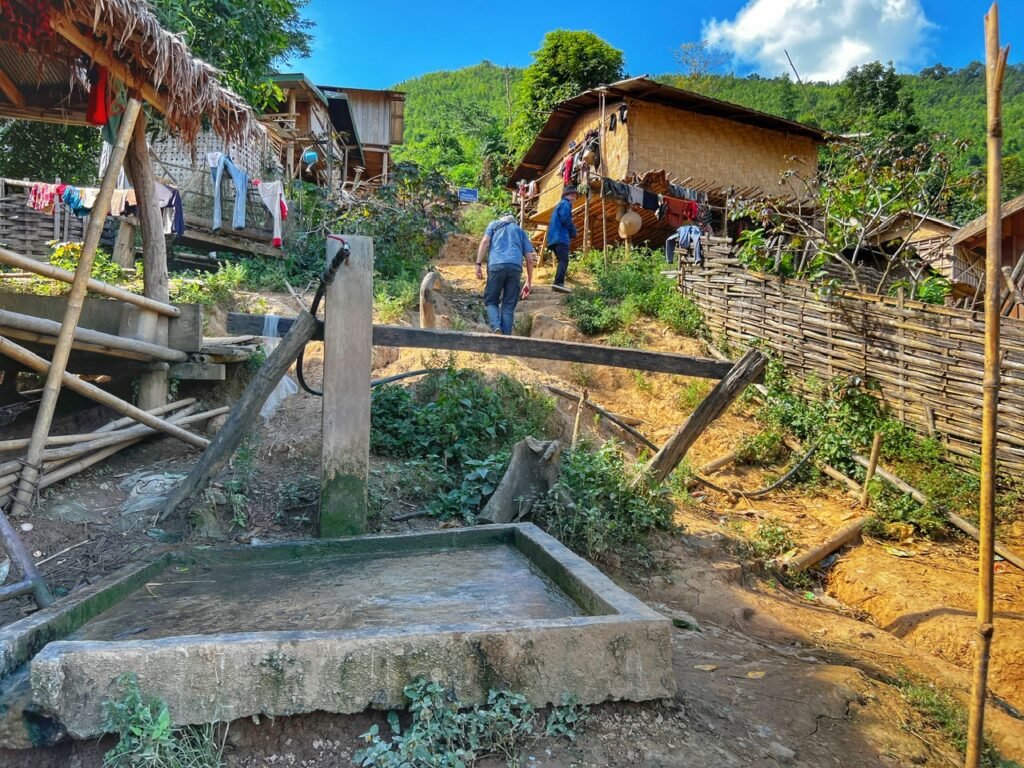
From the boat, we climbed up the hill past many locals’ homes and the water source, which were all on stilts to assist with flooding and critters.
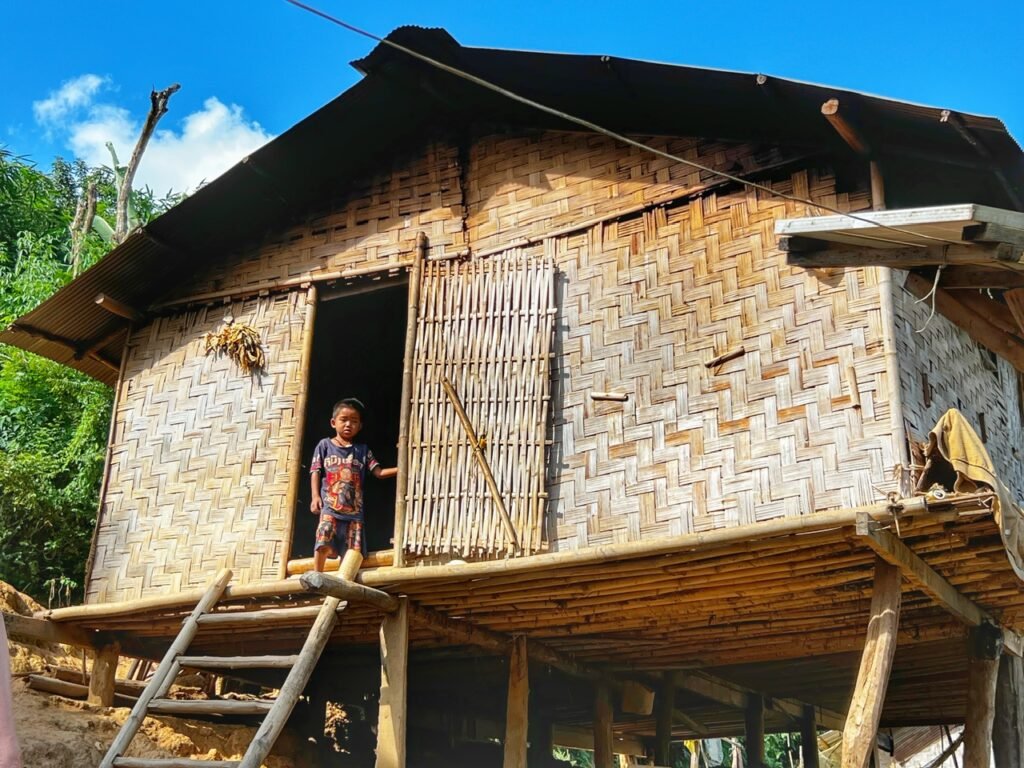
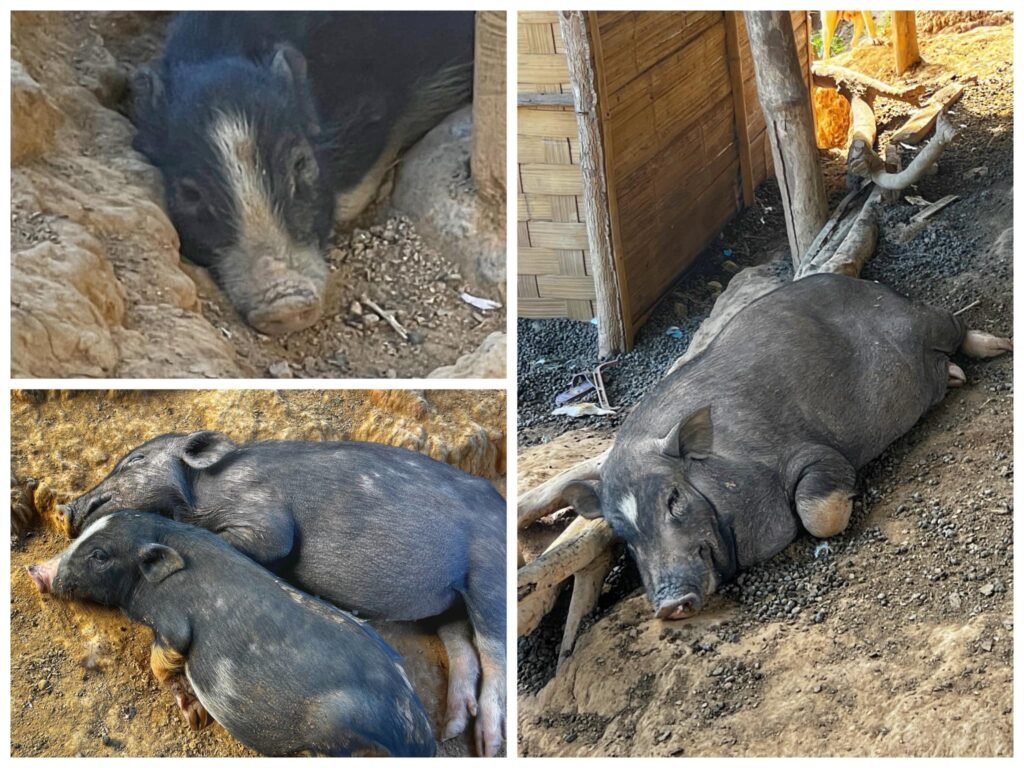
The houses looked like something from the Three Little Pigs story. Speaking of pigs, there were a lot of them. While we may have a choice not to eat them, they definitely might not.
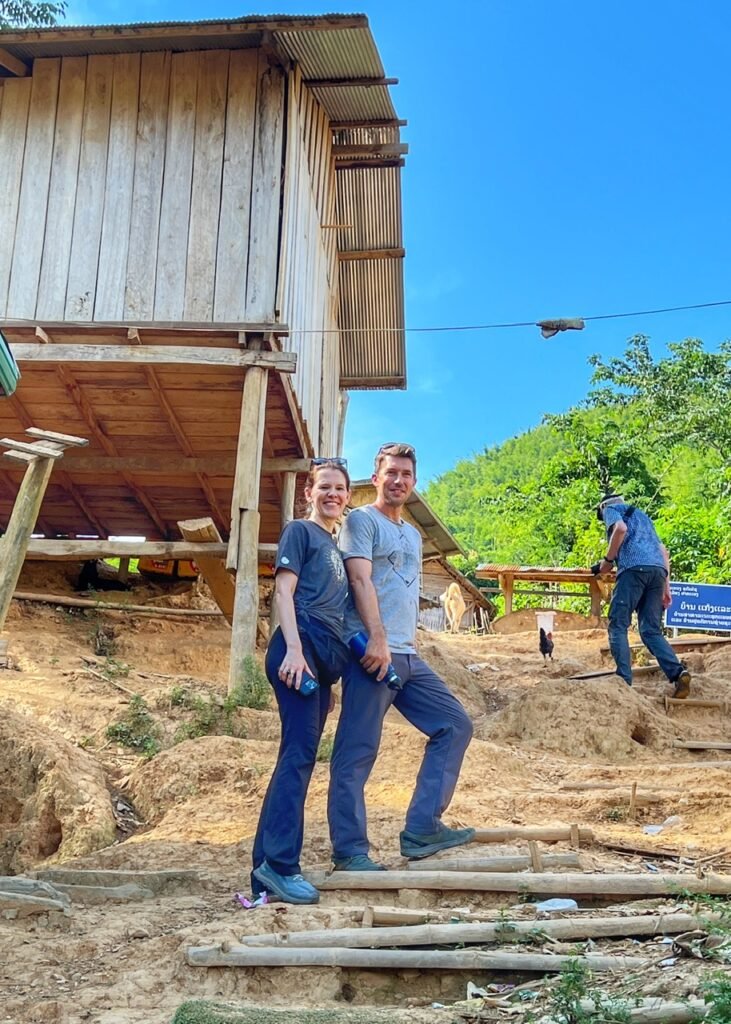
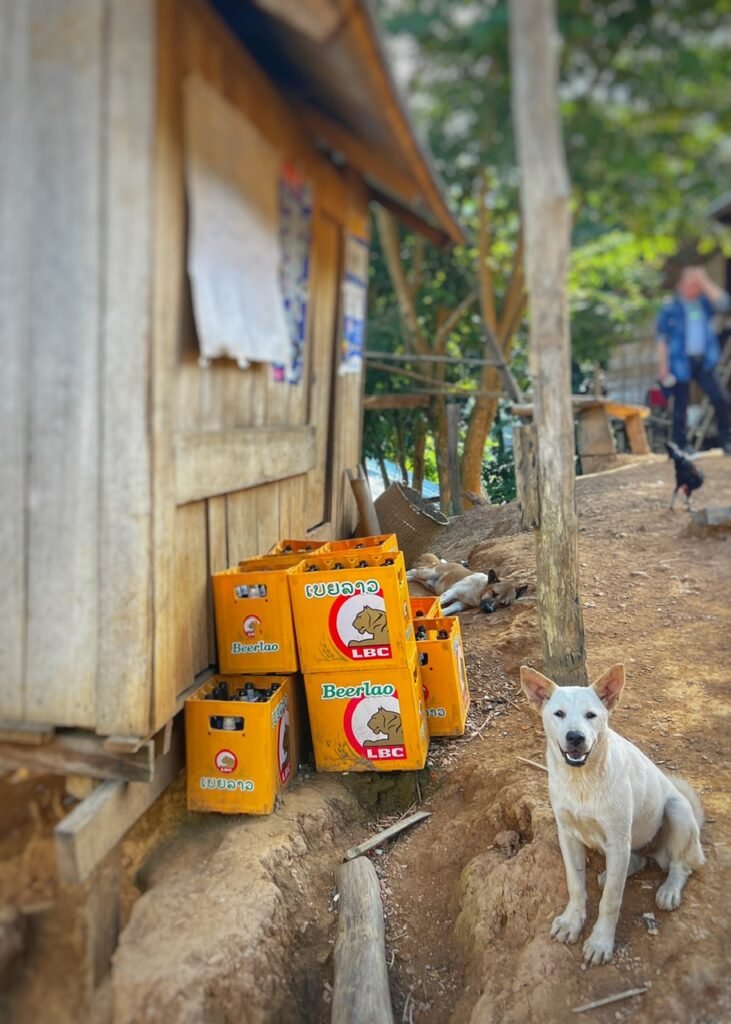
The uphill slog into the village. They somehow seem to be getting a regular shipment of BeerLao.
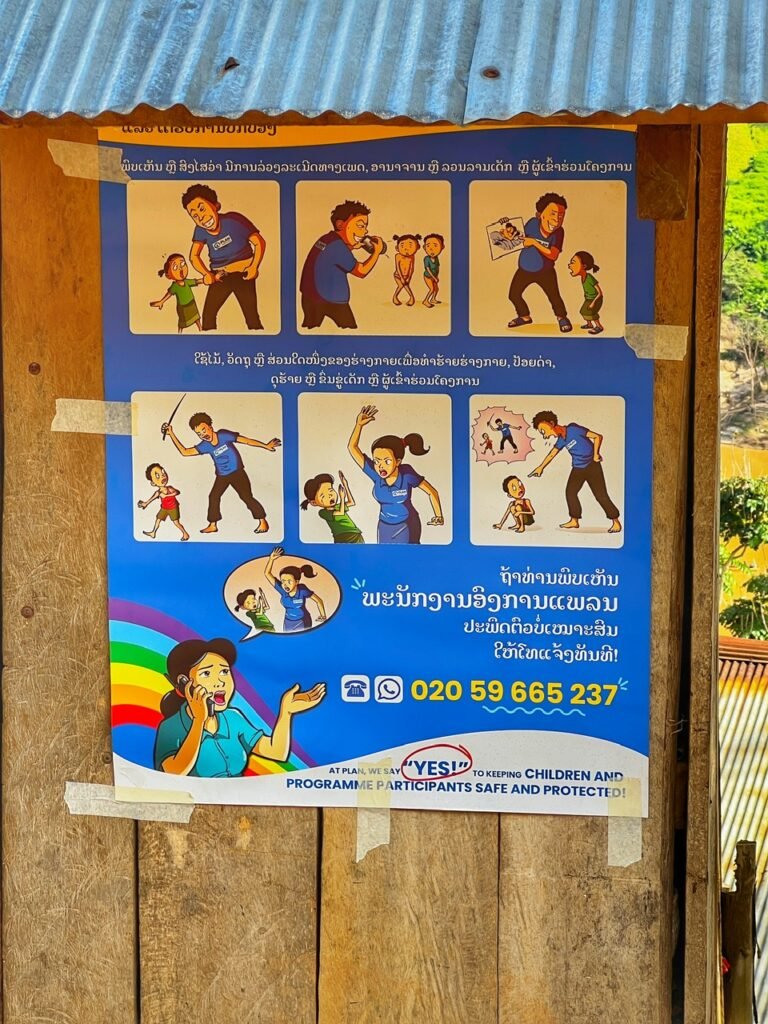
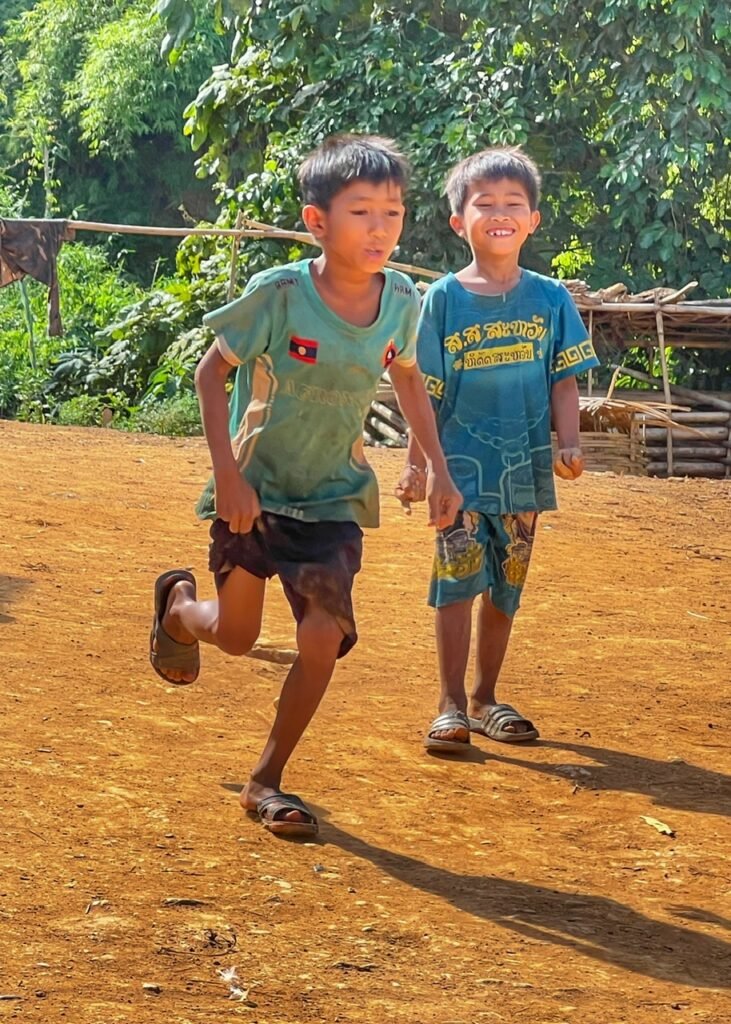
Near the pile of BeerLao crates, it’s despairing to see in a place like this a public service announcement for child abuse is needed. But it’s also good to see there are efforts to keep children protected. A sad, but true reality anywhere, whether you’re rich or poor.
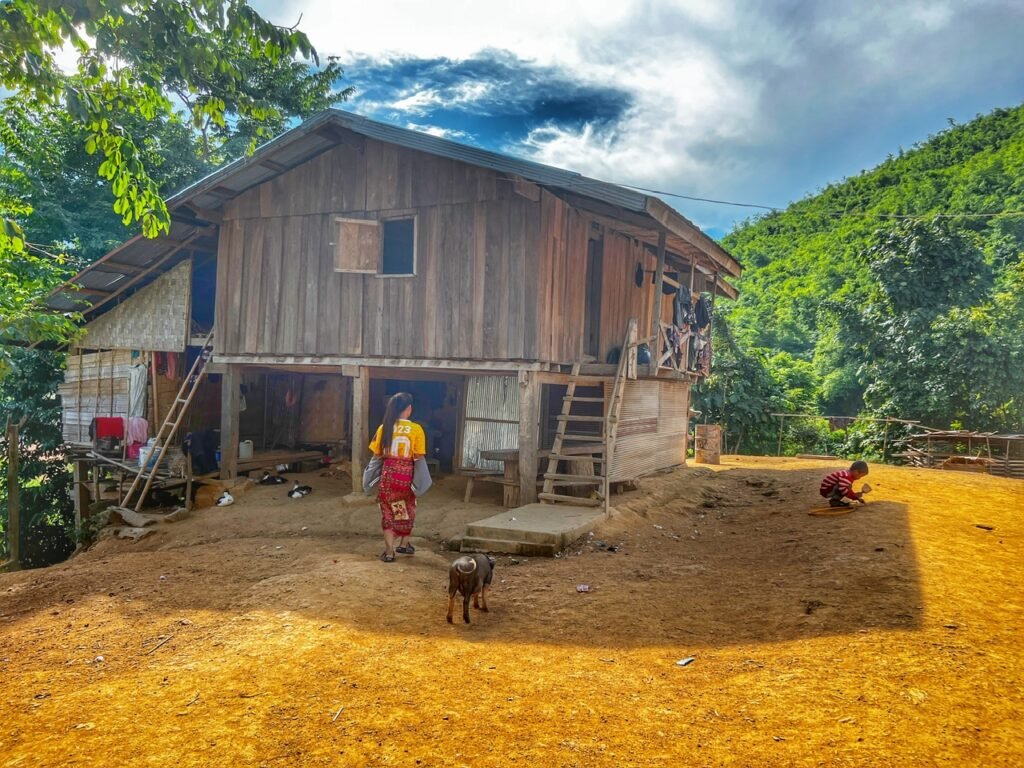
A traditional home, which seems a lot bigger than some of the others.

This sweet, young boy followed us around for awhile though we couldn’t get him to crack a smile. Our guide, Cha, said he was shy as he tried to speak to him in the local language.
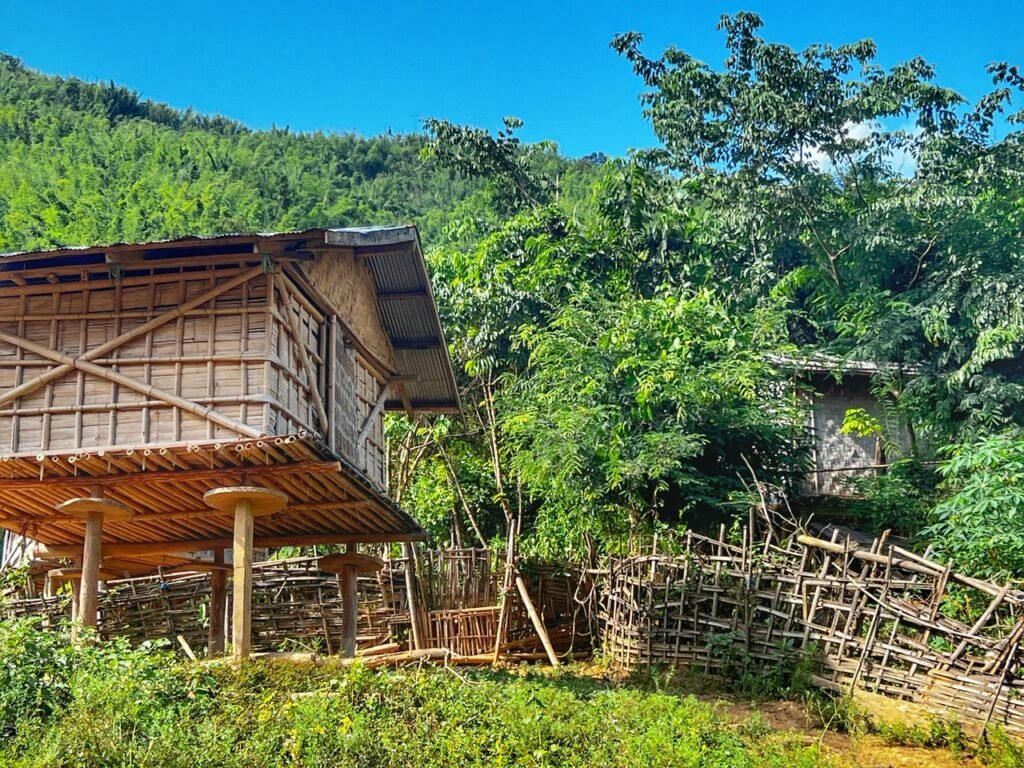
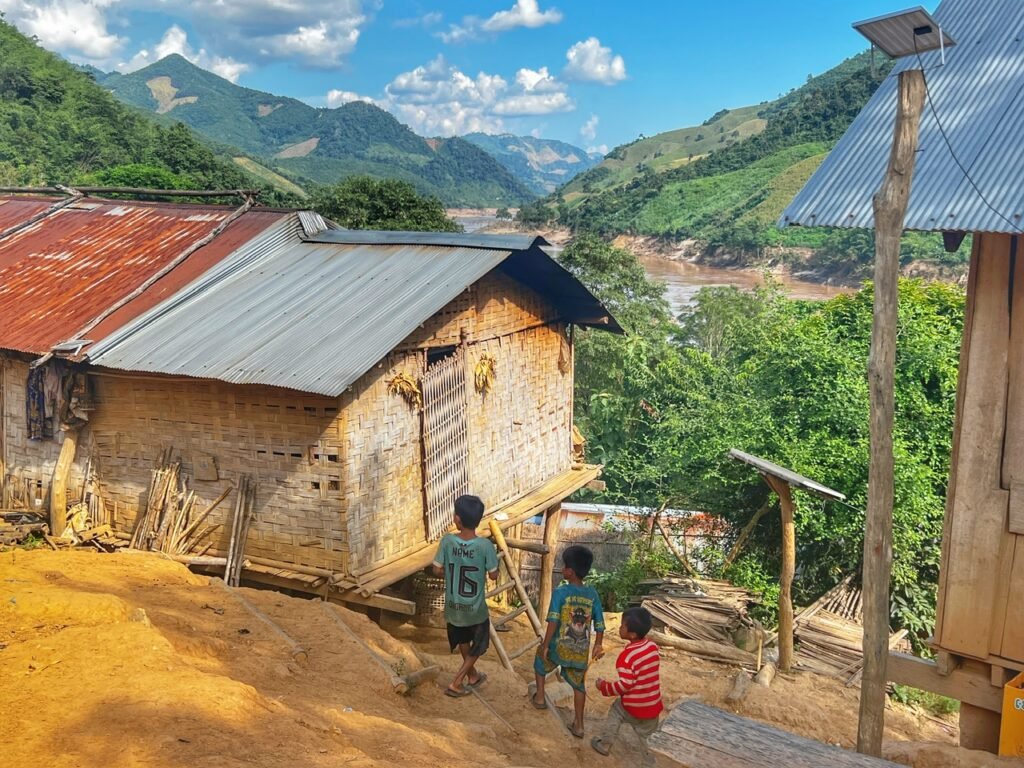
In this image, you can see the underside of the houses. The stilts are designed like this in order to keep rats out. But what a beautiful landscape they live in!
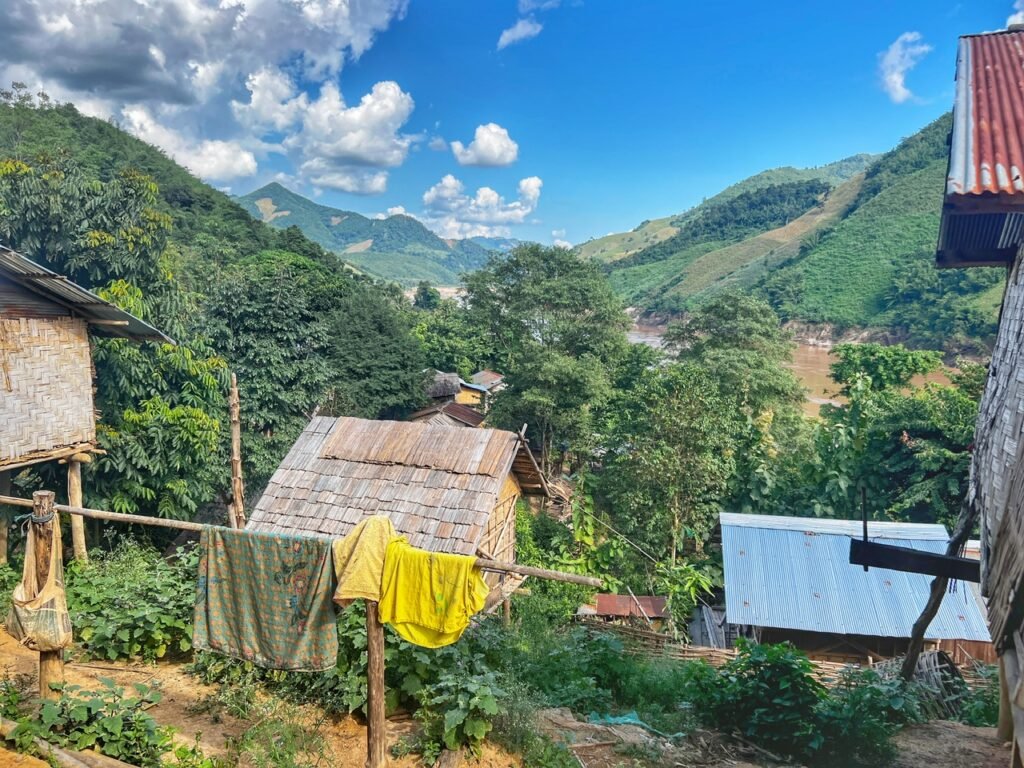

You might notice this house has plants pinned to the outside of it. Depending on the position of the plant, it represented that someone inside had either died, or was sick, so that community members can leave food outside for the family without risking contagion or intrusion.

When we saw this friendly little girl, of course our first thought was horror at the bag she’s wearing on her head, despite the fact she’s running a few steps in front of mom. Guess the PSA’s don’t handle that, or they’ve simply got bigger survival problems to handle.
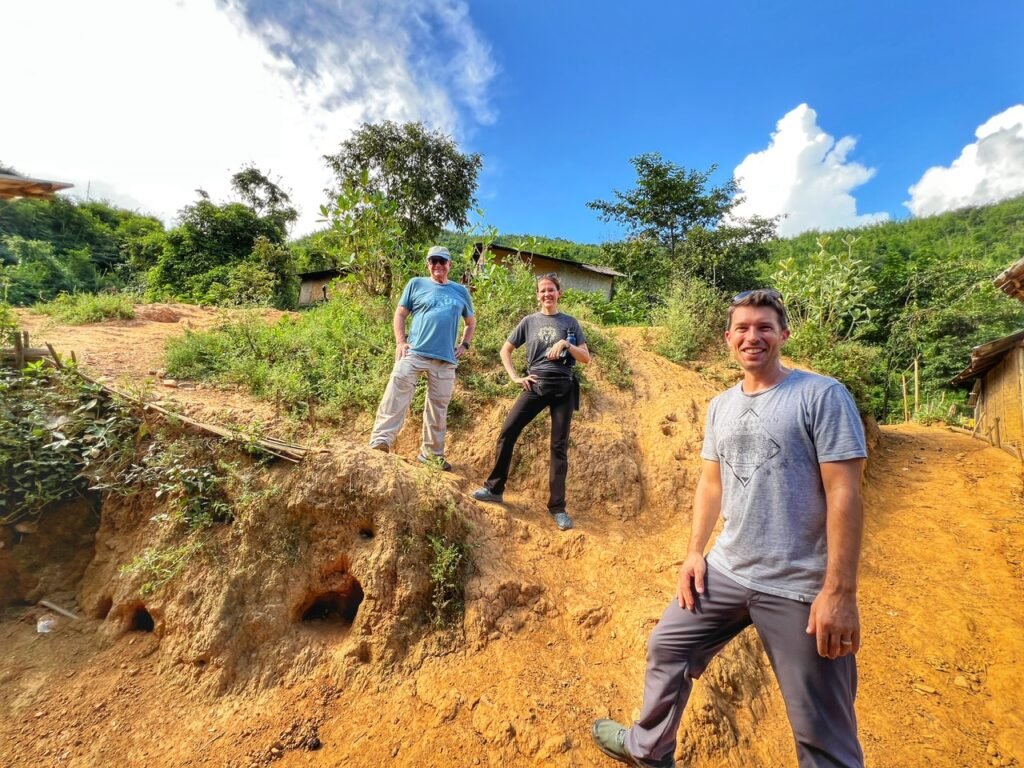

Heading down from the village. As this woman processes drying rice, we notice there seems to be at least four children to every women we saw.
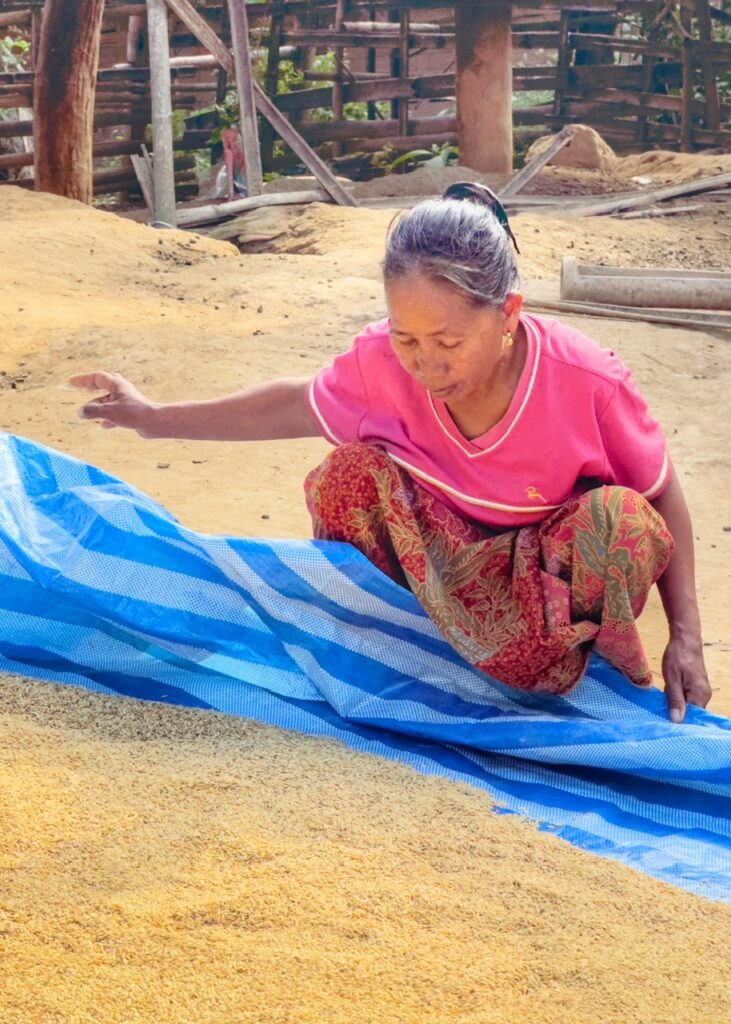
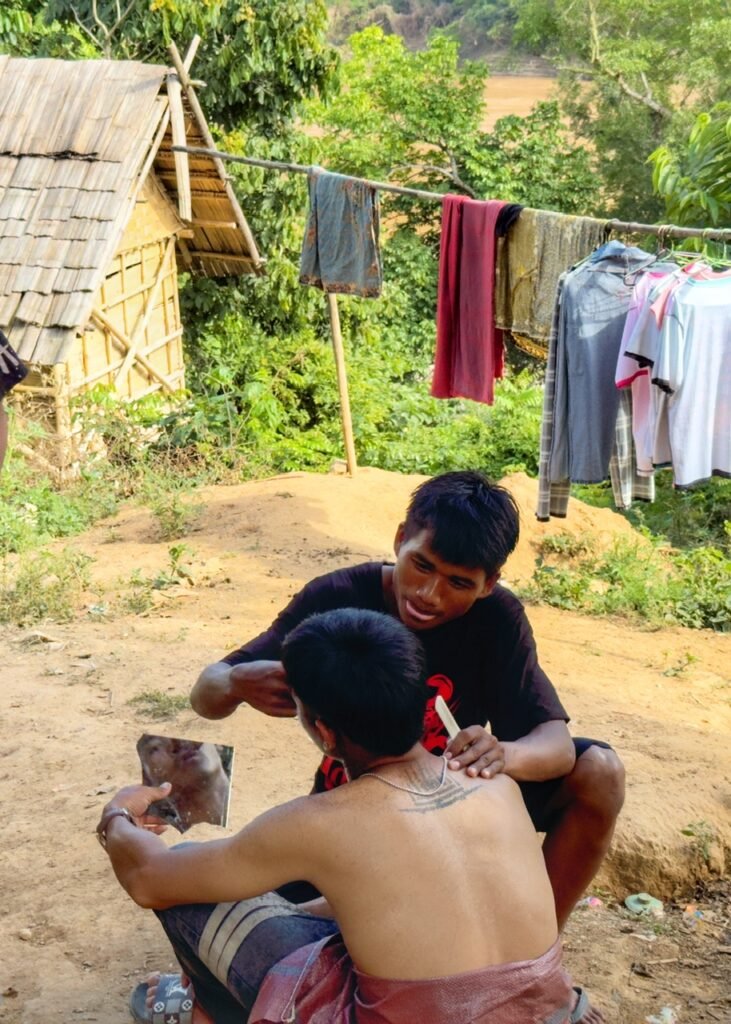
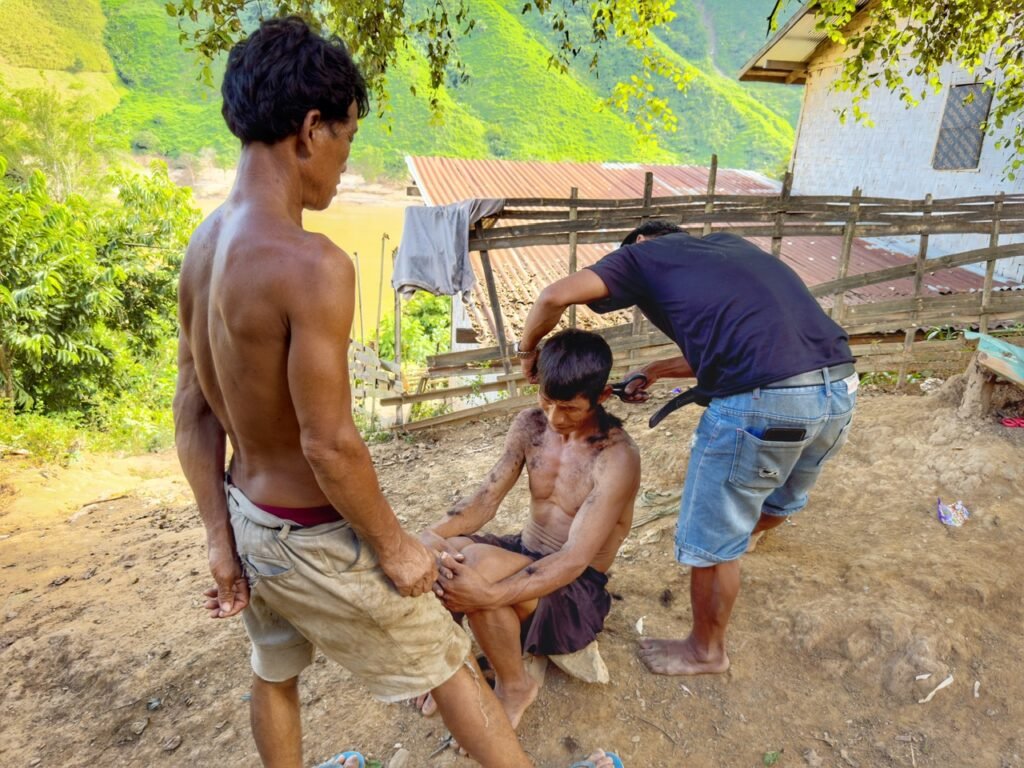
So very much work. The men we saw seemed to be involved in a different kind of work…giving each other hair cuts. Check out that tongue projected in concentration!

Laundry was draped everywhere, which of course was likely washed in the chocolatey waters of the Mekong.

Mandy guiding Grace down the steep descent back to the boat….

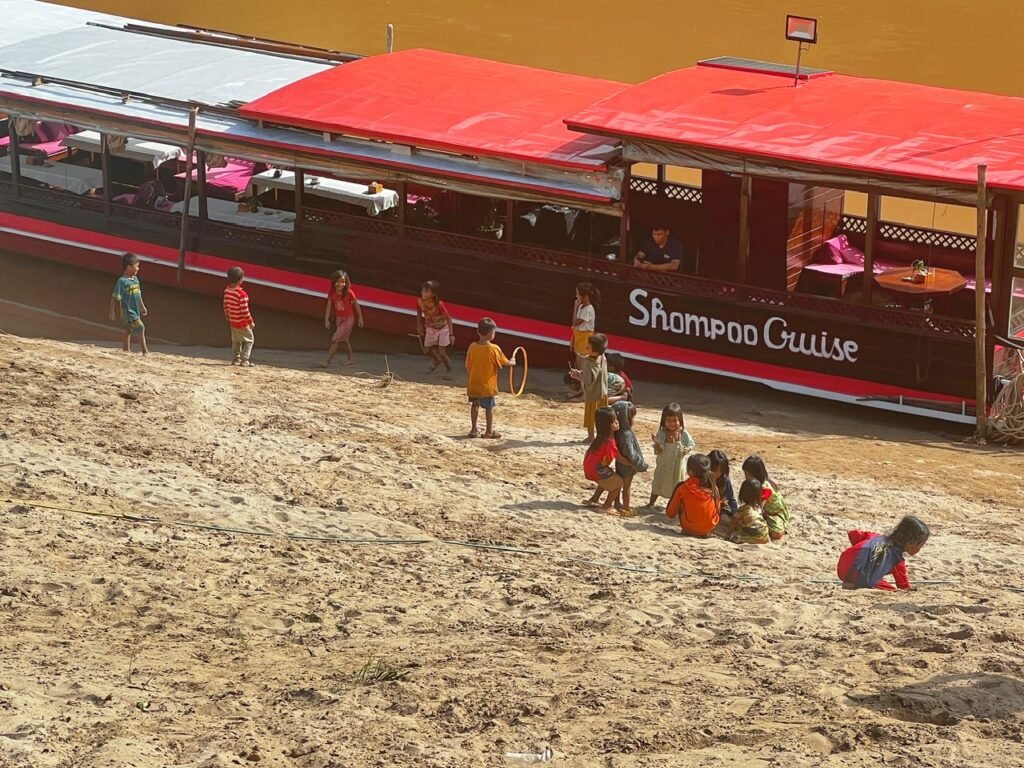
…where the little girls congregated in the sand creating “sand patties” the way we used to play with mud. It was quite a disheartening contrast to see our fancy pants boat next to them. We got a look at their lives, and they too got a look into ours.
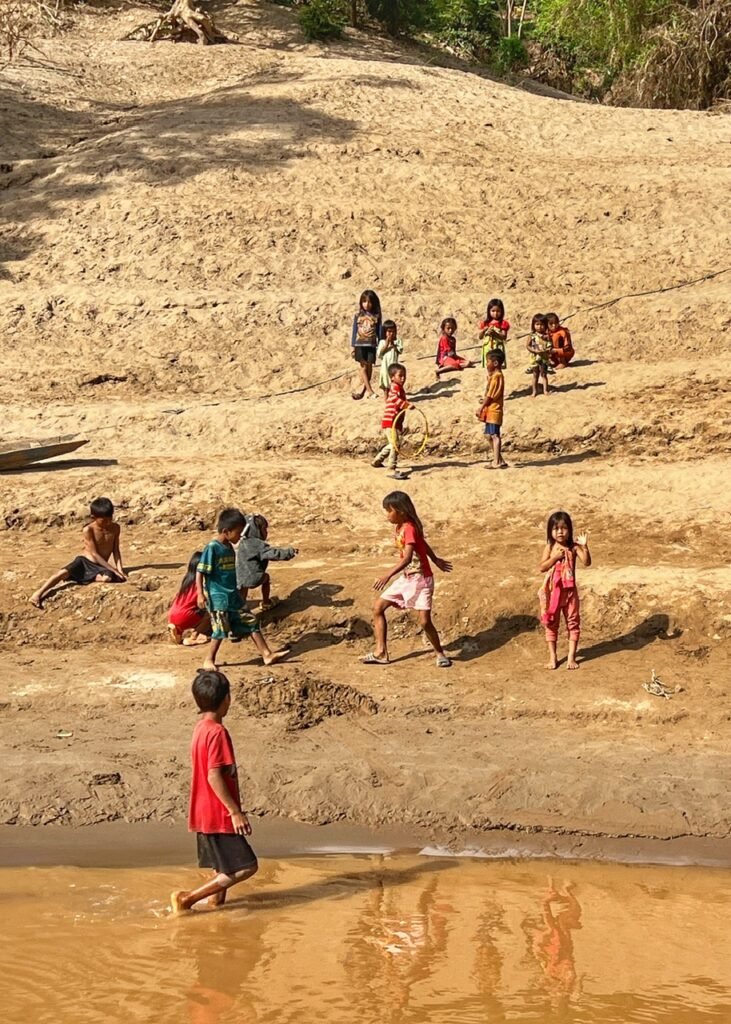
However, as we floated away, receiving cold cloths and welcome-back-to-the- boat-drinks, they splashed happily in the river and played with their sand until the next boat would come along.
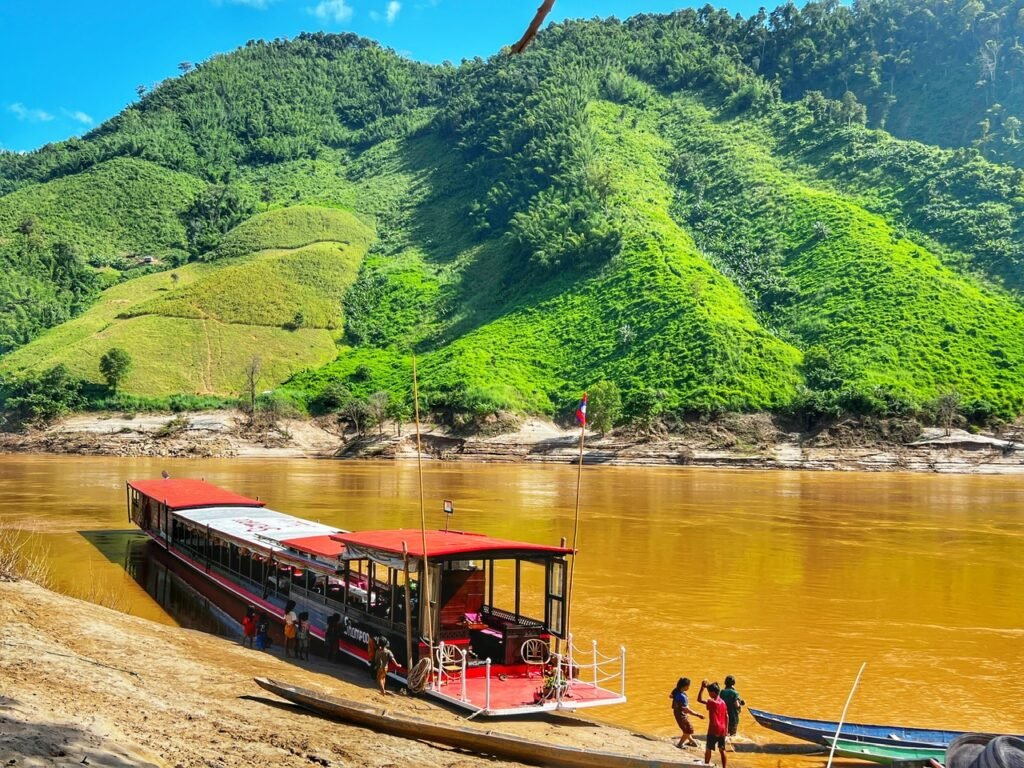
Overnight in the Village of Pak Beng
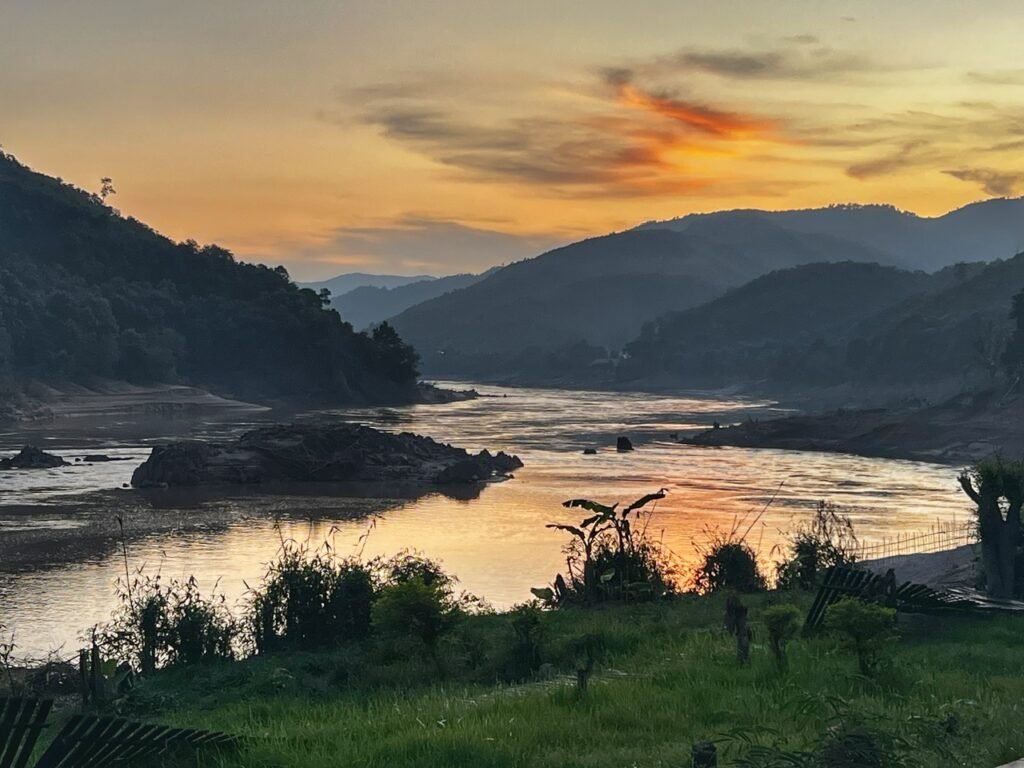
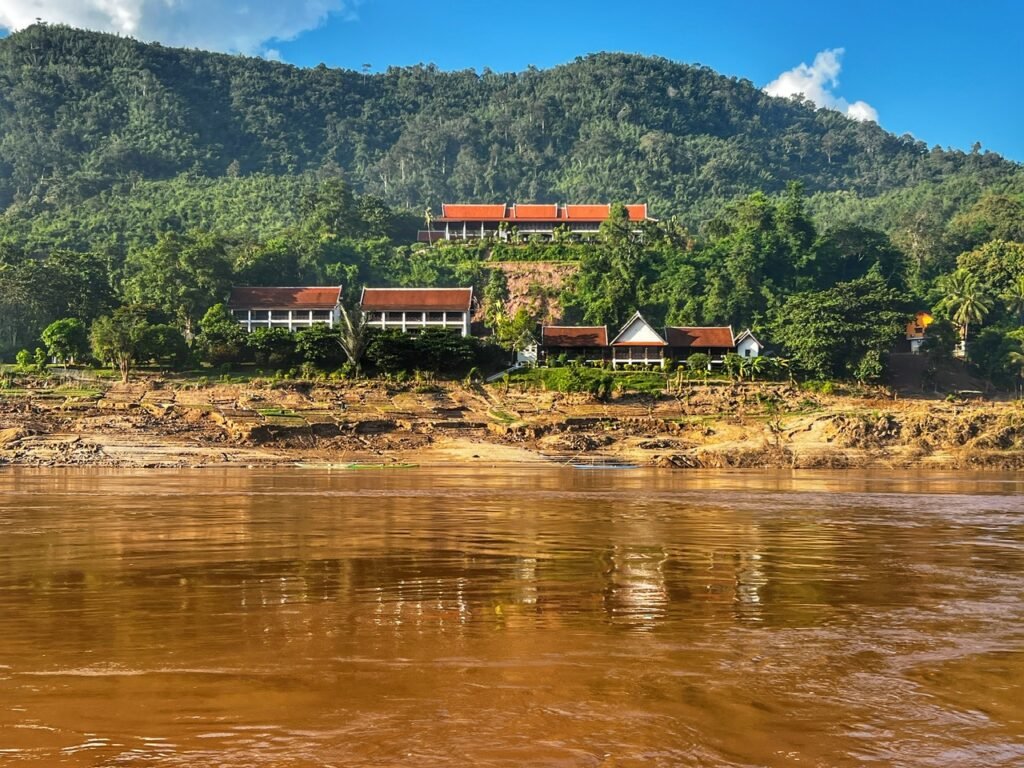
Our night on the Mekong was spent in the village of Pak Beng, which is the stopping point for most river boats going from the Thai border to Luang Prabang. Shompoo Cruises gave us three options…a budget, mid-range and premium option and although we told Greg’s parents we’d be happy to plop down in our usual budget digs, they insisted on us joining them in mid-range at Sanctuary Pak Beng Lodge. As usual, we get a bit spoiled in their presence.
The Sanctuary had a mesmerizing view we’d been dreaming about forever…one which consistently reminded us of the exotic place we were perched before…the Mekong.
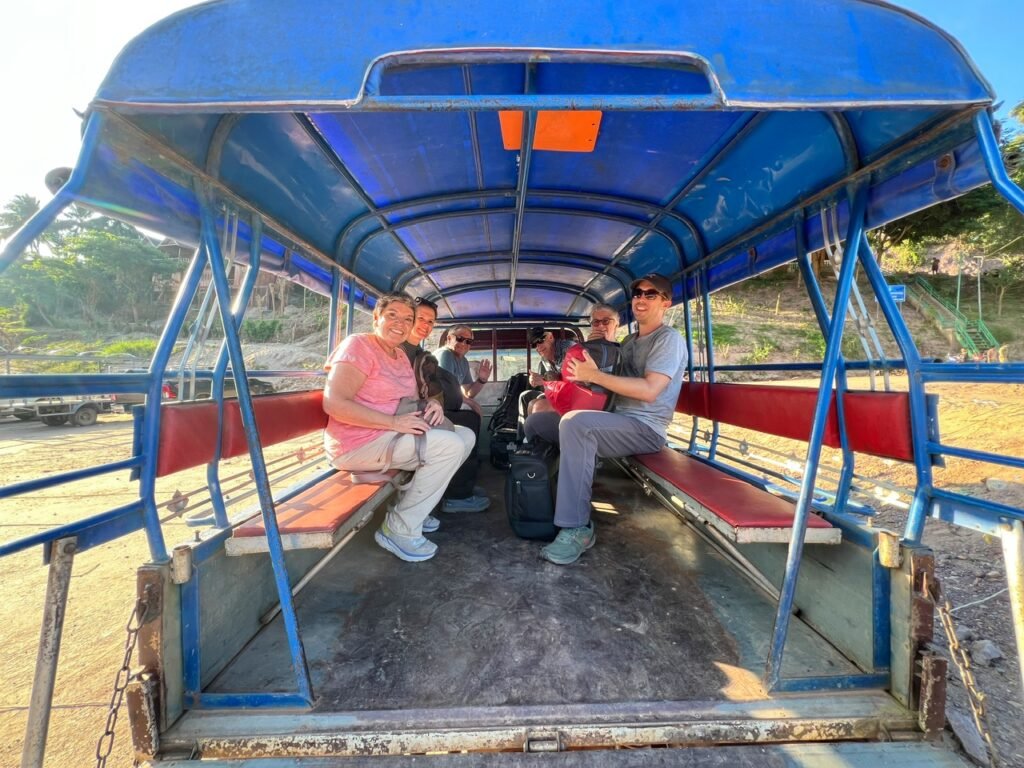
When we got to the shore, we scrambled up a small bank and then piled into Laos version of a tuk tuk. Because Grace had never been in anything like this, she was pretty excited. Naturally we had “staff” to help us hoist our luggage in. 🤣
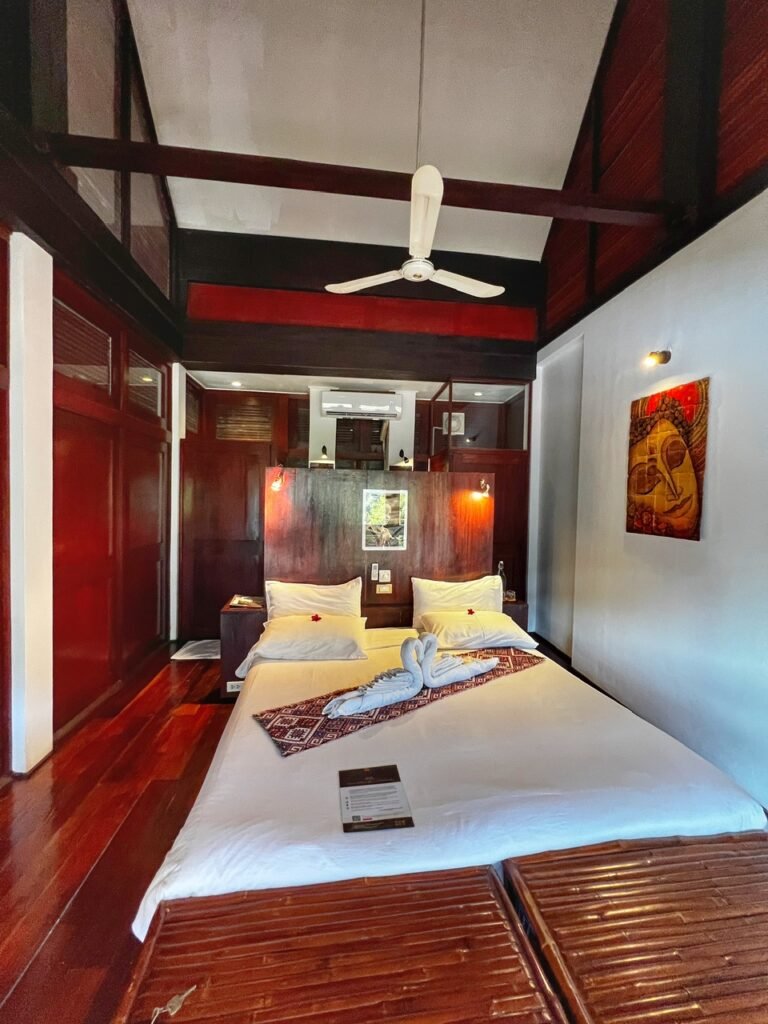
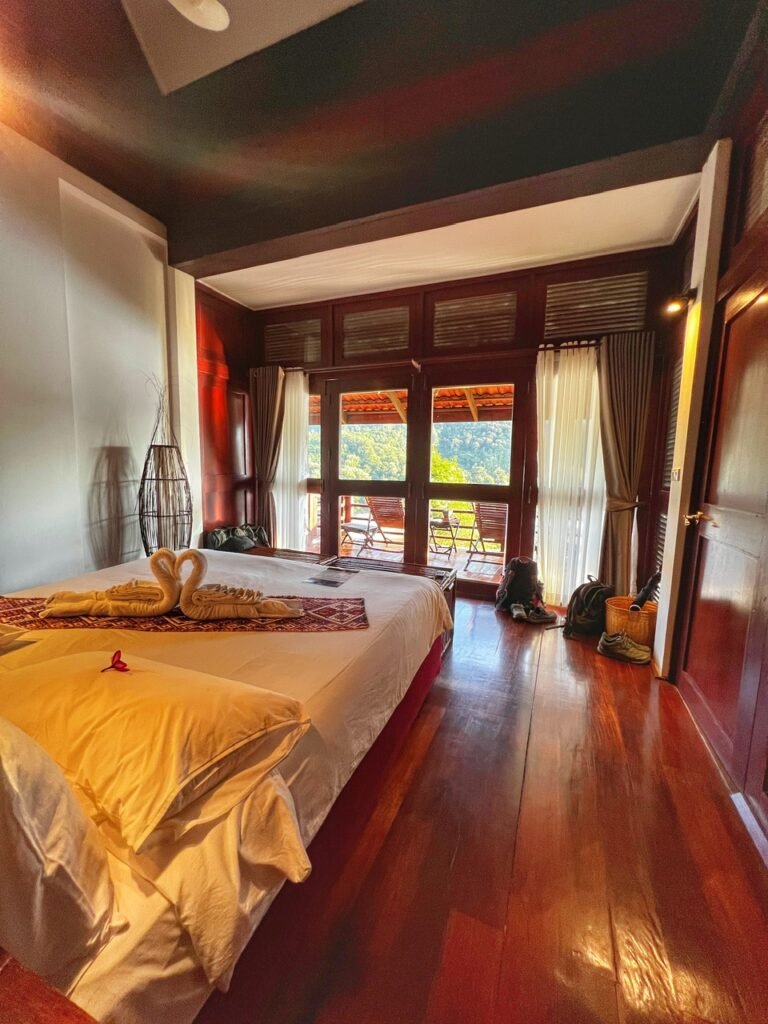
We had swans floating on our bed when we got to the hotel, so you know we’re living large. Our gorgeous room for the night would cost about $72 if we reserved on Booking. The rosewood floors are just exquisite!

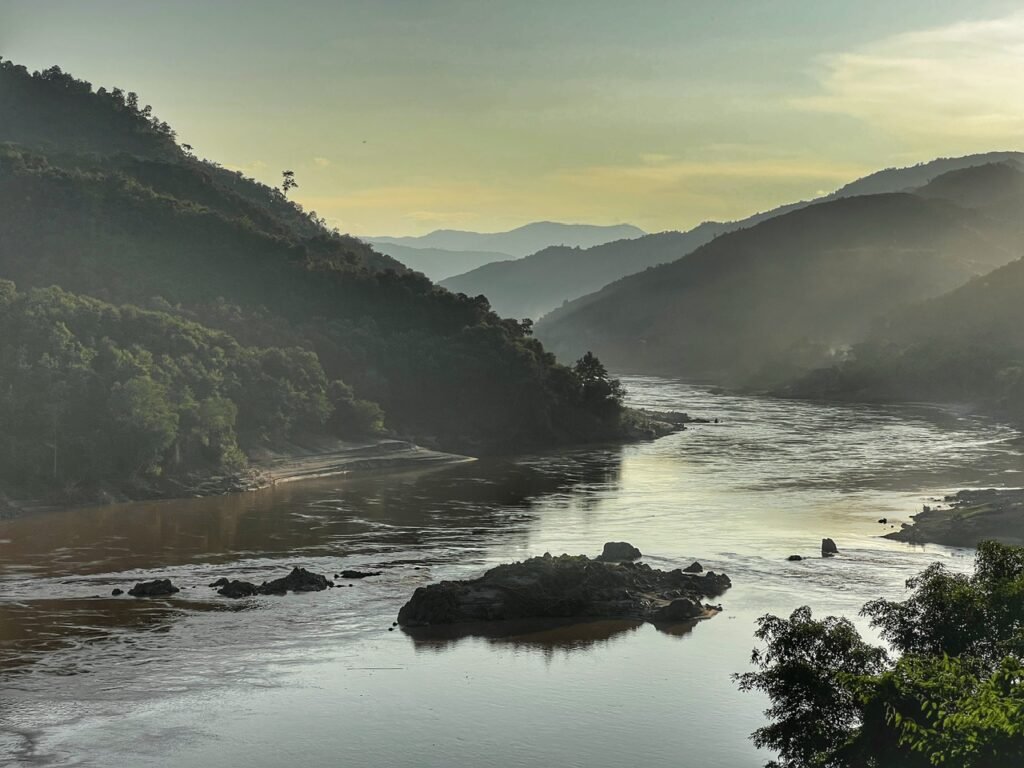
We also had a lovely patio which overlooked the river. Simply dreamy!
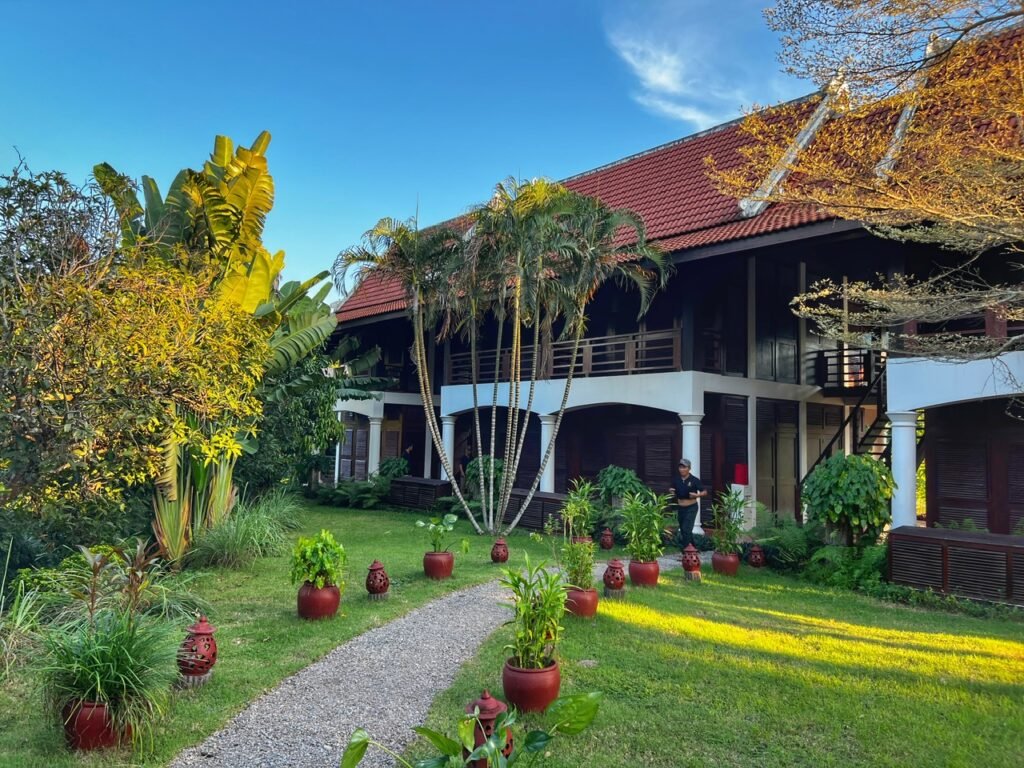
Checking out the exterior of the hotel…


…as we made our way down to the pool for a refreshing dip.
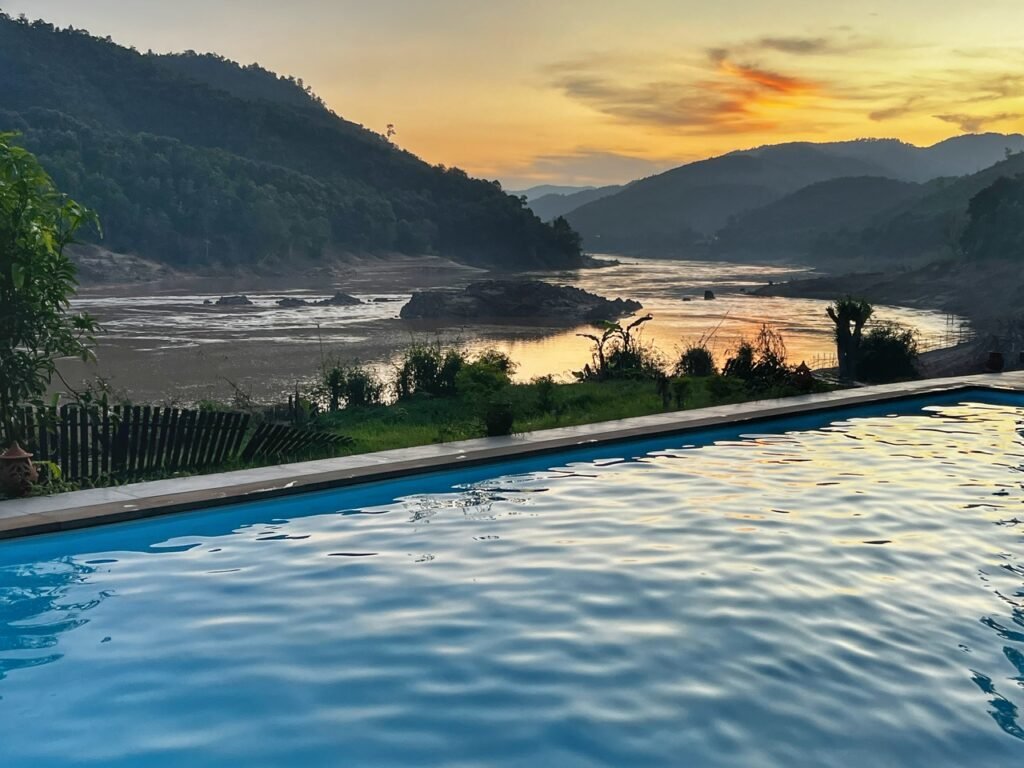
Despite how empty it looks in this photo, it was full of jabbering Americans, even though two of them kept remarking how peaceful it was. Interesting how they suddenly come out of the woodwork when we stay at nicer places. 🤣 We were still able to soak in the gorgeous view though.
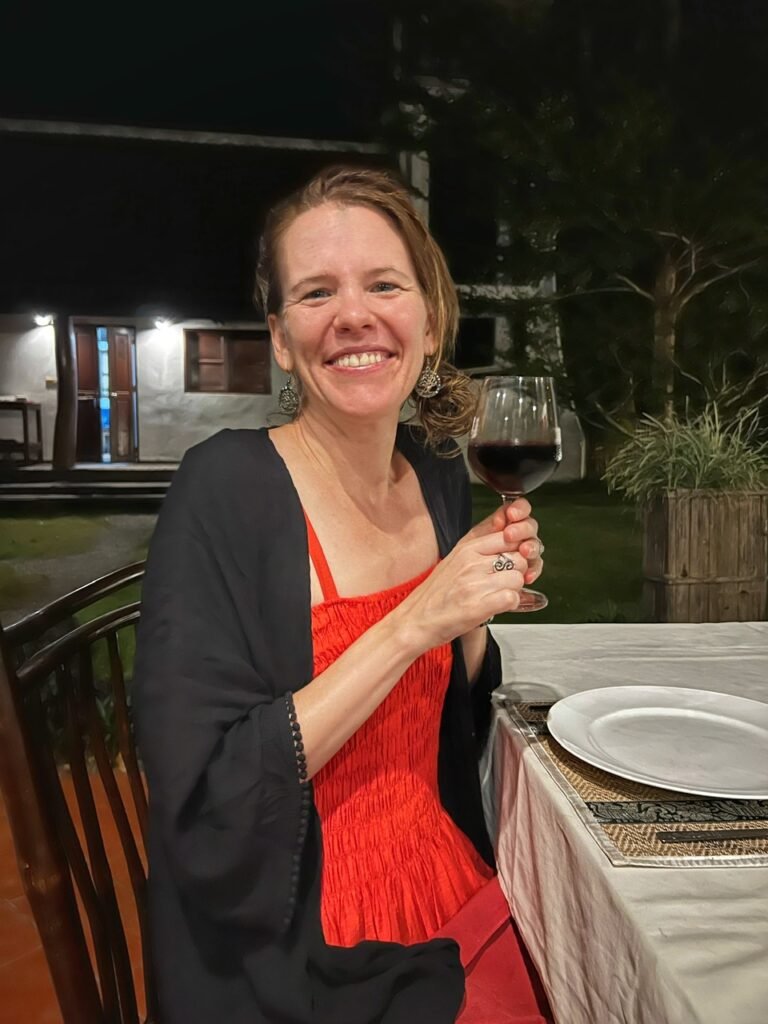
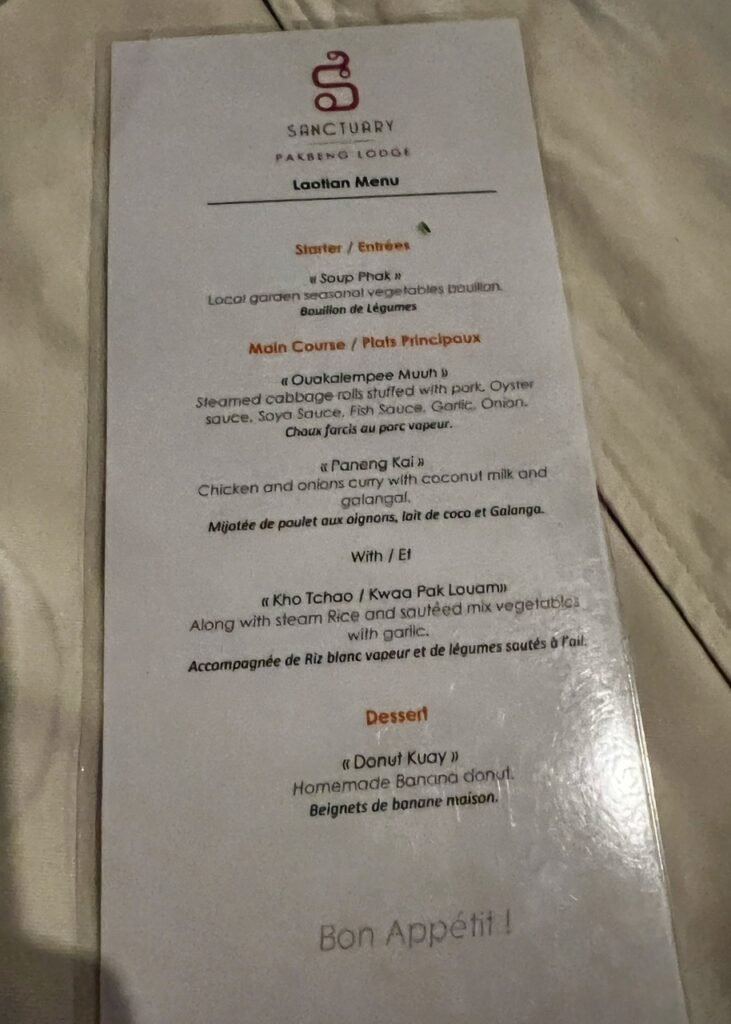
Thanks to the lodge being owned by a Frenchman, we got to enjoy the best glass of wine we’ve had in months as we sat down to dinner. And it was cheap at $4/glass. We would soon realize that cheap alcohol is surprisingly a perk of Laos everywhere! 😁
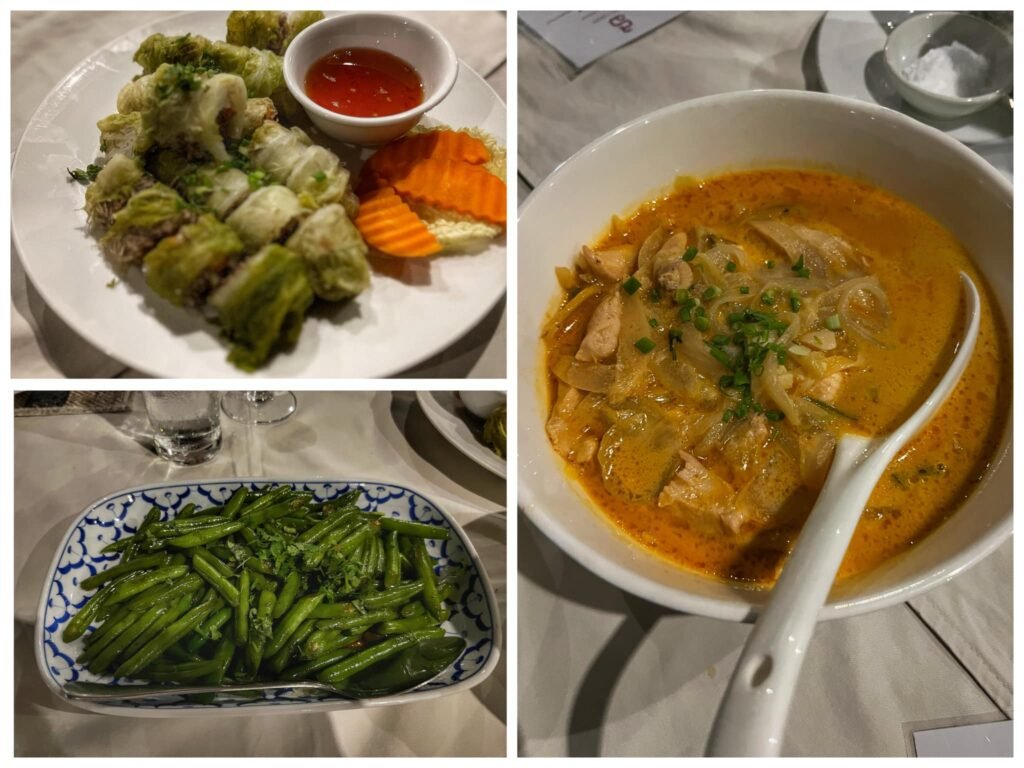
The menu would include steamed cabbage rolls stuffed with pork, a chicken and onion curry with coconut milk and galangal, and sautéed green beans. We would also soon learn that Laos is another Asian green bean country. Lots to look forward to!

The kitchen staff whipping up our pre-fixe three-course meal.
Day Two Mekong Cruise
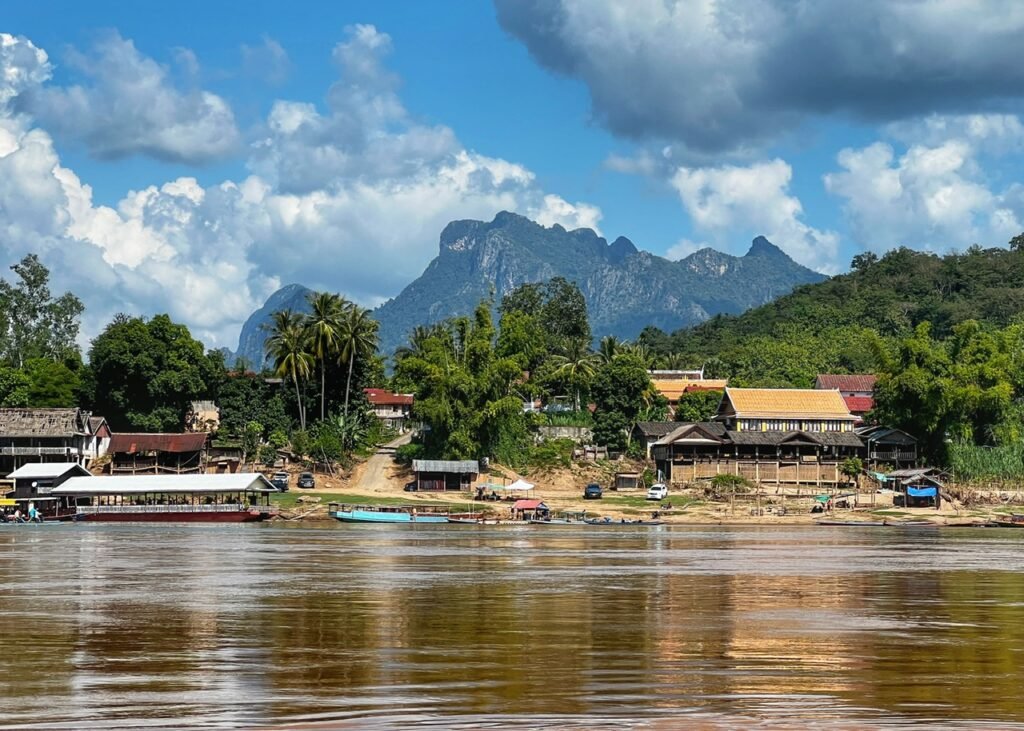
Day two began bright and early after a western, which means eggy breakfast, at the Sanctuary Pak Beng when we were greeted with a view of distant elephants from the nearby sanctuary coming to have a slurp of the Mekong. Besides starry-eyed views of the jagged mountains, the day was also filled with lots more relaxation, catching up with Greg’s parents and two more stops: to a whisky village and a very famous Buddhist temple. The further we went east, the more jigsaw puzzly the mountains would get.
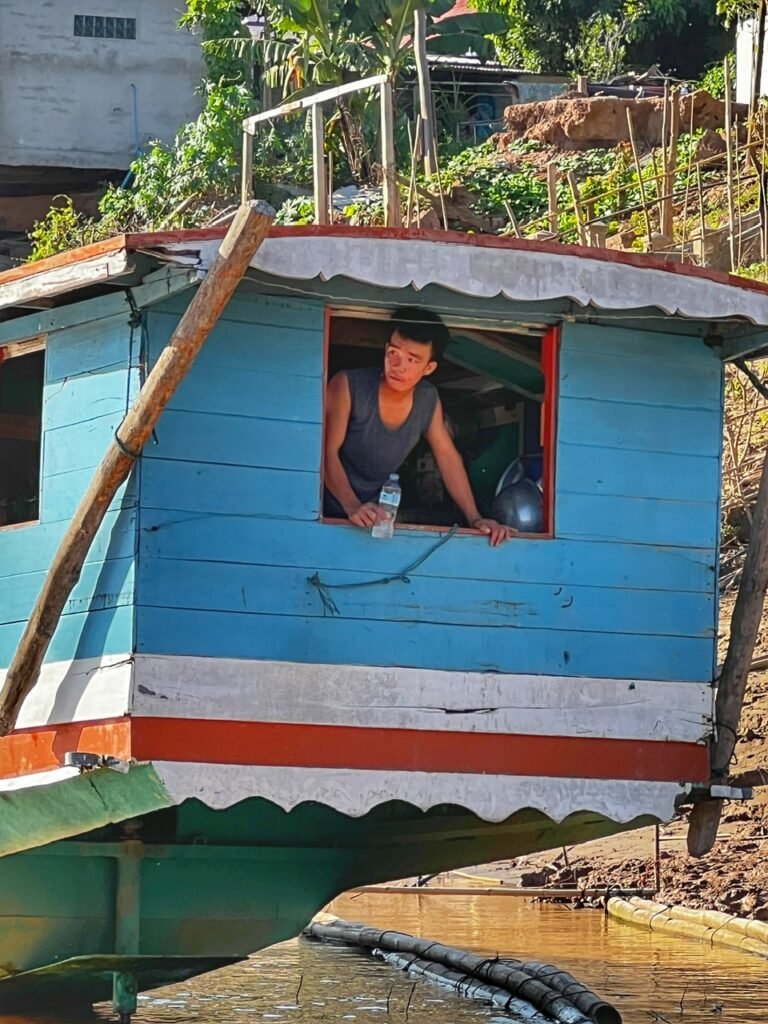

A man peering out from the back of a nearby longboat.
The hazy grey was thick as it enveloped the mystical scene that morning. The elephants from the sanctuary near Pak Beng come down to the water almost every morning for bathing and water. Although they were across the river, we were thrilled to see them in their natural environment.
If you are wanting to visit a sanctuary, the Mekong Elephant Park Sanctuary, seems to be a good and ethical one where they are saving the elephants from mass tourism and exploitation. It is owned by the same Frenchman who owned our hotel (also called Sanctuary) and there is no riding, chains or the bad stuff.
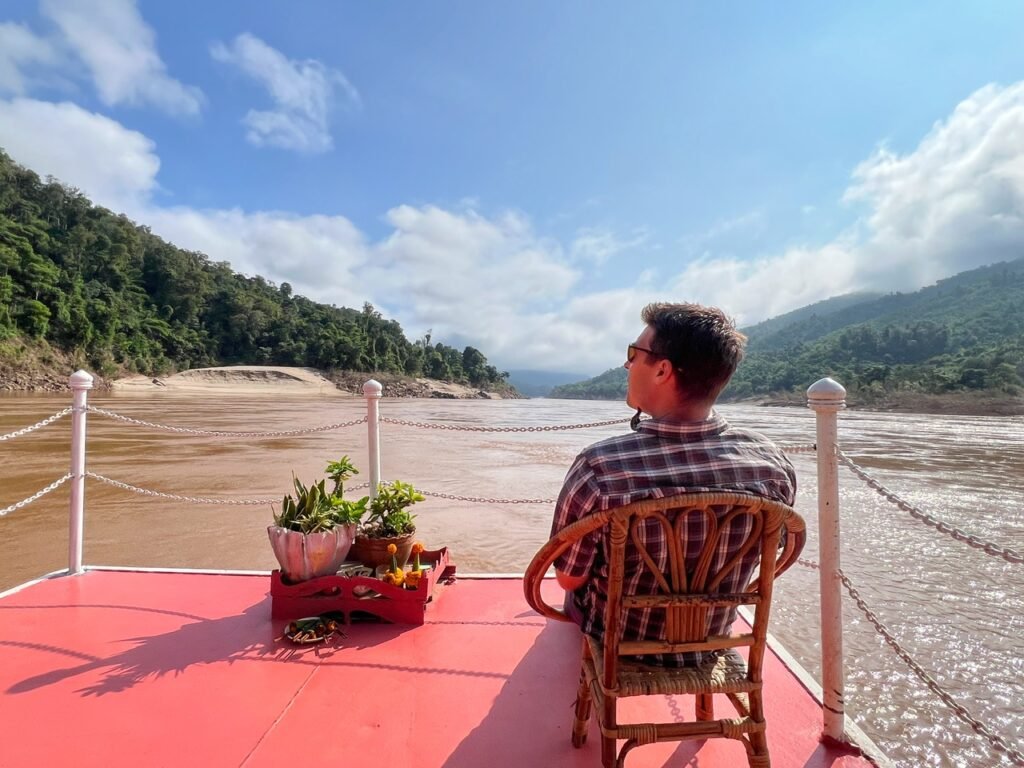
Greg settling in for day two on the long boat. As we headed east, we encountered more and more rapids, rocks and whirlpools. It’s easy to see why the boats only run during the day so they can maneuver in these shallow waters.
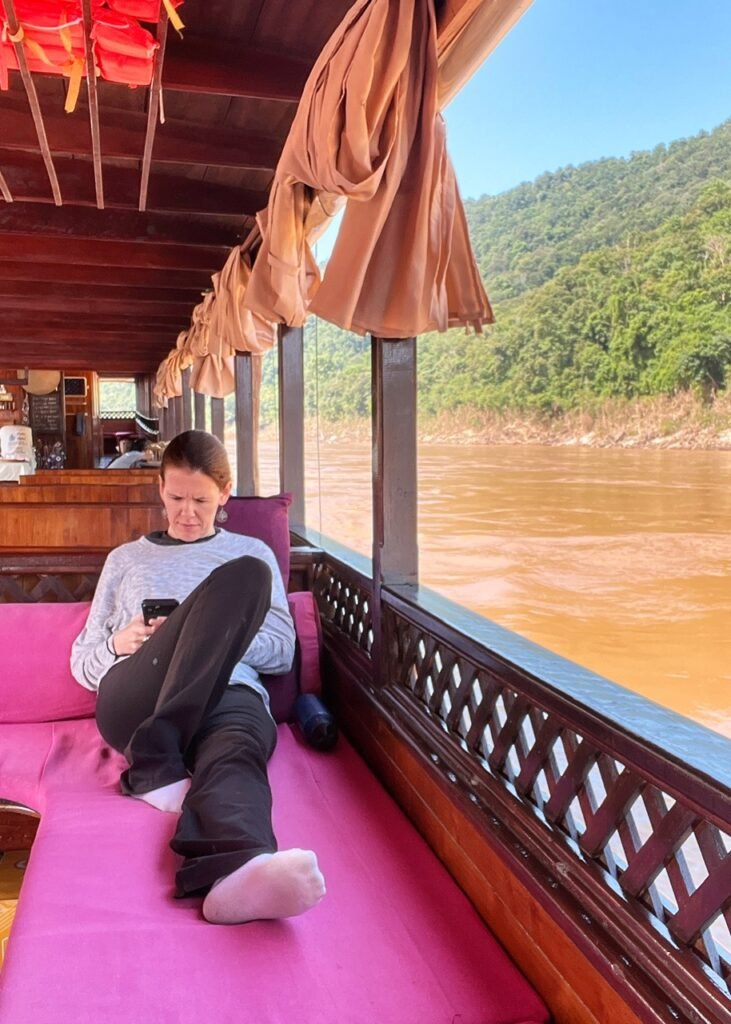
Mandy writing, and apparently scrutinizing by her face, a post for your reading pleasure.
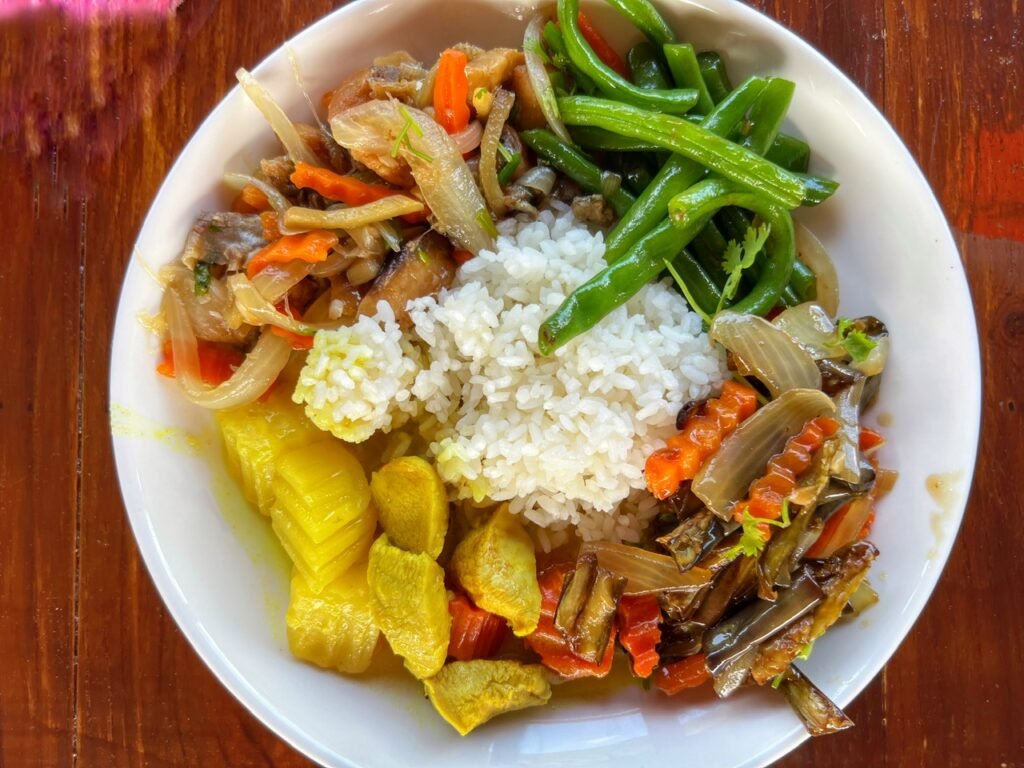
Traditional Laotian lunch on day two…bamboo salad, noodles, and loaded with veggies.
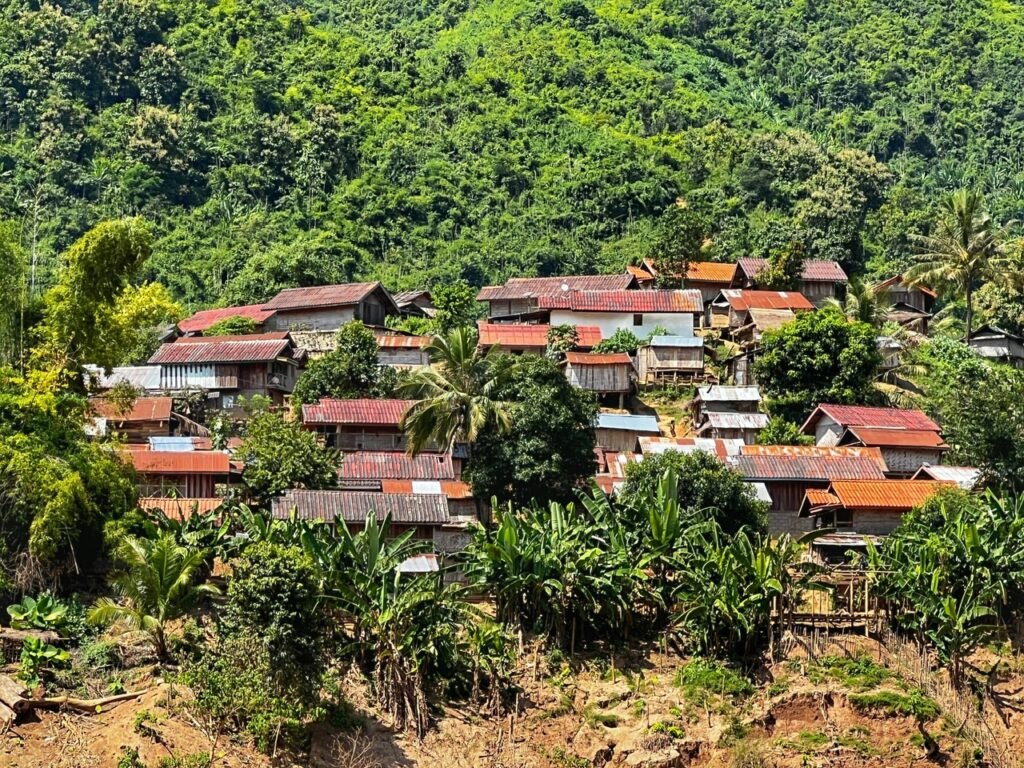
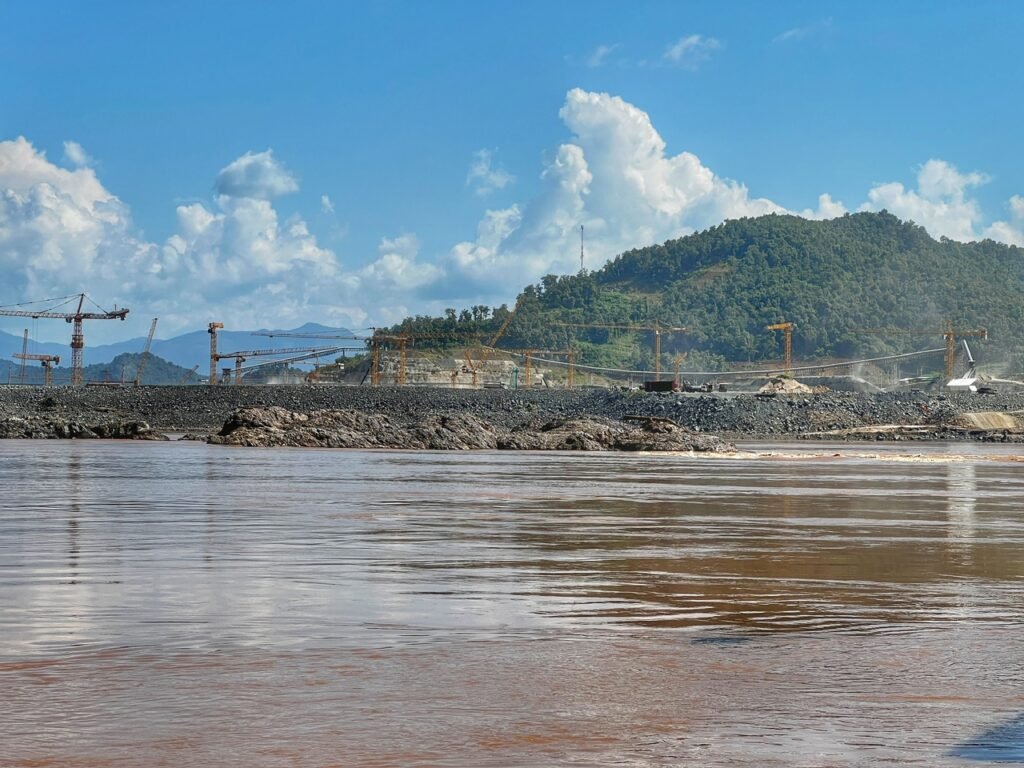
One of scores of riverside villages we passed along the way. We also had our first meeting with a Chinese built dam, which are popping up like wildfires along the river. Although they are good for some things, the locals are not happy because they’re greatly affecting their fish supply and ecosystems.

To lighten the mood, Greg the bug outfitting Grace’s sunglasses. He’s been trying to find a new pair for about three months and she joked he can have hers. Needless to say to say, his narrow face makes finding the right pair difficult.

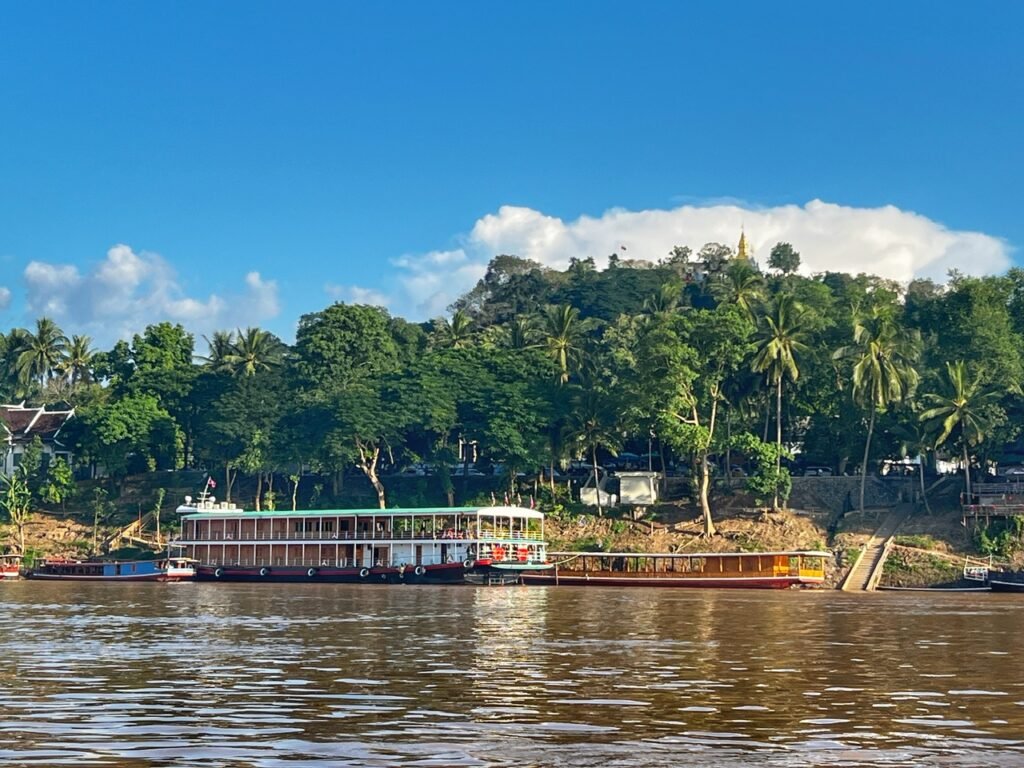
The rocks got more and more jagged as we approached Luang Prabang. And, finally, much too soon, we arrive to the little jewel and our final destination: Luang Prabang.
Pak Ou Caves & Ban Xang Hai
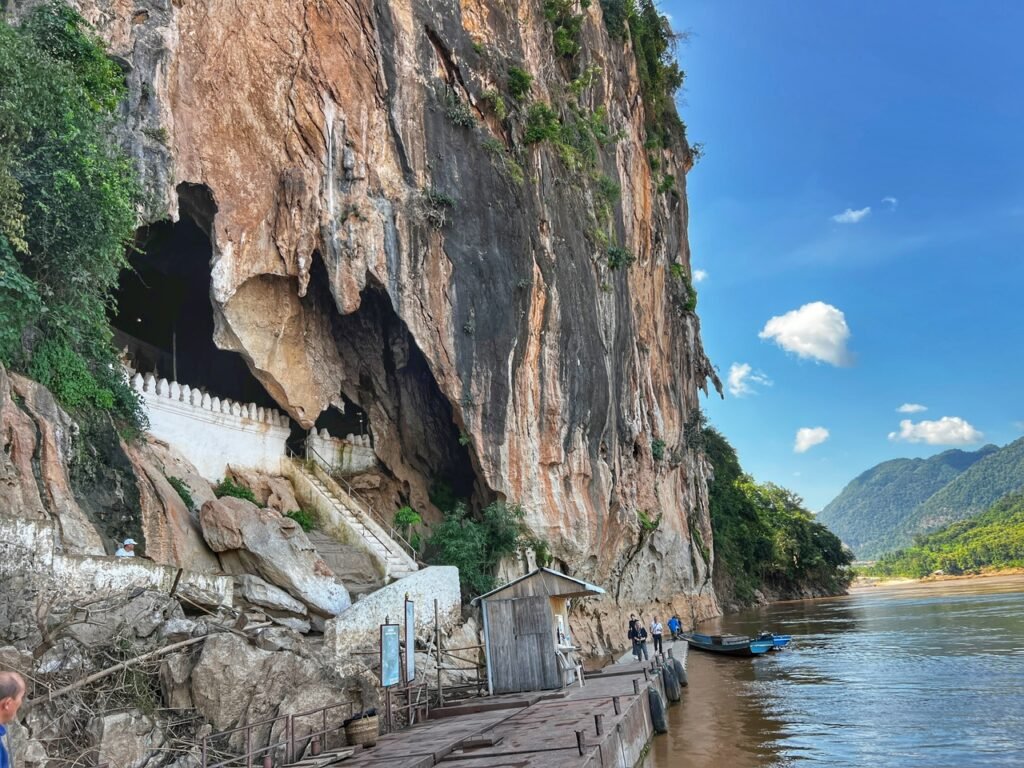
On day two of the Mekong River cruise, we stopped at two sites. The first was Pak Ou Caves, which is a series of beautiful spiritually significant natural caves tucked into the mountainside loaded with more than 4000 beautiful wooden or stone sculptures of Buddha. The second was Ban Xang Hai, which is a village known for its traditional Laotian rice whisky distilleries and hand weaving.
As soon as we arrived at the entrance to the caves, our solitude and bliss from the river was shattered. It was quite evident by the number of boats that these are both popular day trips from Luang Prabang.
It was bizarre to see because only a few weeks before, the river was as high as the third step from the top due to a quite devastating flood, which has fortunately receded. The cost to enter was 30,000 Kip or $1.36 which was included in our cruise.
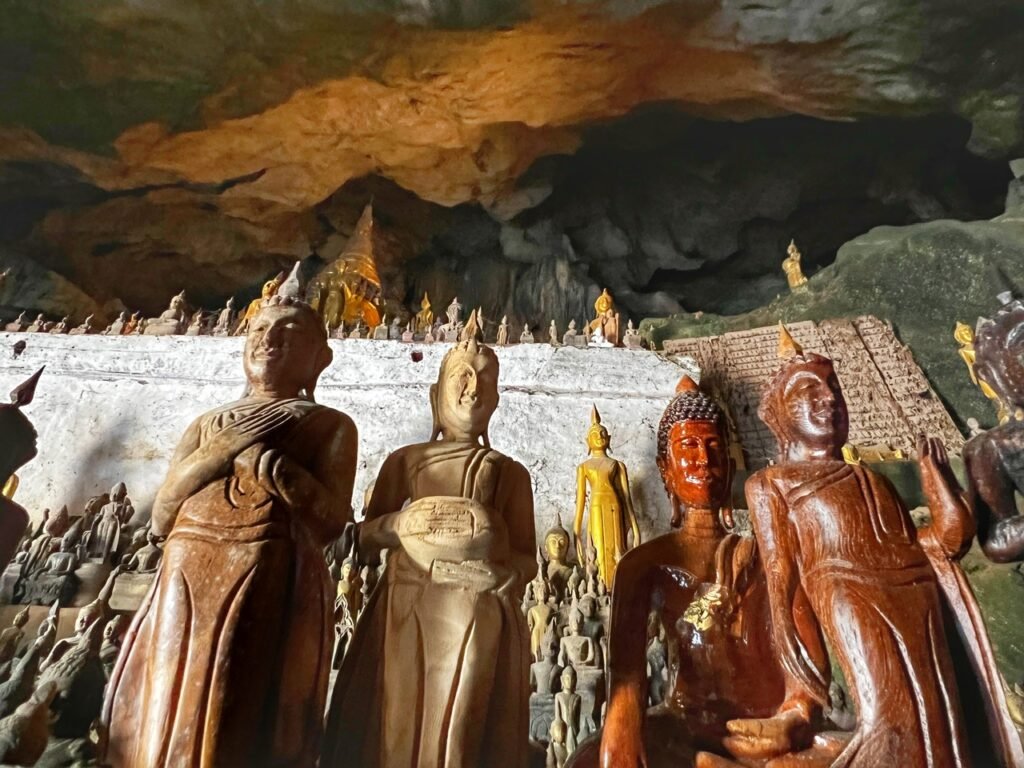
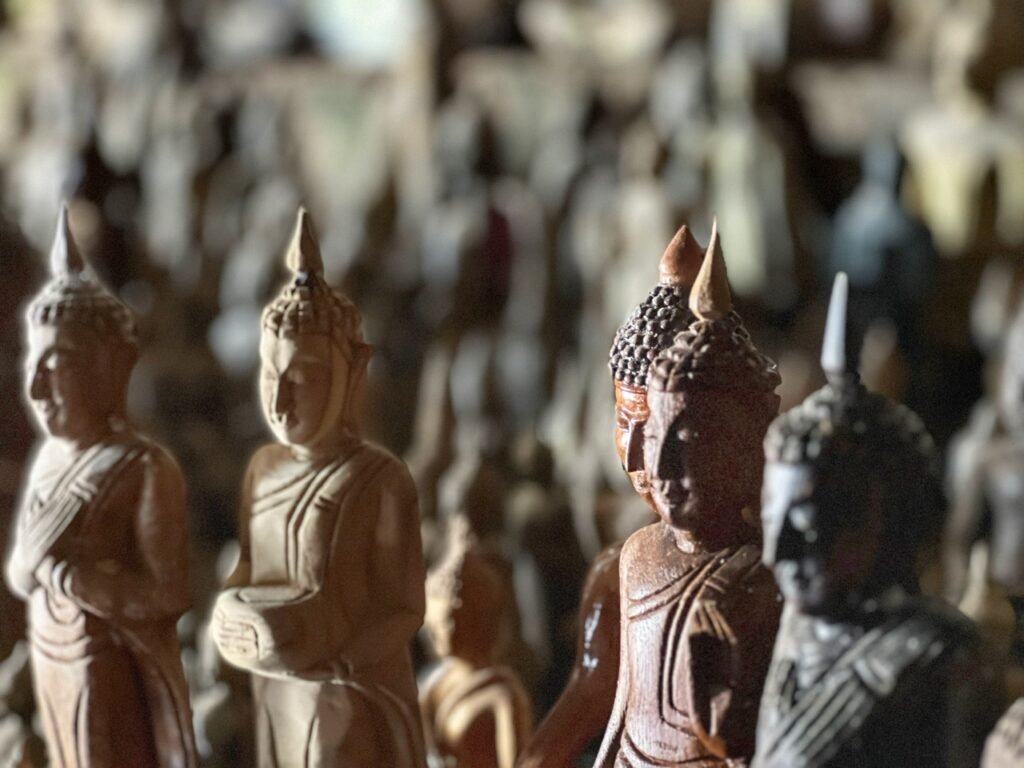
Pak Ou Caves is divided into upper and lower caves called Tham Ting and Tham Theung. The upper requires a great workout to ascend, however, it is all concrete and easy to maneuver steps.
It is believed that the Lao people first entered the river valley in the middle of the eight century after moving southward from south China. The first use of the caves for religious purposes was at the time when the local population worshipped Phi, or the spirits of nature. It is said that the caves are associated with a river spirit.
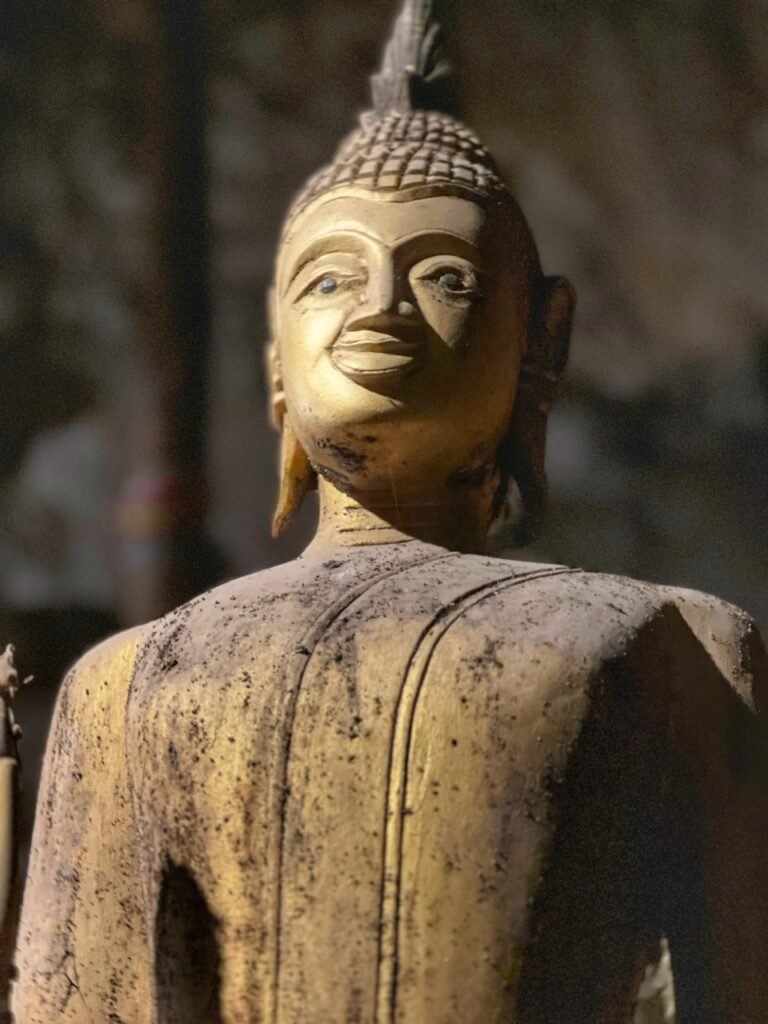

It was not until considerably later that Buddhism first spread into the area from the west. By the 16th century Buddhism had been adopted by the royal families of Lao and the caves received patronage from that time until 1975.
According to reliable people, (says the sign), this cave was once a residence of an ancient Buddha and then local people made more Buddha statues to honor the customs and beliefs of the locals. Some of them, as you can see, are aged beyond their years. From the 18th century until the mid 20th century, at New Year’s the king and local people pour water on the Buddha statues.
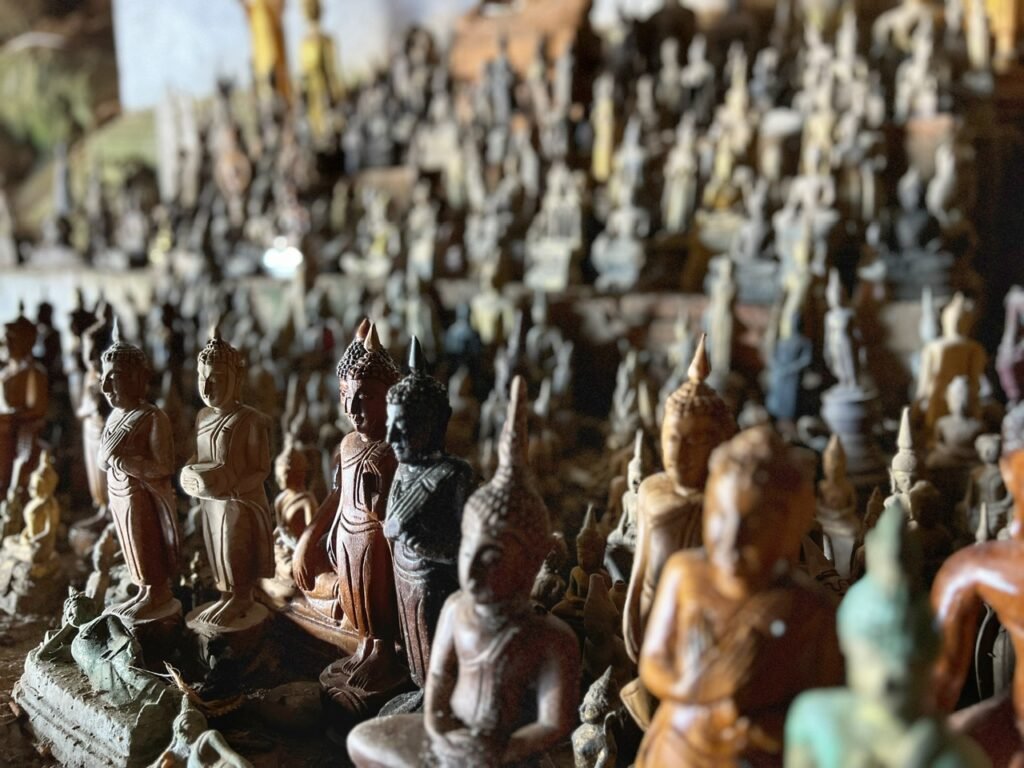
All the Buddhas were brought at some point as offerings. Some of them are more than 1.5 meters tall while others are no larger than 10 centimeters in height. Surprisingly there is no “Big Buddha” like so many other religious sites we encounter. It reminded us a big of Magic Mountain in DaNang, but of course it was much more authentic than Buddha Disney.
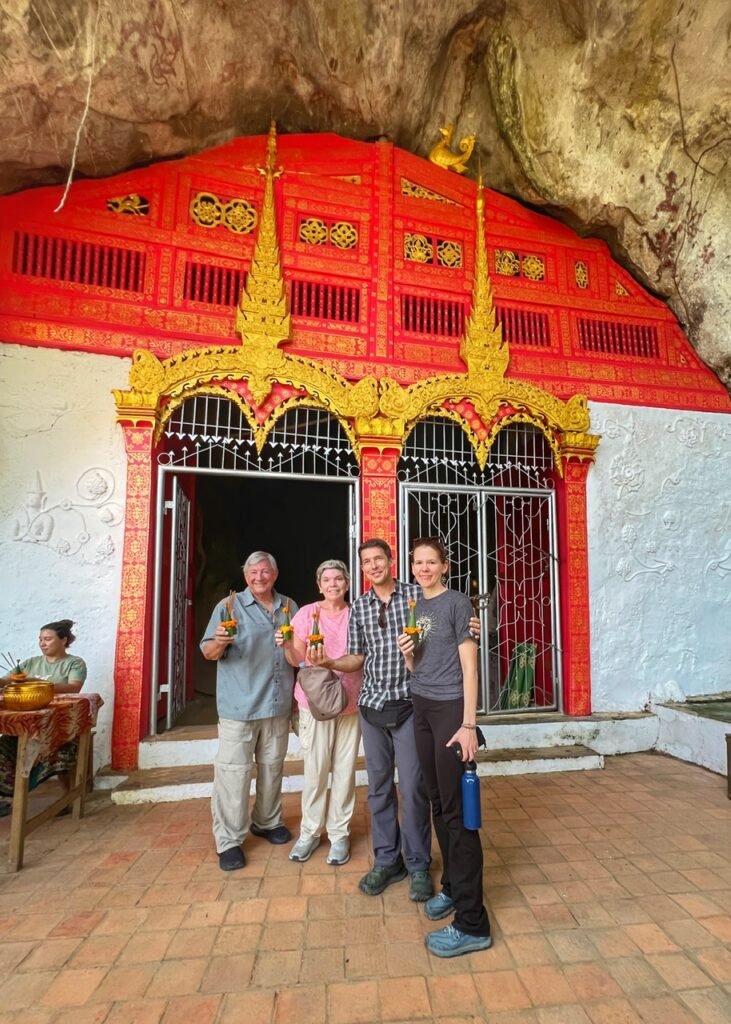
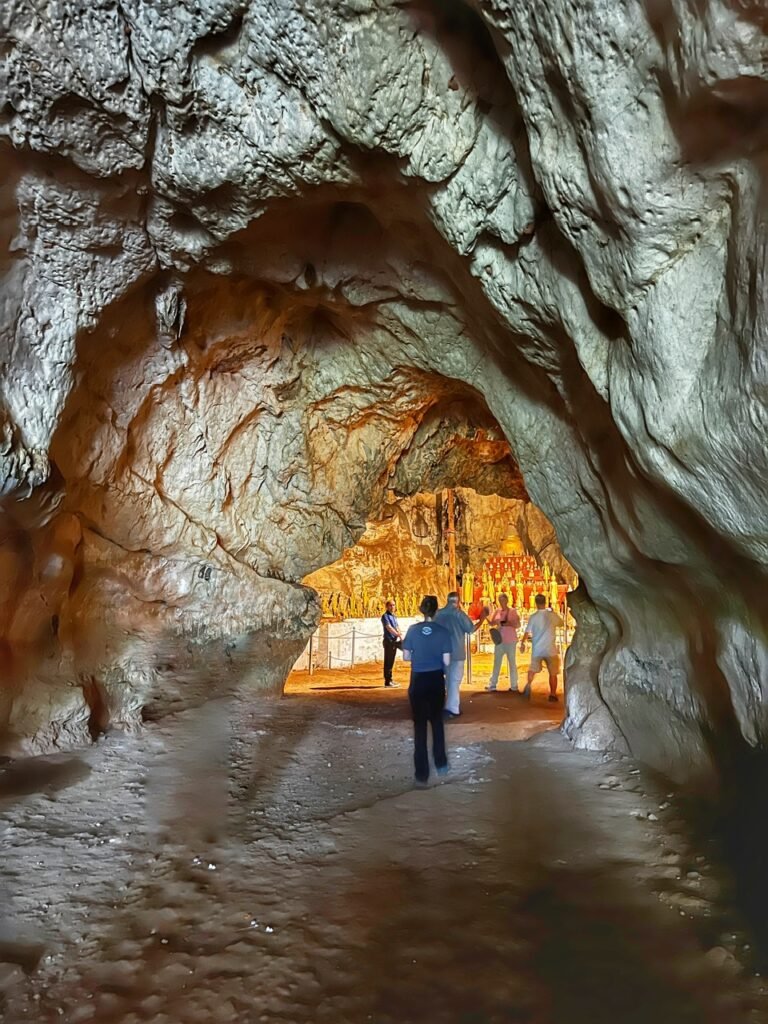
At the top of the cave, we were given the opportunity to buy floral offerings to give to Buddha near a quite brilliant red wooden frieze. Mandy entering into the upper cave.

Inside, we gave our offerings to Buddha and had a moment of silence for a prayer.
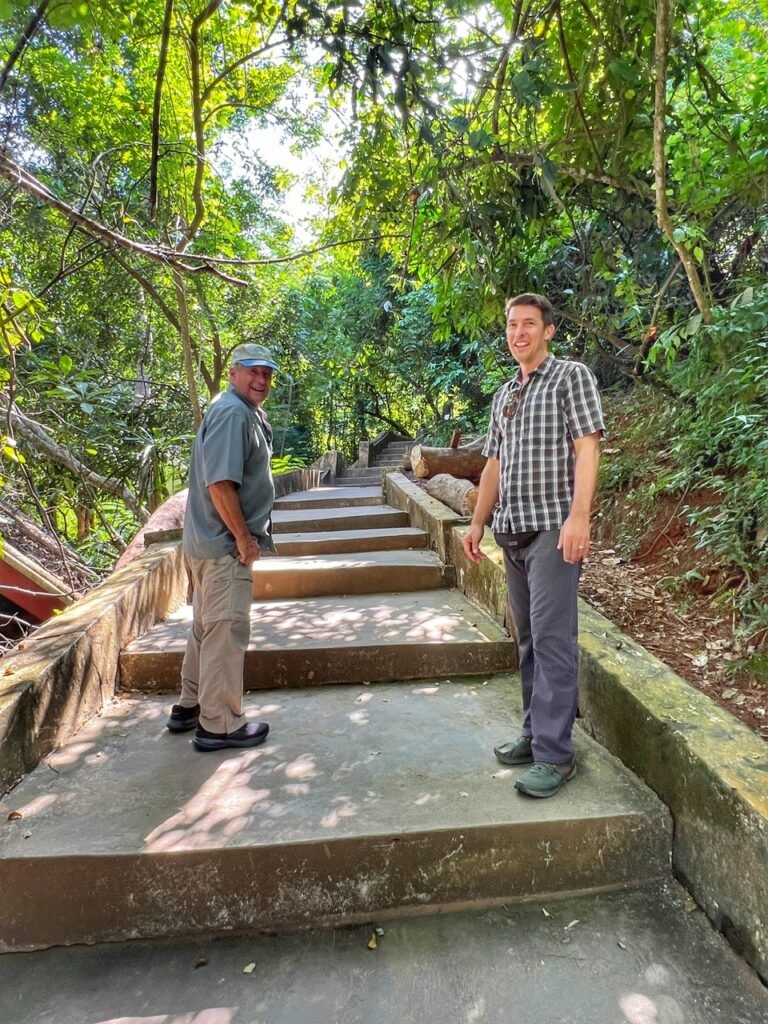

Heading back down the long set of stairs from the upper cave.

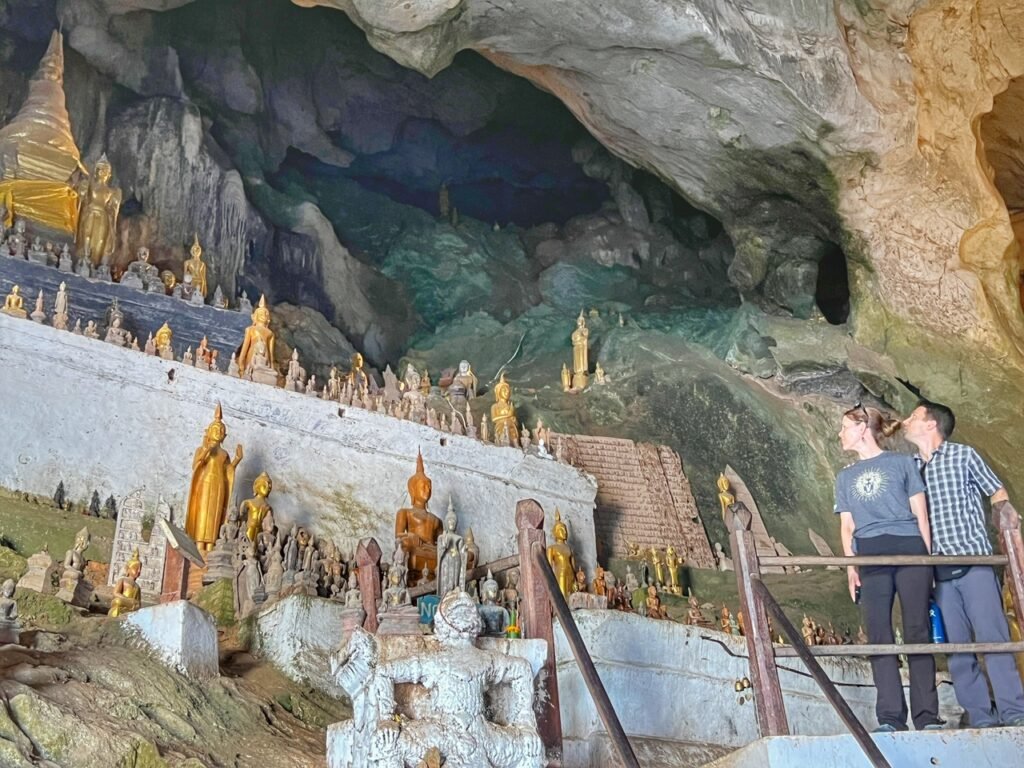
The lower cave is more atmospheric because it receives more natural light which illuminates the statues and is definitely worth a visit!
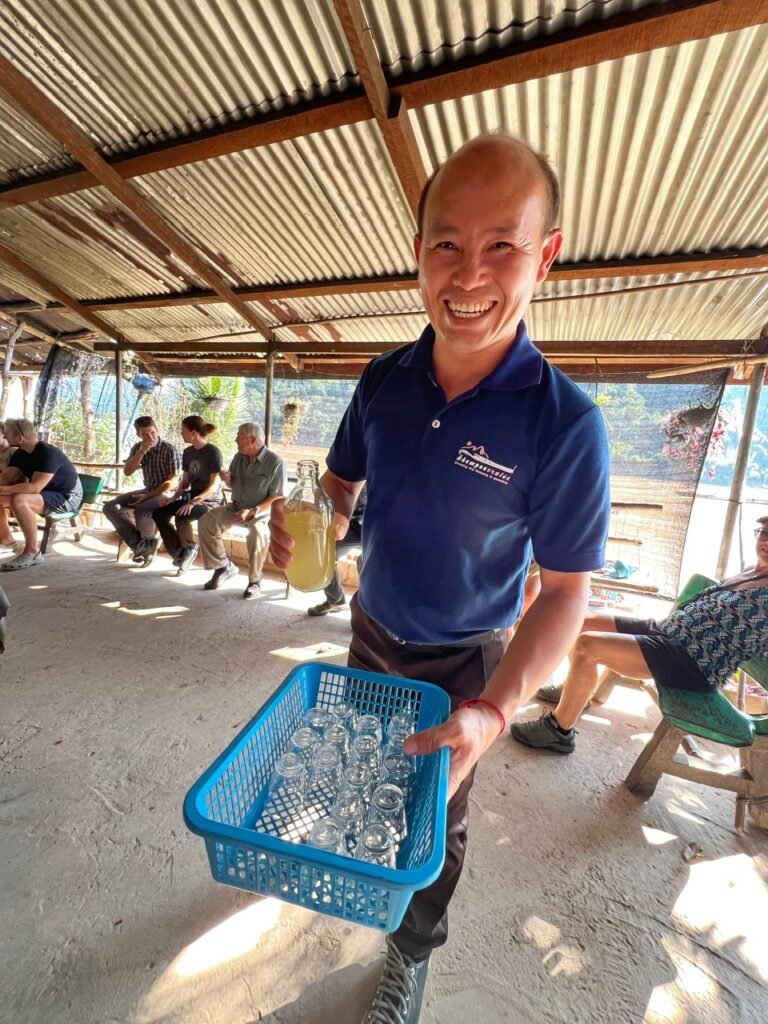
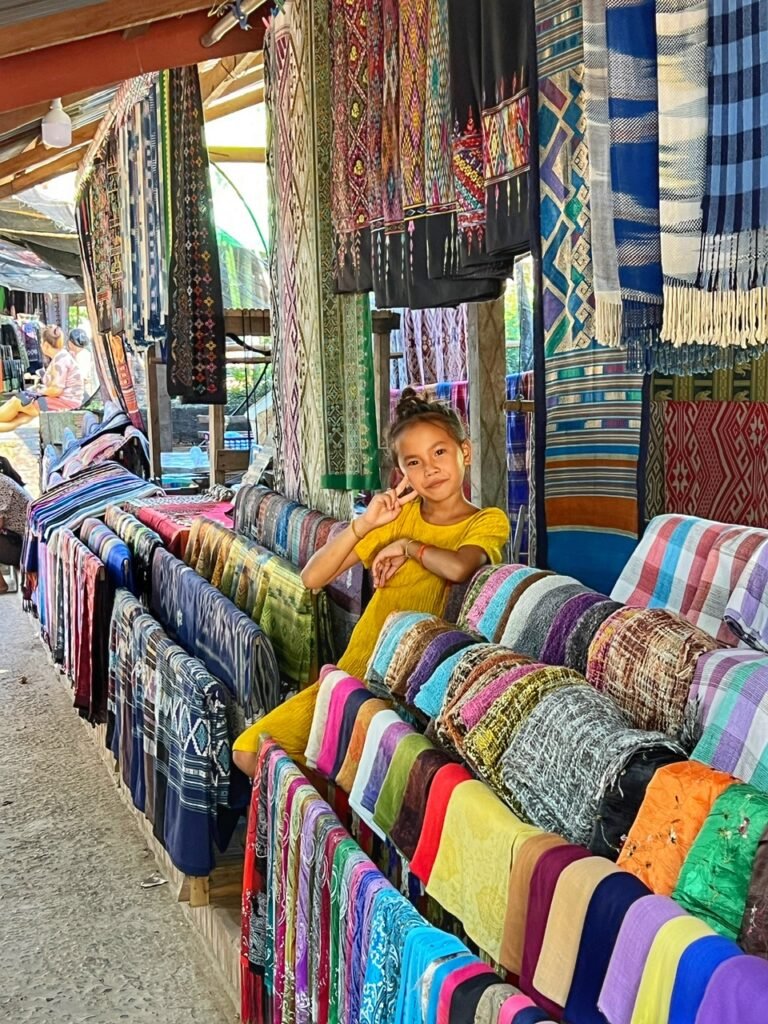
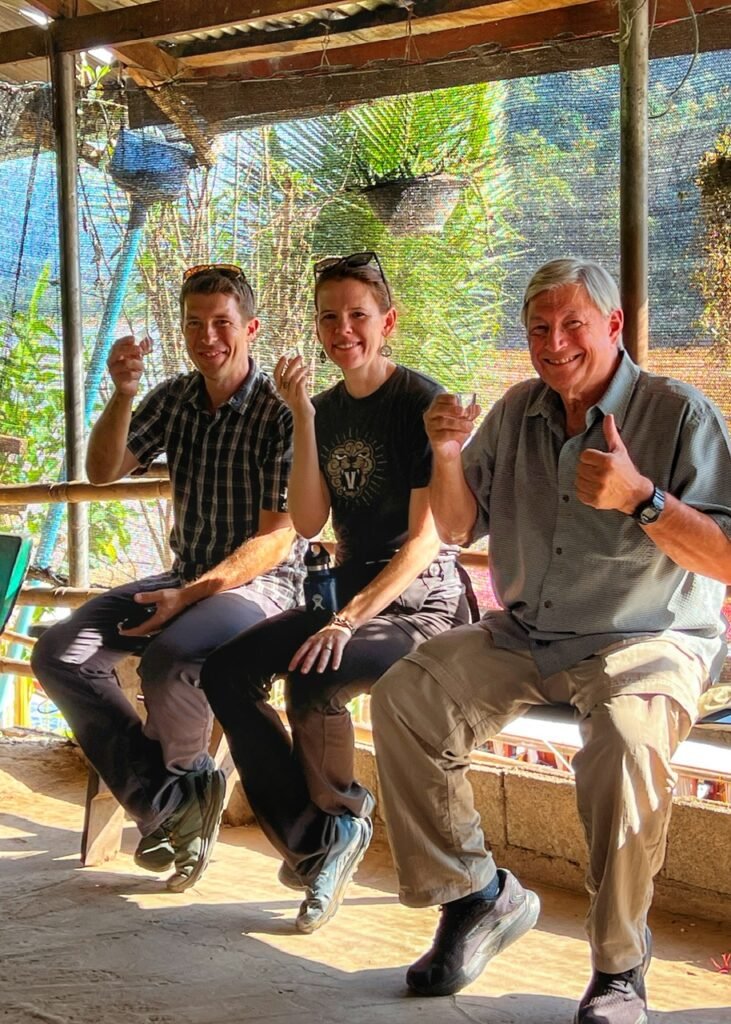
The second stop at the whiskey village called Ban Xang Hai, is not surprisingly, also on the tourist route. (Because everyone needs a shot after climbing a 100+ stairs). In addition to the alcohol, it’s a perfect place to buy a handmade scarf or textiles.
Cha, our guide, handing us our shot glasses. It’s Lao-Lao time!
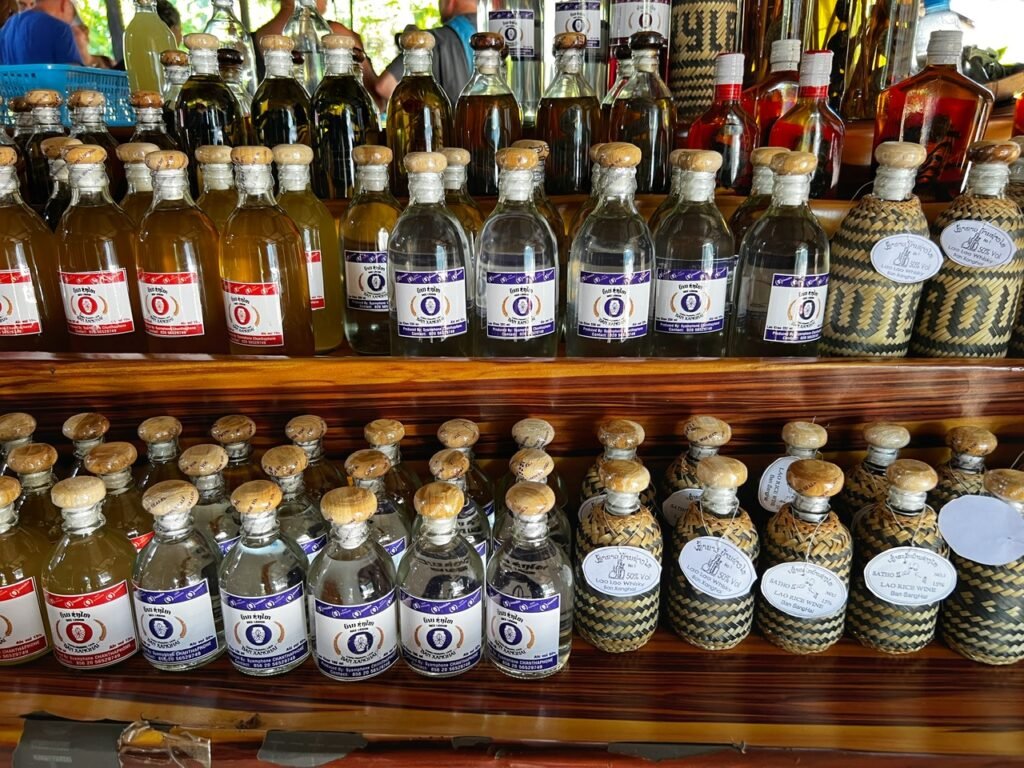
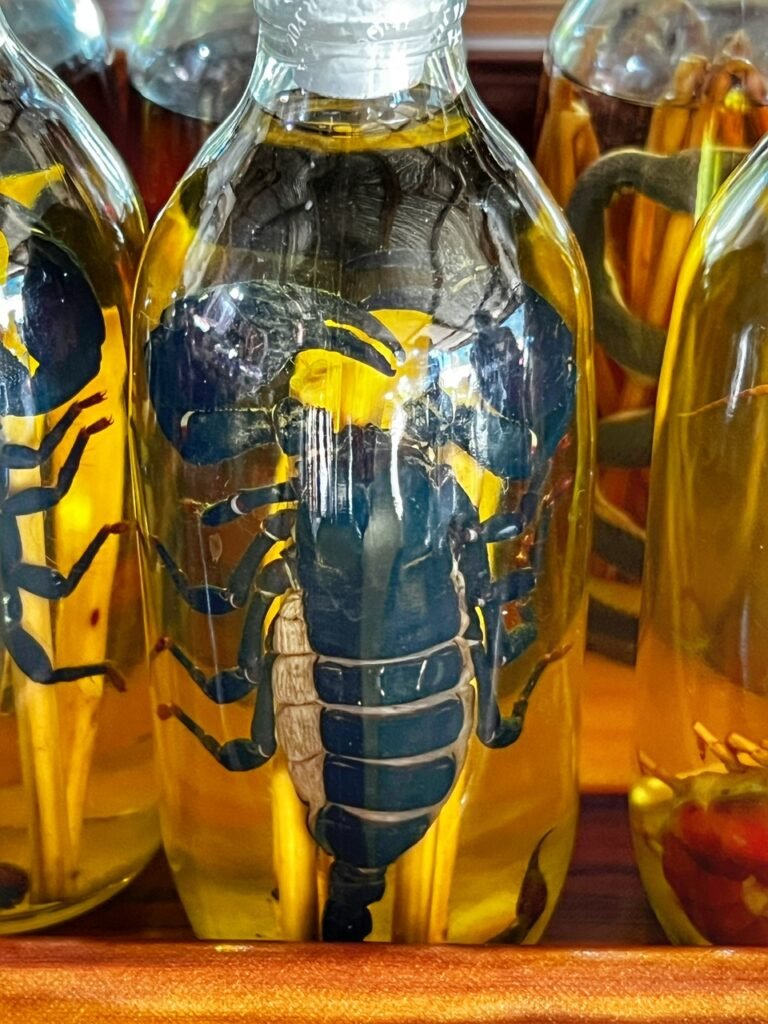
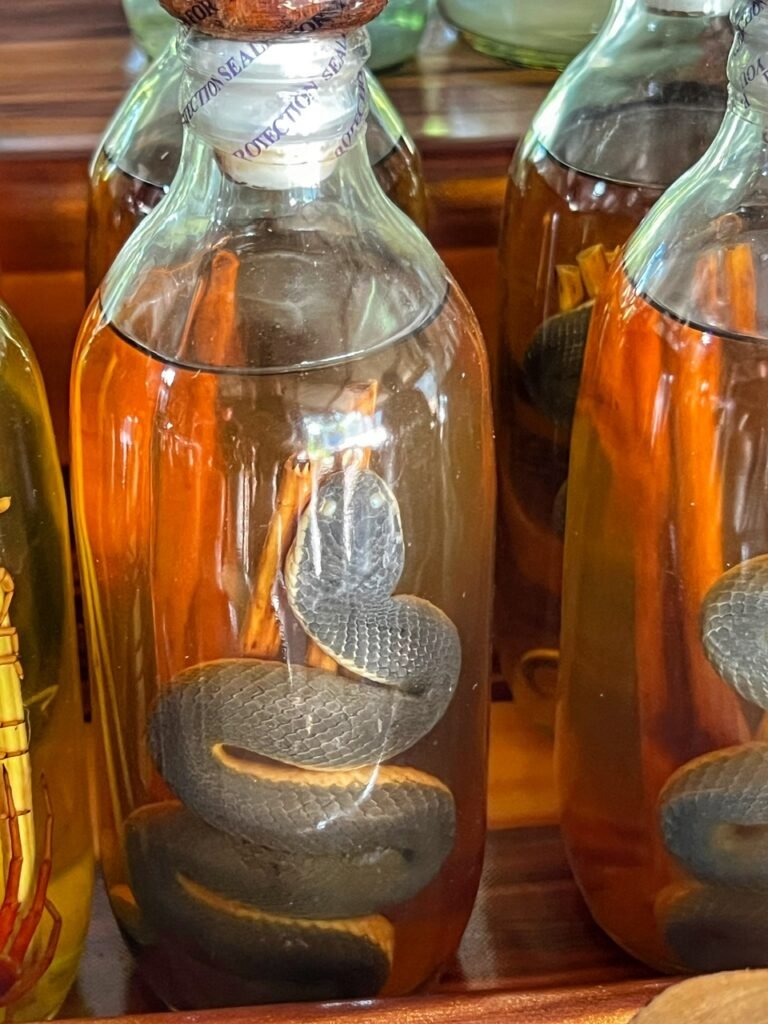
Lao-Lao is the official name for traditional rice whiskey. The villagers follow a time-honored distillation process that involves fermenting black and white sticky rice, distilling it in clay jars and then bottling it. We got three samples from weak to quite strong, and ended up walking out with a $2.27 average sized bottle of the average strength whisky. Guess we were just feeling average that day…
Of course, we could have walked out with the not-so-average bottles which are infused with herbs and preserved with creatures like scorpions, and snakes which are believe to give the drink medicinal qualities. Um. No. Seriously, how do you even get it in there like that?!
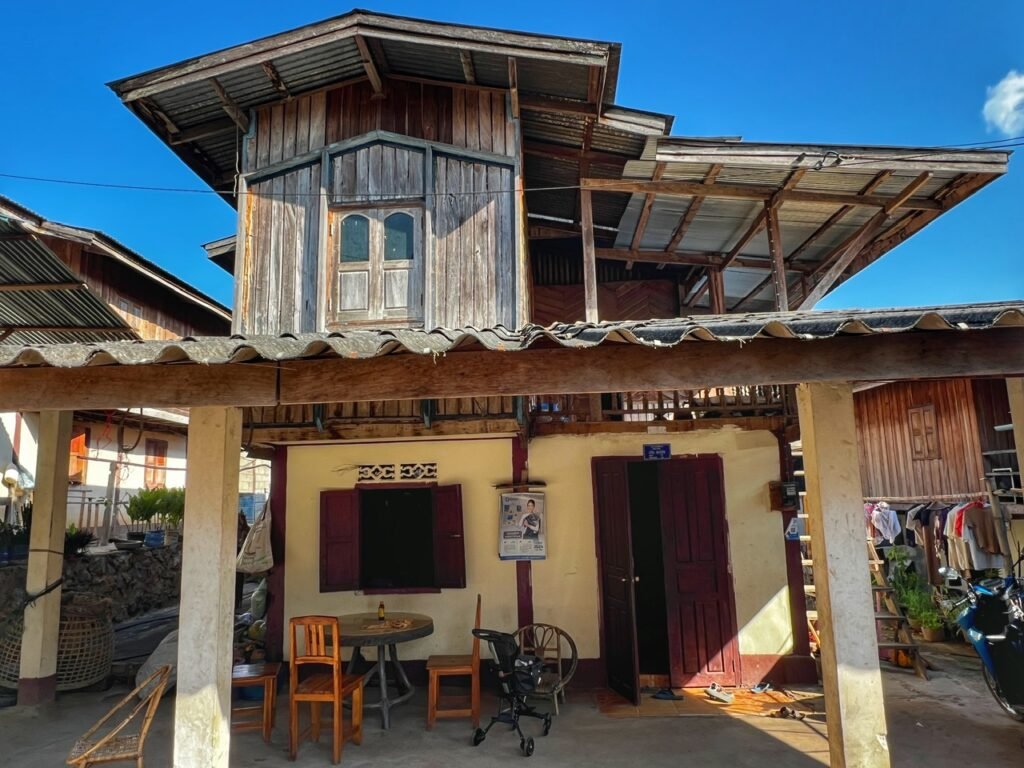
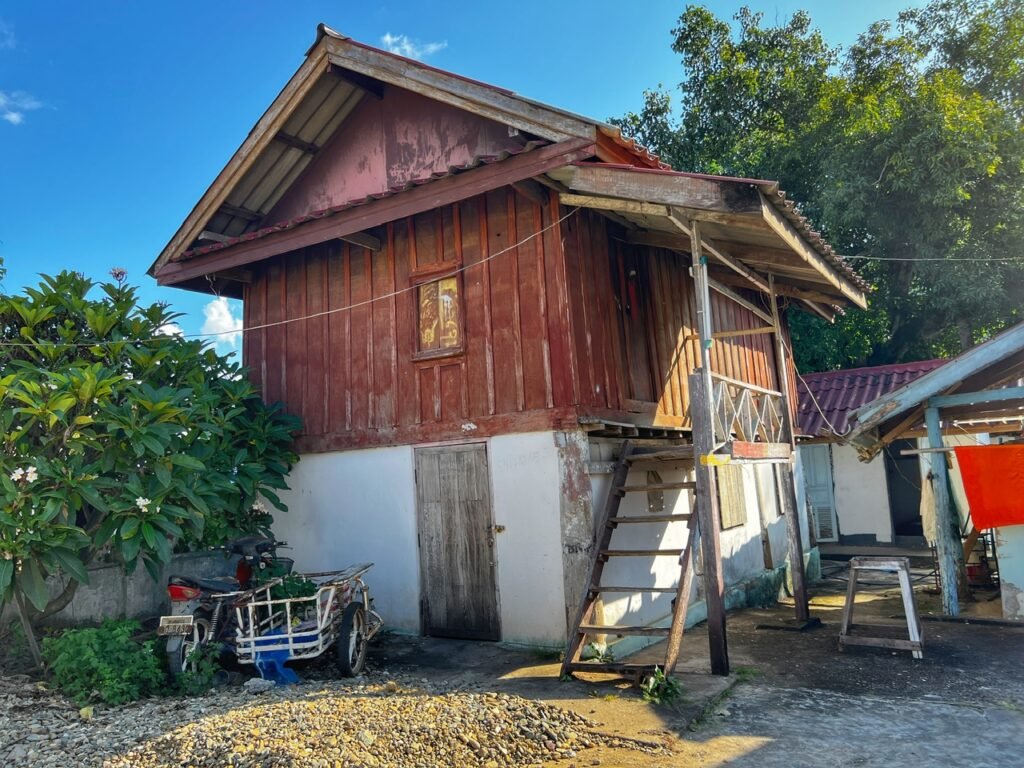
After this, we had a little time to do a walk in the village, where we discovered Laotian houses, some of which bizarrely Ottoman, while others looked more barn-ish.

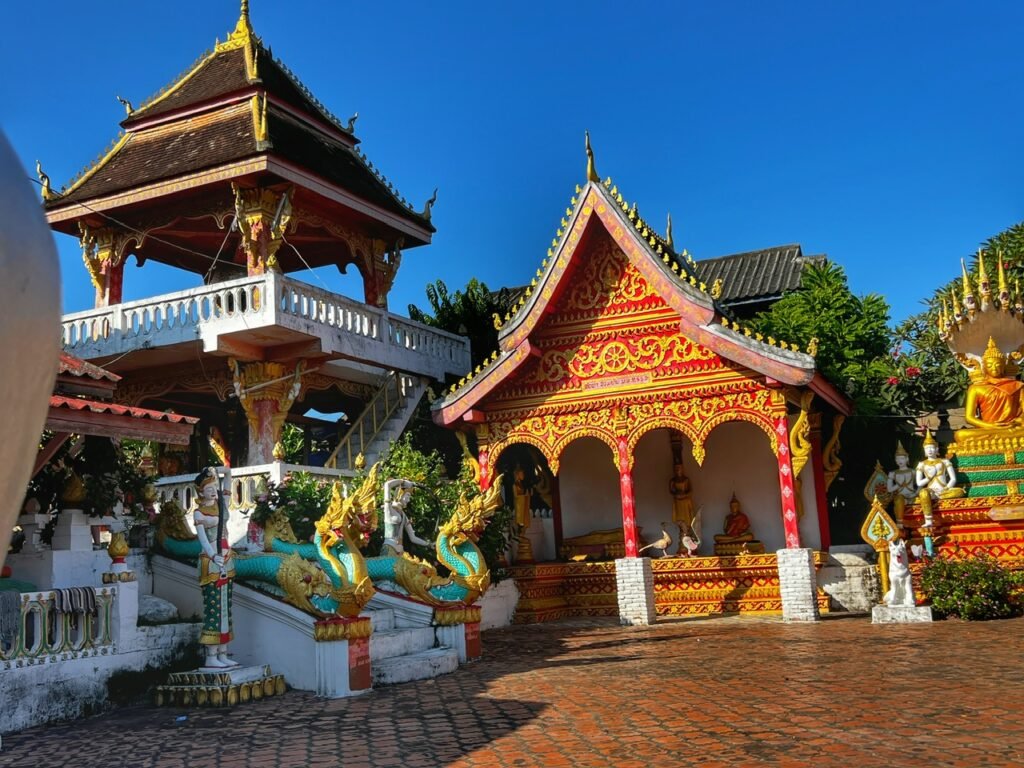
Visiting the village’s temple, which featured a life-size elephant statue fit for a king, and a lot of brilliant pops of color!

